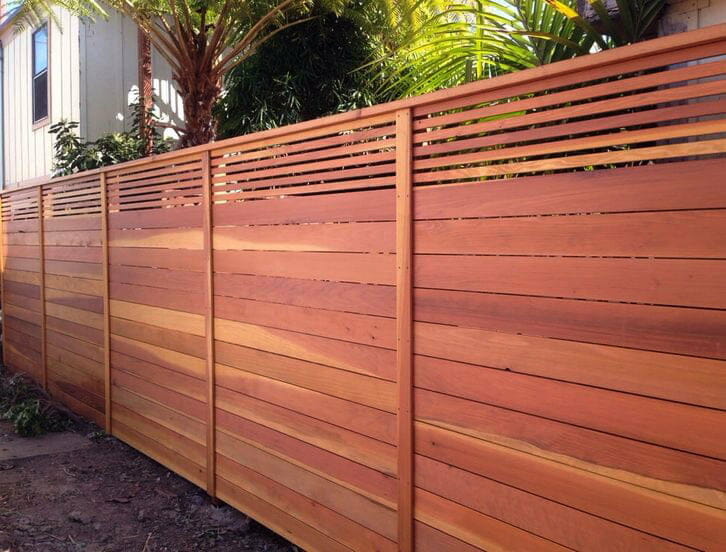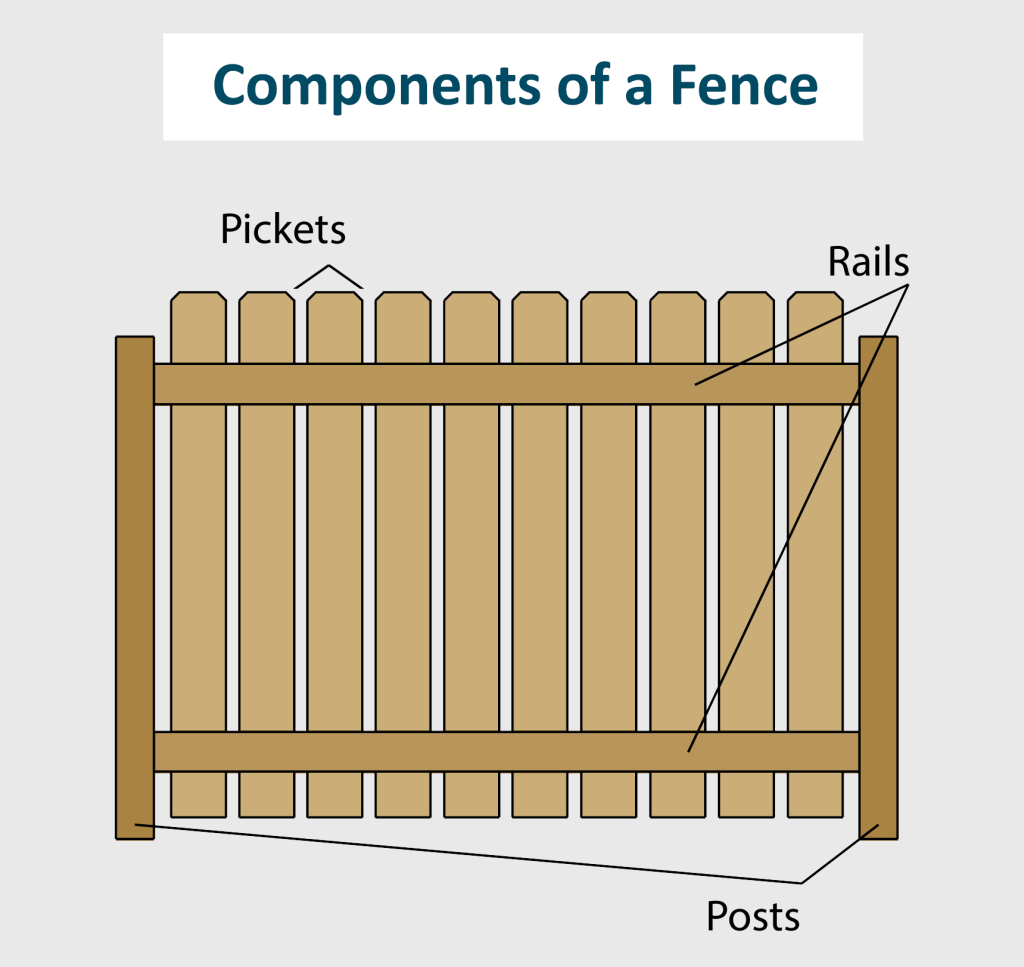
A wood fence is a classic option for many homes, celebrated for its versatility and its ability to provide privacy, security, and aesthetic enhancement to outdoor spaces. Although there is a wide range of styles accessible, every wood fence features the same essential components.
The main parts of a wood fence include the posts, rails, gates, caps, and other accessories that help keep it secure, safe, and reliable.
By knowing its various components, you will be able to appreciate and understand more of its craftsmanship and functionality. From posts and rails to panels and caps, each component plays an essential role in the functionality of a wood fence.
What are the parts of a wood fence?
There are many components to a wood fence, and the main components work together to create the sturdiness and attractive structure of the fence. Here are the key components of a wood fence:
Posts
Posts are vertical structures that provide crucial support and stability to the fence. They are typically made of wood and installed at regular intervals along the fence line.
Properly anchored posts ensure the fence remains upright and resilient against external forces.
Rails
Rails are horizontal pieces of wood that run between the posts, serving as the framework of the fence. They provide stability and support to the overall structure.
Rails are often attached to the posts in a parallel arrangement, creating a sturdy foundation for the fence.
Pickets
Pickets are the vertical boards that are attached to the rails, forming the visible part of the fence. They are usually made of wood and are placed close together or with small gaps, depending on the desired style and level of privacy.
Picket fences not only enhance the aesthetic value of the fence but also provide a measure of security and containment.
Gate
A gate is an essential component of a wood fence, allowing entry and exit points. It consists of a frame, typically made of wood, with pickets or panels. Hinges enable the gate to swing open and closed, while a latch or lock mechanism ensures security.
Gates can be customized to match the overall design of the fence and serve as a focal point for the entrance.
Caps and finials
Caps and finials are decorative elements that add a finishing touch to the wood fence. Post caps are placed on top of the fence posts, providing protection against moisture and adding visual appeal.
Finials, on the other hand, can be ornamental accents placed on top of pickets or posts, enhancing the overall aesthetic and giving the fence a distinctive look.
Hardware
Various hardware components play a vital role in assembling and securing the wood fence. These include screws, nails, brackets, hinges, latches, and other fasteners that hold the different parts together.
Choosing appropriate and durable hardware is crucial for ensuring the longevity and strength of the fence.
What are the other components of a wood fence?
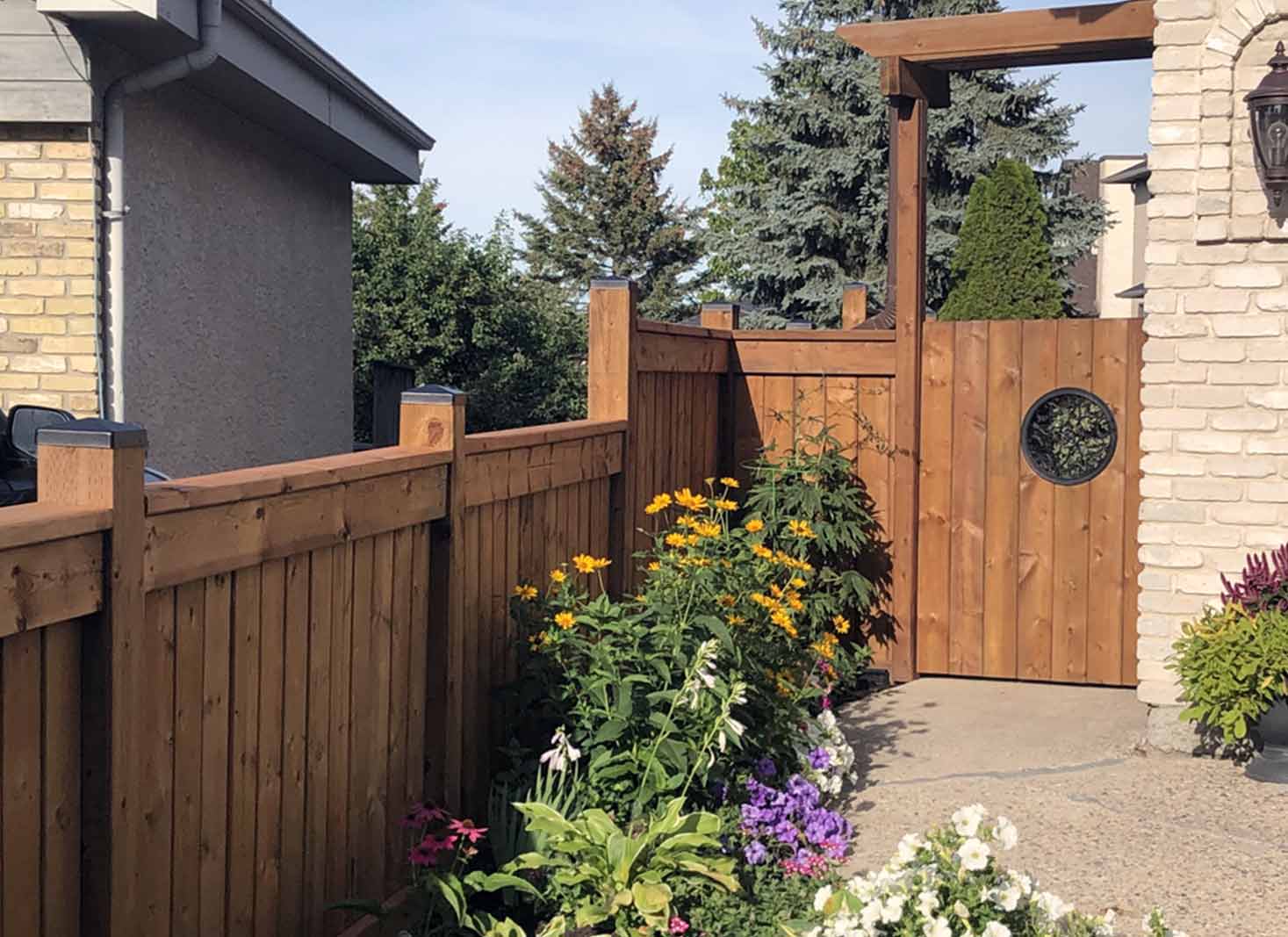
While the main components complete a wood fence’s functionality, there are still other components that are noteworthy. You can incorporate these components to enhance your fence, depending on your needs and preferences.
Corner braces
Corner braces are diagonal supports installed at the corners of the fence. They provide extra stability and prevent leaning over time. By reinforcing the fence’s structural integrity, corner braces ensure a longer lifespan and improved durability.
Stringers
Stringers, also known as horizontal support boards, are additional horizontal pieces of wood installed between the posts. They provide extra reinforcement, particularly for taller fences or areas with high wind loads.
Stringers enhance the overall strength and stability of the fence structure.
Kickboards
Kickboards, also referred to as rot boards or baseboards, are horizontal boards placed at the bottom of the fence, between the ground and the first rail.
They offer protection against soil, moisture, and potential damage caused by lawnmowers or other activities. Kickboards can significantly extend the life of the fence by shielding it from ground-level deterioration.
Backer rails
Backer rails are horizontal boards attached to the backside of the fence, opposite the pickets. They provide additional reinforcement and support to the fence structure, especially for wider panels or areas prone to strong winds. Backer rails contribute to the overall stability and longevity of the fence.
Trellis or lattice panels
For those seeking added aesthetic appeal and functionality, trellis or lattice panels can be incorporated into a wood fence. These decorative components are often placed at the top of the fence or in specific sections.
This will allow climbing plants to grow and provide a touch of elegance to the overall design.
Post caps
Post caps, while also being a main component, also fall into the category of additional details. This is because they are decorative elements that are placed on top of the fence posts.
They serve as an ornamental feature while protecting the wood from moisture and weather. Post caps come in many different materials and designs which allows property owners to personalize the appearance of their fence.
What is a wood fence good for?
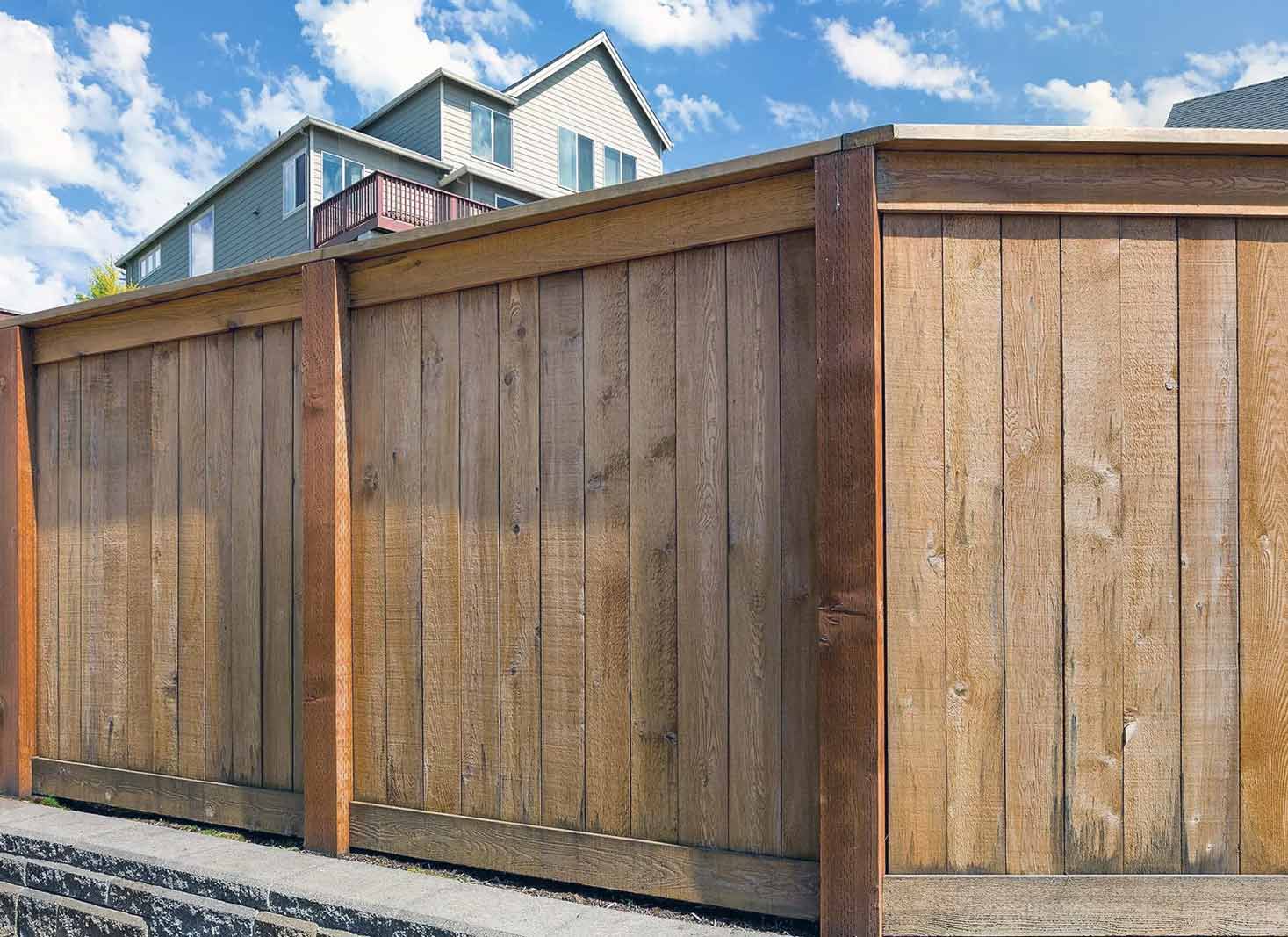
A wood fence offers several benefits, making it a popular choice among homeowners to enhance their outdoor spaces. It offers privacy, security, aesthetic appeal, and customization options. Here are their main advantages:
Privacy
Wood fences provide privacy, creating a secure and secluded space for homeowners to enjoy their outdoor areas without prying eyes. The tight placement of pickets and the height of the fence contribute to a sense of privacy and intimacy.
Security
Wood fences serve as a physical barrier to deter unauthorized entry and enhance the security of a property. With a sturdy construction and a properly installed gate, a wood fence can provide peace of mind and protection against intruders.
Aesthetic appeal
The natural beauty and versatility of wood make this type of fence an attractive choice for many homeowners. Wood fences can complement different architectural styles and landscaping designs.
They add warmth and charm to the overall aesthetic of a property.
Customization
Wood fences offer many opportunities for customization. Homeowners can choose from different species of wood, stains, and finishes to achieve their desired look.
With various design options available, it is possible to create a unique fence that reflects the style and preferences of the homeowners.
When buying a property that already has a fence, it might not seem like a big deal, especially if the fence is doing its job well. But when you’re building a new house or need to replace an existing fence, choosing the right kind becomes very important.
The purpose of the fence is primary; aesthetics, security and providing privacy. Corrugated metal is an excellent choice for building a fence, but so is wood. If you are torn between the two materials, this article is a comparison to help you make an informed choice.
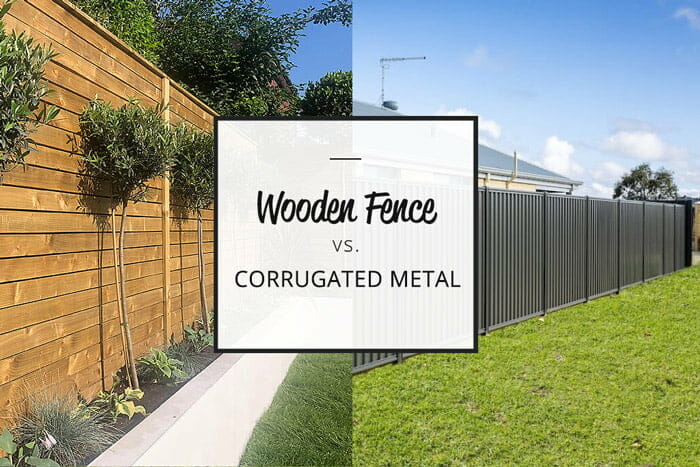
Comparison Between Corrugated Metal Fence and Wood Fence
The following are crucial points when comparing a corrugated metal fence and a wood fence:
Installation
Corrugated metal may be difficult to install if you are DIYer. For trained hands, it may not be so much work, but if you are using a professional, it means you have to pay for the services. The metal can also be dangerous; wrongly handling it may cause severe injuries. This is true even if there are pre-assembled options for fences.
Wood, on the other hand, is simpler and easier to install than corrugated metal. You can even follow instructions to do the installation yourself as a DIYer if necessary. This depends on the fence’s size and weight; you may need extra hands for the job. However, note that wood tends to shrink slightly after installing it, and it can create unwanted gaps in the fence.
Performance
Corrugated metal sheets perform better than wood. If you use corrugated metal sheets for your fence, you do not have to worry about deterioration or rot if you use corrugated metal sheets for your fence. Also, there is no danger of termites or other pests eating them, and they do not warp.
Corrugated metal is stronger than wood and can withstand more pressure if necessary. It will take years before you have to replace a fence made of corrugated metal; it can last up to 40 years.
A wood fence is not a great performer when it comes to rot and deterioration. It quickly gives in to moisture and wears out easily, especially with a lack of maintenance. It is also prone to warping when there are extreme weather changes.
While it may last years with excellent care, it may eventually give in to moisture absorption, termite infestation, and extreme warping. Treated timber may be an ideal option for a fence.
Aesthetics
There are various aspects of aesthetics to consider. One is how much the material allows you to design it. Two are the customization options, and three are staining and painting.
Corrugated metal is restrictive in the aspect of design. Yes, you can get creative with paint colors and drawing designs, but you can only do so much, especially if the property is commercial. Also, you are limited in your customization options with metal. For example, you cannot trim the fence if it becomes higher than desired.
The options are endless for wood when it comes to aesthetics. In fact, many property owners prefer wood because of its flexibility. You can always trim, change the design, customize, and do a variety of other things to a wood fence. Staining or painting it may even reduce the potential damage from UV rays due to extended exposure.
Eco-friendliness
Corrugated metal is not as easily disposable as wood. Correctly disposing of metal may mean taking it to a recycling plant, which may not always be convenient, especially if there are many sheets to discard. The fence may even pose a danger if the metal is damaged with uncovered and sharp edges.
Wood performs better in this aspect. Although it is more prone to rotting and damage, there are ways to ensure it lasts longer. Moreover, it is easier to dispose of it without necessarily needing a recycling plant or causing harm to the environment.
Maintenance
In terms of maintenance, corrugated metal fences are better than wood fences. Corrugated metal needs only minimal attention while giving optimum performance. Due to its lack of staining or painting, there is typically no need to refinish it every couple of years. Besides, you can find options that do not easily give in to rust due to a powder coating.
Wood needs more time and effort to maintain. A lack of attention may cause it to deteriorate quickly; you will need to service it regularly to keep it in top shape. Staining and painting mean you have to sand, prime, and refinish the wood every couple of years, which is tedious. This is especially true if there is a large area to handle.
Benefits of using a corrugated metal fence
Several benefits accrue to using corrugated metal to build a fence around your property. Let us take a look at some of them:
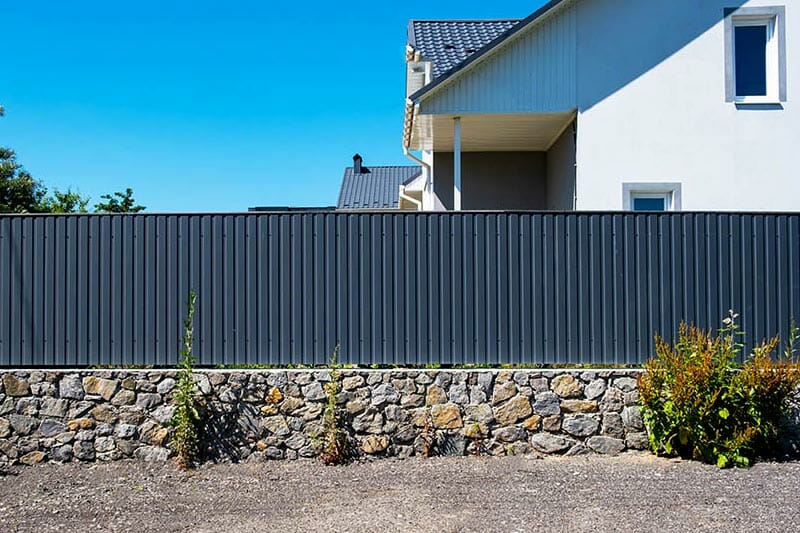
Long lifespan
Corrugated metal typically has a long lifespan, between 25 and 75 years. If you choose to use an entry-level type of this metal for fencing, you may get up to 30 years, depending on usage and maintenance.
This type is not thick, so it may not withstand the rigors of the elements. Options with medium thickness can last between 30 and 40 years, while those with maximum thickness can last up to 75 years.
Minimal maintenance
As explained before, a corrugated metal fence does not need as much attention as a wooden fence. You will not have to stain or paint or even apply a water-resistant sealant to prevent moisture penetration. The landscape where you may want to use the metal sheets may be sloppy, which reduces the work needed to prepare for installation.
Ideal investment
Since there is not much in the way of maintenance and the sheets tend to last for decades, it is an investment to use corrugated metal for your fencing needs. Some materials come prepared to withstand rusting and other possible issues. So, you may even get more use out of them if you remove them as a fence. Besides, there are recyclable corrugated metal sheets to divert to other uses in the future.
Excellent water runoff
Corrugated metal is one with a rippled look, with the metal appearing to have waves. The rippled look, called ridges, makes this metal excellent at encouraging water runoff. If it rains, the water does not collect on or around the area, preventing the framing material from rotting, especially if it is wood.
It is extra work having to replace the fence frame because of deterioration; you want to have material that lasts as long as the metal sheets or close to them. Pressure-treated timber is ideal for this purpose.
Benefits of using a wood fence
Using a wood fence also has its benefits, as explained below:
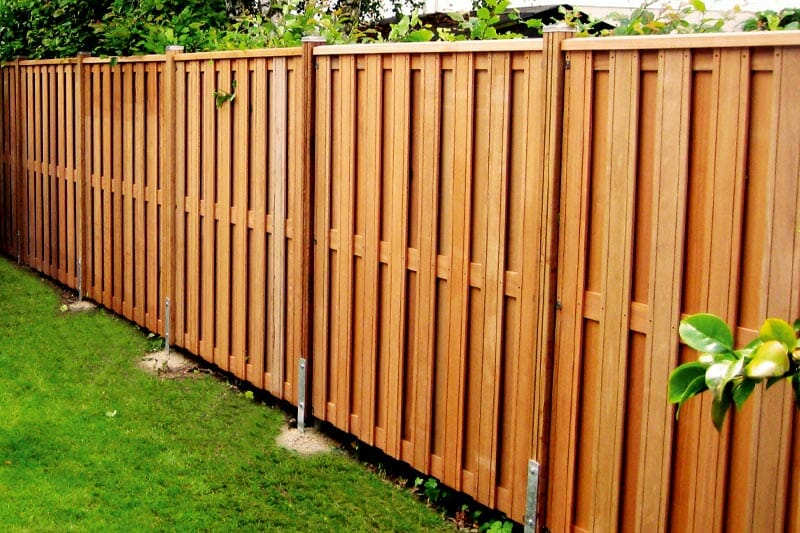
Flexibility
With a wood fence, you can get creative. Different types of paint work on wood and give it a new look each time you repaint. You can even mix colors without making the fence appear tawdry. Also, the material gives room for easy shortening if necessary. And some available accessories go well with wood fences to give the yard a new look.
There are different styles to choose from; you can go for rustic or stick with a sophisticated design. The choice is yours, but you must consider the environment and what suits it. A wood fence can provide privacy without making the property appear like a fortress.
Ease of installation
Another benefit of using a wood fence is the installation. Unlike corrugated metal, where you may require the help of a professional, you can install a wood fence yourself if you have the time, tools, and help you need.
With corrugated metal, there are sharp edges to worry about, but the same is not the case with wood. Moreover, it is quick to install, so you can begin using it as quickly as possible.
Versatility
A wood fence works well with any environment or area. You can install it in the suburbs, city, or even on a farm. Different establishments such as schools and government offices can use it. Similarly, it fits in with any type of residential property, whether an apartment complex or a personal house.
Accessible
Finding the best type of wood for your fencing needs is not difficult. You may need expert advice, but there are several options on the market. Also, wood fence materials are usually affordable, even the treated timber. Let your environment and usage inform your choice, but treated options are usually the best.
Cost factors to consider when building a fence
Certain factors play a significant role when building a fence, whether you are constructing a new one or replacing an old one.
- Installation method. If you are doing the job yourself, consider your skill set. Some materials, such as metal, need expert hands, and if you do not have the training, it means additional costs because you will need to hire professionals for the job.
- Material type. The type of material you wish to use will determine how much money you will spend on your project. Corrugated metal and wood fences do not have a large cost variation, but the actual cost will depend on the type and grade of the material.
- Fence type. The type of fence you want will also determine the overall cost of the project. For instance, a privacy fence would cost more to install than a simple picket fence.
Putting up a fence around your home or property can significantly increase privacy and security. It also offers reassurance for your family and pets. Moreover, a fence introduces a fashionable feature that enhances the look of your home.
Homeowners can expect to spend an average cost range of $5 to $12 per linear foot for the materials, and an average cost range of $15 to $22 per linear foot for installing a horizontal fence.
While it was more common to have a vertical fence, installing a horizontal fence has slowly gained popularity because of its modern look. Aside from that, it makes properties appear longer and bigger, without forsaking the added privacy.
Horizontal wood fence prices by type/species
Often, homeowners or property owners can already assume to pay more or less based on the height and length of the fence. However, one cost factor that is often overlooked is the type of wood selected for the fence.
Most of the time, fences are made from treated redwood, cedar, pine, or other water-resistant lumber material. Some homeowners also prefer to seal and apply something to it to not let it warp and rot.
Below are some of the most preferred types of lumber used for installing a 6-foot-tall fence, their pros and cons, and their average costs per linear foot of material.
| Type of wood | Pros | Cons | Average cost (per linear foot) |
|---|---|---|---|
| Cedar | Insect and rot repellant if it is pressure treated Cost-friendly | Requires yearly maintenance such as sealing, sanding, and wood-staining Can be dented and scratched easily Turns gray over time if not properly sealed and stained. | $3 to $7 |
| Spruce or Whitewood | Cost-friendly | Can decay in 8 to 10 years Prone to graying or darkening The pickets tend to shrink wherever it dries | $6 to $7 |
| Redwood | Best for staining and repainting Naturally fire-resistant and pest-repellant Do not easily warp | Can easily develop mold and damage by the sun if not properly and regularly maintained | $4 to $7 |
| Pressure-Treated Pine | Cost-Friendly Insect-repellant and does not easily rot if pressure-treated | Can warp, split, and shrink especially in dry environments If burned, the pressure-treated pine will release harmful chemicals if burned | $3 to $7 |
| Cypress | Durable and dense type of wood that is similar to pine Has natural components that can be insect and pest-repellant Rot-resistant and can last for a long time, especially in areas that experience rain and snow | Costly | $10 to $15 |
| White Oak | Can last for a long time, especially when you treat the wood A popular choice due to its light finishes Can be resistant to rotting | Is on the pricier side Can warp and bow especially in extremely damp and humid environments | $15 to $40 |
| Black Locust | Very durable and does not require extensive maintenance Ideal for agricultural purposes where maintenance is not as frequent | Due to its rarity compared to its counterparts, Black Locust wood panels can be expensive and hard to procure | $20 to $40 |
Horizontal fence post price
Normally, fence posts are made from wood, metal, or concrete that is then grounded in gravel, cement, or soil. Ultimately, the choice of your fence post depends on your liking and the construction requirements.
As a ballpark cost, purchasing a fence post can run up to $5 to $75 each, which excludes the fee for its installation or additional treatment.
The cost relies heavily on the type of material used in the fence post. Usually, properties or homeowners opt for wood posts for their wood fences to match the look. However; there are still other options available.
Below are the other options for fence posts, their average price per material, and their average cost of installation.
| Fence post type/ material | Average Cost (per material) | Average Cost (including installation) |
|---|---|---|
| Wood fence post | $5 to $20 | $10 to $50 |
| Concrete fence post | $10 to $50 | $30 to $100 |
| Metal fence post | $5 to $30 | $10 to $60 |
| Brick or stone fence post | $25 to $75 | $50 to $150 |
Hiring a fencing contractor
Before hiring a professional fencing contractor to help you have a quality horizontal wood fence, there are a few checklist items to tick before you have them start on the project.
The grade of material used for the fence
Normally, your price will depend on the quality of the wood you have chosen. Make sure that the contractor knows your needs and preferred option of wood and sticks to it when the project starts.
Sometimes, some wood types look similar to one another but are not necessarily the same, especially in their characteristics.
Quality of Materials
Ideally, your hired contractor must use stainless steel fasteners/nails. They should also avoid non-galvanized steel that can darken or bleed black in your fresh fence.
The grade of steel
As a rule of thumb in using steel posts, you should not have them install less than schedule-20 steel posts. Any type under that standard will easily break, especially in heavy winds.
Warranty and quality of service
Your hired contractors should have a history and certification in honoring labor warranties.
The hired professional should also have the necessary experience and expertise in constructing and installing horizontal wood fences.
Clear deal and contract
Before signing a professional on your fencing project, you should make sure that the terms are clear and not vague. Items such as labor fees, additional costs, warranties, and others should be agreed upon.
Doing so does not only protect your interests but would also assure the hired contractor that the project is arranged and will be worthwhile.

Cost to DIY a horizontal wood fence
Homeowners that are familiar with home improvement and have power tools will find the building and installation of a wood fence easy. Doing so can save money since it does not require paying for a professional’s service.
However, having zero experience in home improvements can make the task very difficult. In this case, hiring a contractor to handle the fencing project might be the smarter choice.
If you are unsure if you can do it yourself, you might end up spending thousands and loads of hours, only to have an unsatisfactory fence for your property.
Necessary tools/factors to consider before DIY horizontal wood fence installation
Below are some of the necessary items and factors that you need to have and consider before doing a DIY horizontal fence:
Equipment and tools
Normally, you would need tools to build a horizontal fence. If you already own some of these, you won’t need to spend on another one. If you don’t, below are some of the tools and their average prices.
| Equipment / Tool | Average cost |
|---|---|
| Work Gloves | $5 |
| Protective Safety Glasses | $16 |
| Paint Brush | $15 |
| Spray Paint | $5 |
| Mason’s Line | $15 |
| Tape Measure | $18 |
| Hand Saw | $16 |
| Claw Hammer | $20 |
| Post Hole Digger | $50 |
| Power Drill | $80 |
| Level | $21 |
| Total | $266 |
Materials
Typically, the cost for the materials will depend on the type of wood that you will use and the size of the area where you will install your fence. Below are the ballpark costs of the necessary materials:
| Materials | Cost (per item) | Cost (per 150-foot wood fence) |
|---|---|---|
| Box Nails | $12 | (not applicable) |
| Deck Screws | $23 | (not applicable) |
| Concrete Mix | $20 | (not applicable) |
| Gravel | $400 | (not applicable) |
| Wood Stain | $125 | (not applicable) |
| Pickets | $5 | $1,640 |
| Horizontal Rails | $13 | $1,640 |
| Fence Posts | $28 | $560 |
| Total | $3,300 |
Horizontal fence vs vertical fence
Aside from providing additional privacy and security to your home, horizontal and vertical fences can help define the borders of your property, regardless of whether yours is a residential or commercial property.
Below are some of the differences between horizontal and vertical fences:
The openness of backyard
Vertical fences can have boards with spaces in between boards that can offer visibility of your backyard. This variation can be best if you want your space not to be entirely closed off.
If you want your property to have total privacy, horizontal fences may be the best pick. This is because horizontal fences rarely have spaces in between the boards, which offers less visibility than its counterpart.
Durability and strength
Horizontal fences are more durable, especially in locations that experience rain and weather damage.
Vertical fences are more prone to natural rotting and weather damage since the top and the wood can easily rot at the base and exposed edges.
Privacy
Because of its general construction design, horizontal fences can guarantee reliable privacy for your property. Since its design has panels closer to each other, it can block external viewing.
With vertical fences, the panels or boards have more spaces in between, making external viewing possible. If you want more privacy with vertical fences, you can consider chain-link instead of wood.
Ease of installation
If you consider doing the fencing project on your own, whether it is a horizontal or vertical fence, you will most likely do it on your own and do a good job.
If your residential or commercial property has uneven terrain, it may be best if you hire a professional since they are more experienced in dealing with fencing on slopes.
Additionally, it might be more suitable to have vertical fencing since it can be challenging to opt for horizontal boards on irregular or uneven ground.
Other considerable differences that make horizontal fences different from its counterpart are the following:
| Horizontal fence | Vertical fence | |
|---|---|---|
| Appearance | Unique, modern, and appears sleeker and impressionable | Appears attractive, but is common and can be considered outdated |
| Cost | Can be more expensive and labor-extensive | Less expensive compared to its counterpart |
| Installation on uneven terrain | Can be more complicated to build on uneven ground or contoured ground. Horizontal fences are best installed on level surfaces. | Can easily be installed even on textured or uneven ground |
| Durability and strength | Can be less sturdy and durable, but can be remedied by installing more vertical posts | It Is more sturdy because of its construction design where it uses 2x4 stringer |
| Availability of pre-built wood panels | Horizontal fence panels must be built on-site | There are pre-built vertical panels that can be bought or ordered |
Advantages of a horizontal wood fence
As initially mentioned above, there are several differences that horizontal fences offer compared to vertical fences. These differences can either cater to your specific fencing needs or can convince you more to choose it.
Below are some of the notable advantages of having a horizontal fence installed.
Variety of styles and designs
One of the best parts of choosing a horizontal fence is that it comes with different styles and design choices. With this, you have multiple options to make your property appear the way you intend it to be.
With horizontal fences, you can choose between split rail, board on board, woven designs, and other types of styles and designs.
With this variety of options, you can make your fence distinct from others, adding more personality and look to your property.
Customizability
If you choose to have a horizontal fence for your home or commercial property, you will have the advantage because you can tweak it so it suits your preference and necessity.
For example, you can have wood-stained panels to match the existing items in your landscape or have them match your gate.
Environmentally friendly
One of the advantages of having horizontal wood fences, especially if you are conscious of the environment, is that they will not damage your surrounding even if they start to rot.
If they start to have damage or rot, you can stain them to repel termite damage. This also means that you do not have to use harmful chemicals that can be dangerous to your health and the environment.
Less waste
In constructing and installing horizontal fences, the panels or boards do not necessarily have to be the same size, unlike vertical fences. This helps you save more money since it won’t waste too much wood.
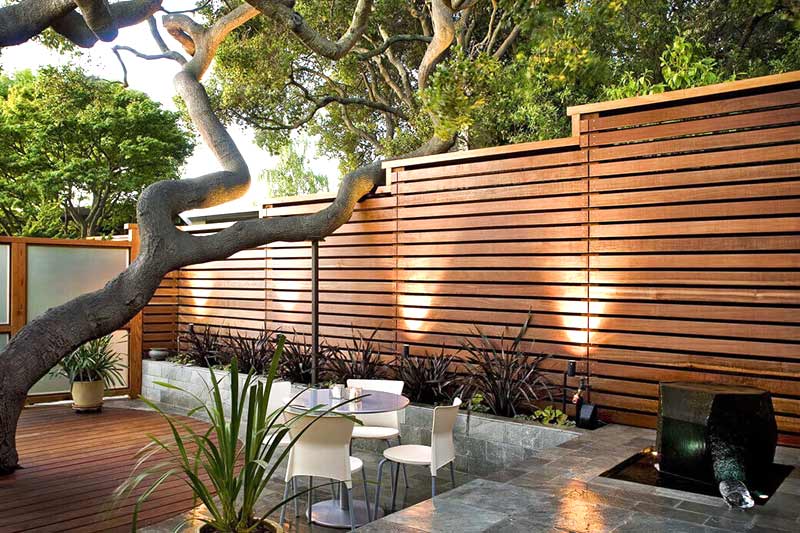
A redwood fence is celebrated for its innate allure. Crafted from a robust wood variety, it stands to reason that it would also be enduring. Yet, one may wonder, what is the typical lifespan of such a fence?
Redwood fencing can last up to 25 years with little to no maintenance. It can easily last up to over 30 years with proper maintenance.
Here is everything that you need to know about redwood fences and their longevity.
Why does redwood fencing last so long?
It lasts so long because it has tannins, acids, and other natural oils that help to protect it. It is also highly dense. And has a unique cell structure.
All of these things combine to help to shield it from:
- Moisture infiltration
- Termite and pest damage
- Warping and splitting due to temperature changes
- Physical damage
Since these are the main causes of damage for almost any wood fence, the fact that redwood has natural protection against them usually goes a long way toward guaranteeing a long lifespan.
How do you prolong the lifespan of your redwood fence?
You can easily get over 2 decades’ worth of value from a redwood fence with little to no maintenance. However, if you want to get a wooden fence to last longer, there are a few things that you should do.
Clean it
Dirt and debris don’t just ruin the beautiful appearance of redwood. They can also trap moisture. This then leads to extended moisture exposure. With time, this will accelerate the rate at which the fence wears out.
To prolong the lifespan of your fence, and almost any other wood fence, you will need to clean the fence regularly.
You should:
- Use a putty knife to remove debris from seams, gaps, and corners.
- Use a leaf blower to remove any remaining debris.
- Wash the fence with soap and water.
To remove any stubborn stains, mildew, or grease, you may have to use diluted bleach, a TSP mixture, or a specialized wood cleaner. Using a brush, instead of a cloth, may also help to remove stubborn stains.
Repair it
Dents, cracks, missing fasteners, and rusting nails are just a few of the problems that will develop over time. You should fix them as soon as they show up. Failing to do so immediately can cause the problem to spread.
Therefore, you should replace any missing fasteners as soon as possible. Reinforce loose or leaning boards. And remove rusted nails.
Stain it
A good quality stain will protect the wood from moisture infiltration. And if you use a transparent stain, you can give the redwood extra protection without necessarily having to compromise its appearance.
You can also give it better protection by applying a semi-transparent stain. Such a stain will not only shield it from moisture infiltration, but also protect it from the damaging effects of UV rays.
The added protection that the fence will get from a high-quality stain will have a significant effect on its lifespan. However, you will have to re-stain the fence after every couple of years so as to guarantee the effectiveness of this extra protection.
Create separation
If you have vines or shrubs growing next to your fence, you should trim them. Doing so is important as this vegetation tends to:
- scratch off the protective layer of the fence — be it a stain or paint
- trap moisture, and this constantly exposes the fence to moisture
- attract pests and other harmful animals that may cause physical damage
- ruin the appearance of the fence by depositing leaves and other debris on the fence
Since vines, shrubs, and plants that grow next to your fence can damage it, regular trimming can effectively prolong your fence’s lifespan.
Does redwood need to be treated?
No, redwood doesn’t need to be treated.
It can last for up to 25 years without treatment because of its tannins, oils, and unique cell structure. A combination of these factors makes it natural:
- resistant to rotting
- resistant to termite infestations
- good at handling moisture exposure
- fire resistant, and
- resistant to warping, splitting, and bulging
However, this does not mean that treating redwood is pointless.
While it may not be beneficial to treat it against termites, staining and sealing redwood will significantly improve its lifespan. It will arm the fence with extra layers of protection against the sun and moisture, and this will definitely go a long way toward increasing its longevity.
Does redwood last longer than cedar?
Yes, redwood lasts longer than cedar.
It is denser. It has stronger concentrations of tannins and oils. And it has a superior cell structure that gives it better protection against moisture infiltration, termite attacks, rotting agents, and fire.
Therefore, redwood fencing tends to last longer than cedar fences.
Is redwood good for fencing?
Yes, redwood is good for fencing.
It contains acids and natural oils that shield it from moisture infiltration. These oils and acids also repel termites and other pests.
Benefits of using it for fencing
These qualities make it a great fencing material because it means that the fence will be able to withstand the harsh external environment. The fence will be:
- less likely to become warped
- naturally resistant to termites and other harmful pests
- naturally resistant to rotting agents
- last really long
No need for regular maintenance
And since the fence will have these qualities naturally, a homeowner won’t have to worry about regular maintenance.
All these things combine to make redwood one of the best fencing materials in the market. This is so especially when you consider the fact that it isn’t treated with chemicals – like pressure treated wood.
The only downside to using redwood is that it isn’t as readily available as other fencing options like cedar. And so unless you live on the Northern California Coast, you are likely to have a hard time getting your hands on it.
It is also relatively more expensive. This usually limits its use. And it can make using it uneconomical, especially when you compare it to the cost of typical wooden fences..
FAQ's
Yes, redwood lasts longer than cedar fences.
Why?
Because redwood, from giant redwood trees, is denser than cedar. It also has a higher concentration of acids and natural oils that give it a healthy measure of resistance against rotting, pests, fire, and moisture infiltration.
No, a redwood fence does not need to be sealed.
Structure, density, and oils
Thanks to its unique cell structure, density, and protective oils, the fence has an elaborate protective system that does what a sealer normally does. Therefore, when compared to the average wood fence, it is better at withstanding moisture, sun, and extreme temperature exposure without getting damaged.
However, this does not mean that you shouldn’t seal your redwood fence.
Sealing helps
While it doesn’t need it, it can definitely benefit from being sealed. This is because the sealer will be an extra layer of protection that the harmful elements will have to get through before they can come in contact with the wood.
Therefore, sealing will help to increase the lifespan of the redwood fence.
You stain your fence at least once every 3 years. Staining it as often as after every 2 years is ok. And so is taking 4 years in-between stains.
You have to re-stain periodically because the stain wears off with time. And so if you used a stain to enhance the color of lighter redwood timber fence planks, the color may start to fade with time. And so re-staining may be necessary to enhance its appeal.
The stain may also get scratched and chipped. And so you will have to refresh the protective coating on a regular basis if you want to prolong the lifespan of your fence.
No, you shouldn’t paint your redwood fence.
Covers the attractiveness
While there is nothing wrong with painting it, you shouldn’t do it because you will be messing with one of the redwood’s best features: its beauty and appearance.
Unlike a typical wooden fence, a redwood fence has an excessively attractive reddish color. It also has a beautiful grain profile. And it always gives a home a beautiful natural appeal.
Painting it will mean covering all this behind a coat of paint. It almost makes using redwood pointless.
Naturally has what paint provides
Furthermore, the redwood fence doesn’t really need what painting provides. It is already aesthetically pleasing. And it is naturally resistant to moisture and other weather elements.
Better alternatives
There is also the fact that you have superior options like sealing and staining. These options give the redwood fence all the protective benefits of painting without hiding its beauty. This is because there are transparent and semitransparent stains and sealants.
Yes, you can use redwood as fence posts.
It is strong, durable, moisture-resistant, and pest-repellent. This means that, unlike other fencing materials like pressure treated wood, cedar, and douglas fir, it won’t have trouble bearing the weight of the fence. It also won’t succumb to moisture, rotting, and termite attacks.
You should choose cedar for fencing.
Redwood is superior
You should choose it even though redwood is superior in terms of raw strength, stability, resistance to moisture, ability to repel pests, and aesthetic appeal.
But…
Why? Because cedar is more readily available. When compared to redwood, it is very affordable. And since it has enough of the good qualities of redwood, cedar wood fences typically provide better value for money.
Yes, staining makes a wooden fence last longer. This is because a stain essentially seals the wood fibers and makes it less likely to allow moisture to infiltrate it. And in cases where one is using a transparent stain, he or she will get more out of the fence because the stain will shield it from

If you need help installing or fixing a fence, you should use HomeGardenGuides.com. The site offers a free service that allows you to easily explore and rate the quality of services that fencing experts in your area provide.
The service that they provide quickly matches you with the top-voted local expert fence repair services.
Using the website, you can get 3 estimates fast by real certified experts in your area in just 2 minutes.
Here is how it works.
- You scroll to the top of the page and enter your Zip code.
- Answer questions about your fencing needs and preferences
- Your details will be forwarded to three local experts.
- You will then receive a price estimate – in writing – for the job and some friendly advice.
IMPORTANT: There is no obligation to hire. This is a free tool and service to be used at your pleasure, whether you just need more information on fixing a fence or you need an expert’s advice.

Homeowners looking to enhance their home’s privacy will discover that installing a Redwood fence is an excellent choice. The installation price of such a fence depends on the selected design, dimensions, placement, and desired finishing.
On average, installing a redwood fence costs between $15 to $40 per linear foot, fully installed. At minimum, you can spend about $8 per linear foot to install the fence, while the maximum cost can be up to $60 for privacy fences. Materials alone can cost around $7 to $25 per linear foot.
Here is a table showing the average cost of redwood fence installation cost per linear foot.
| Size (Linear Foot) | Average Cost (Materials only) | Average Cost (installed) |
|---|---|---|
| 25 Linear Feet | $125 - $375 | $375 - $875 |
| 50 Linear Feet | $225 - $750 | $700 - $1,700 |
| 100 Linear Feet | $450 - $1,450 | $1,450 - $3,500 |
| 200 Linear Feet | $950 - $2,950 | $2,950 - $7,000 |
| 500 Linear Feet | $2,550 - $7,800 | $7,800 - $17,000 |
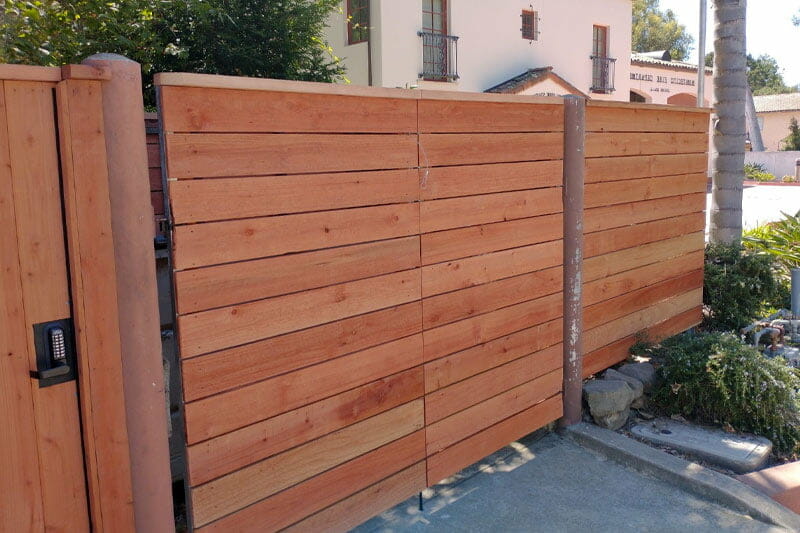
Redwood Fence Installation Labor Cost
Professional fence contractors charge an average of $8 to $25 per linear foot for labor to install a redwood fence. The costs may vary depending on your location. Typically, people living in high-income areas (urban settings) may get higher labor quotes than people living in low-income areas.
Redwood Fence Cost by Style
There are several options you can choose from when installing your redwood fence. The overall cost of a redwood fence will depend on the type of fencing you choose. Ranch style and picket are on the cheaper end of the spectrum, with an average cost of around $10 to $15, installed.
Privacy fences, on the other hand, can cost up to $27 to $60, which is quite expensive because it requires more materials and time.
Below are various options you can consider when installing a redwood fence:
| Style | Cost Per Linear Foot (Materials Only) | Cost Per Linear Foot (Installed) |
|---|---|---|
| Horizontal | $5 - $12 | $15 - $22 |
| Privacy Fence | $10 - $17 | $27 - $60 |
| Wooden Picket | $3 - $8 | $10 - $18 |
| Picture Frame Louvered Frame | $7 - $12 | $17 - $27 |
| Picture Frame Board-on-Board | $5 - $10 | $15 - $25 |
| Piano Key Lattice Fence | $7 - $11 | $18 - $24 |
| Shadow-box Fence | $7 - $15 | $17 - $35 |
| Nail-on Flat Fence | $3 - $5 | $10 - $15 |
| Ranch Style/ Split Rail Fence | $3 - $6 | $8 - $16 |
| Stockade Fence | $5 - $10 | $15 - $20 |
Is It Cheaper To Build a Horizontal or Vertical Redwood Fence?
Ideally, horizontal redwood fences cost more to install than vertical fences. This is because the boards used should be from high-grade lumber to prevent sagging. However, horizontal fences may still sag over time, but they can still last for several years without needing a replacement.
How Long Does a Redwood Fence Last?
With proper care and maintenance, redwood fences can last for about 15 to 25 years. The lumber is naturally resistant to insects, rot/decay and warping, and requires little maintenance.
What Is the Best Redwood for Fencing?
When installing a redwood fence, it is recommended to use higher-grade lumber as it is the most durable, and it is more resistant to insects and decay. However, higher-grade redwood is expensive than low-grade redwood, which may make homeowners with a tight budget to look for other cheaper fencing options.
If you still want to use redwood because of its aesthetic value, but your budget is tight, you can use high-grade redwood for your panels and low-grade lumber for the fence posts.
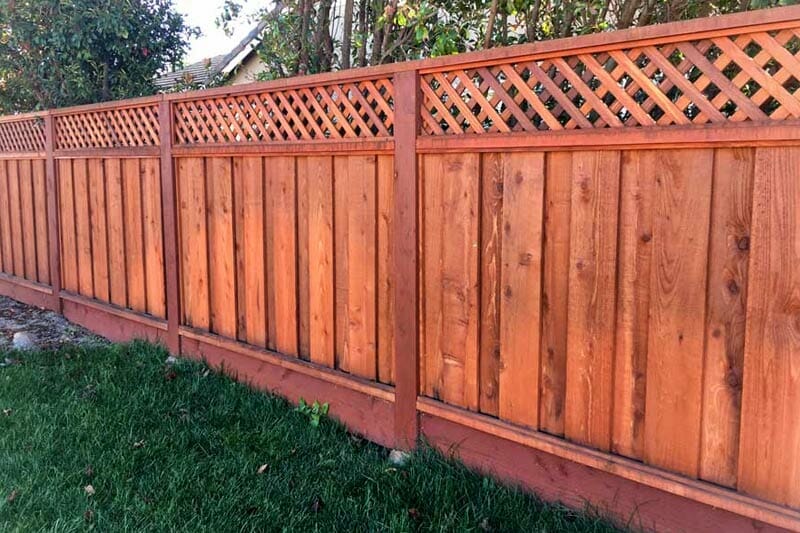
Repair and Maintenance Cost for Redwood Fence
Redwood fences require little maintenance because of their natura; resistant to insects, rot and warping. You can clean and stain the fence every 2-3 years to maintain its natural look and boost durability.
Repairing a redwood fence costs around $300 to $900. The cost can be as low as $150 for small repair jobs, while significant damage can cost up to $1,350 to repair.
Are You Ready To Hire a Redwood Fence Installer?
Finding a reliable redwood fence installer is not as challenging as most people think. As long as you do your due diligence, interview several professionals and get at least three quotes, you are good to go. However, if you do not have the time to search for a professional, we can help you.
Use this FREE Service
HomeGardenGuides.com is a free service that quickly matches you with top voted local Fence contractors.
You can get 3 estimates fast by real certified experts in your area in just 2 minutes.
- Scroll to the top of the page and enter your Zip code.
- Answer questions about your mold job
- Your roof details are forwarded to three local experts. They will send you a price estimate for the job and some friendly advice.
IMPORTANT: There is no obligation to hire. This is a free tool and service to be used at your pleasure.

FAQ's
A fence does not necessarily add value to a home, but it may enhance your home’s value if there is a true need for the fence.
Yes, it is cheaper to DIY your fence installation as you will not have to pay for labor costs which tend to take about 50% to 70% of the overall project cost.
However, DIY projects may end up being costlier in the long run because you will still need to buy all the materials and equipment needed for the installation. Besides, you may make mistakes that may cost more to repair, and you may also injure yourself if you do not have enough skills for the job.
For this reason, it is best to hire a professional fence installer to handle your project. The professional will know where to buy materials and all needed equipment at a cheaper cost. Also, the expert will complete the project in time, which is convenient if you need to use the structure for an upcoming event.
Redwood fences are durable and l;onglasting as they are resistant to rot, decacy, warping and insects. These fences are also easy to maintain, and do not require much cleaning.
Redwood is harder than cedar, so it is more long-lasting and durable. Naturally, redwood contains more naturally occurring chemicals than cedar, making it more resistant to insects, rot and decay.
Yes, redwood turns gray over time due to the effects of weather. As the weather changes, redwood becomes lighter in color, and eventually turns to a light, driftwood gray.
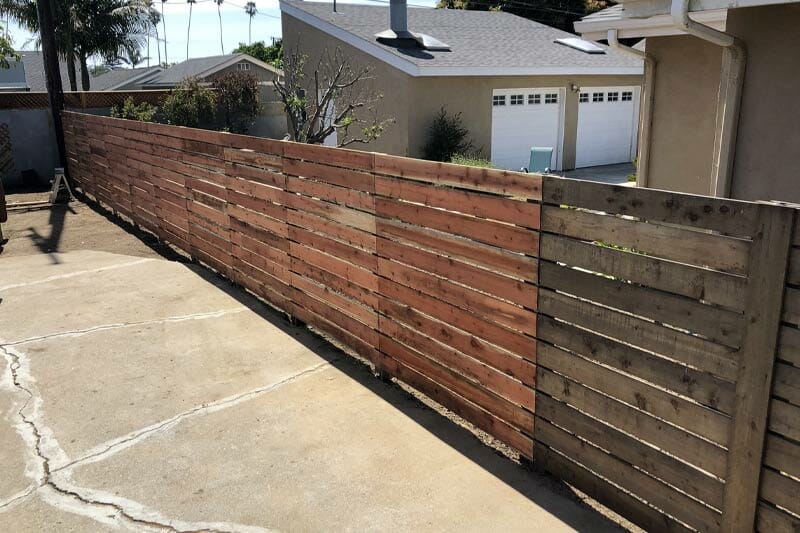
Yes, you will need a permit to build your fence. Whether it is a front, side or boundary fence, you should get a permit from local authorities before you begin the project. The permit laws and regulations may differ from one state to another. Also the fence height differs depending on where it will be located.
More and more people are choosing to use metal posts for their wood fencing because they offer better durability and stronger support for the fence.
On average, a customer will pay $4,500 for a wooden fence with metal posts. The total cost depends on the height, style, number of posts, and the shape of the posts.
The price is subject to change depending on the contractor that you use, type of metal and wood, permits, the terrain, among other factors.
Average Cost of Wood Fence with Metal Posts
To get the accurate cost of installing a wood fence with metal, you will need to involve a professional.
The cost of installation for a wood fence is $3000 – $6500, but the average customer will most likely pay $4500 for a standard-sized residential land, which is about 209 linear feet. On the low end, you can spend about $2,000 on the fence without a gate. The cost can go up to $10,000 for a 6’ high privacy fence.
| National average cost | $4,500 |
|---|---|
| Average range | $3000- $6500 |
| Low-end | $2,000 |
| High-end | $10,000 |

If you insist on getting the estimate yourself, get a pen and paper and:
- Write down your budget.
- Identify and note down the type of wood you want and is within your budget.
- Identify and write the type of metal posts you want; again, ensure it’s within budget.
- Add any additional costs, such as gates and decorations.
- Calculate the final price.
This will form the foundation of the whole project, and it will help you stay within budget and not break the bank. However, remember that this is just a rough estimate, and it may go overboard or even below budget.
Factors Affecting The Cost Of Wood Fence With Metal Posts
Various factors determine the cost of a wooden fence with metal posts.
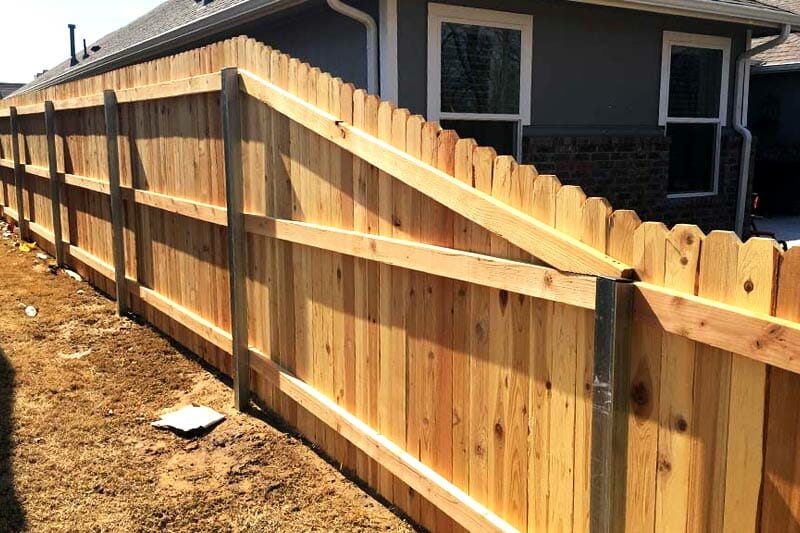
The Type of Wood
The type of wood is the primary determinant of the price. Different types of wood come in at different prices. The one you use narrows down to your budget as the homeowner and the aesthetic appeal that you are going for.
Some popular options you may explore include:
| WOOD TYPE | COST | BENEFITS |
|---|---|---|
| Western redceda | $6 to $8 per six feet picket | Resistant to rot, moisture, and weather damage resistant |
| Redwood | $8 for six feet picket | A mid-priced option that needs to be stained before installation to preserve its beauty |
| Spruce | $5 for a six feet picket | An economical but less durable alternative |
| Pine | $1 to $5 for a six feet picket | An affordable fencing option resistant to rot and insect infestation |
| Tropical hardwood | $10 to $15 for a six feet picket | Last a lifetime and feel like natural wood |
The Type of Metal
The price of metal posts varies depending on the metal material used, its height, and the quantity you purchase. For instance, the price difference between a wrought iron metal post, steel post, and aluminum post is significant.
Steel Posts
Steel posts are mid-priced, ranging between $30 and $60, and are often used to install wooden fences because they are robust and long-lasting. These posts will serve you well for more than two decades with little to no maintenance. You can enhance the strength and durability of steel posts through galvanization, which also boosts their rust resistance properties.
Aluminum plated posts
Aluminum plated posts are also a popular option that ensures you save a few coins. They cost $25 – $45 and are perfect for experimental designs since they are more versatile than steel posts.
Metal posts
Metal posts can cost between $3 and $50 each. The cost is also based on the style of the posts. For instance, you pay less for slim metal stakes than you would for round poles or sturdy square metal posts. Corner and gate posts are also significantly more expensive ($50-$150) than line posts.
The Fence Contractor
Although you can install a wood fence with metal posts yourself, making use of professional contractors is always the best option because these contractors are skilled and more conversant with fencing jobs.
Most contractors charge between $40 and $150 to install the metal posts. That’s because most fencing contractors only install vinyl or wood posts as part of a complete fence installation project.
The total cost of installing each post will depend on the size and depth of the post hole and the material used to anchor the post, whether concrete or gravel. Anchoring using concrete boosts the price by $2-$4 per linear foot more than gravel.
Permits
As aforesaid, a contractor is vital in this process because they should know whether or not local building codes require permits during the construction of a fence and what restrictions are present.
If you do not want to incur the cost and hustle of building your dream fence, then have to bring it down because you did not abide by the restrictions or secure a permit.
On average, the cost for a permit ranges from $400-$800, but this is different in all states.
Nature of the Land
The nature of the land also affects the cost of installing a fence.
- Accessibility. If the land on which the fence is being built is not easily accessible, labor costs will shoot up significantly, making the overall cost of the project increase. This is because you have to incur the cost to transport employees and materials.
- Hindrances. If the land has shallow groundwater, clay, rocks, and bushes, just to mention a few hindrances that will require preparing the ground, these obstructions increase labor costs by 20% to 40%. That’s because prepping the land will take more time than it would if there were no hindrances.
- Slope. If the land is on a slope, the cost will increase drastically. Working on a slope is cumbersome and may require additional materials to ensure the fence remains strong and sturdy.
You can also opt to surface mount the metal posts using a welded flange if the land is hard. This requires additional materials that result in higher costs.
Decorative Fence Post Caps
You can add decorative post caps to the ends of the metal posts to improve the attractiveness of the fence. These can cost between $5 and $50 each.
Boost the functionality of the caps by adding lighting, which typically costs between $20 and $60 per lighted cap. Installing the lighted caps is the job of an electrician and costs about $65 to $85 per hour.
Other Cost Factors
- The cost of removing and disposing of existing fencing is excluded from the average price and costs about $2 and $5 per linear foot.
- Gate installation is also priced separately and ranges between $200 and $600.
Why Settle For Wood Fence With Metal Posts?
Metal posts became popular after the ban of Chromated Copper Arsenate, which was used as a preservative to prevent wood posts from being exposed to moisture in the ground.
The popularity of metal posts for wood fences is well deserved owing to the multiple advantages offered by the posts.
Makes Your Fence Last Longer
The minute wood posts are embedded on the ground and are in constant contact with moisture and insects they begin to decompose. This makes the wooden fence meet its early demise due to a rotten base. On the other hand, metal posts are not subject to destruction from moisture or insects, ensuring the fence lasts long and serves you well.
Make the Fence Stronger
Regardless of the type of metal you use, metal posts are significantly stronger than wood posts. Erecting a wood fence with metal posts offers greater support to a wooden fence and makes it less vulnerable to harsh weather, which may easily bring down the fence.
Enhances Curb Appeal
There are plenty of designs to choose from as well as a handful of metal types that you can use to beautify your fence. This breaks the monotony of having a plain wood fence without outstanding designs.
The Fence Will Stand Straighter
As wood posts continue to age, individual posts begin to get weaker, and you may notice several posts in a section breaking at the base, making the fence posts lean to one side. Metal posts will not break easily or get weaker over time, meaning they will help maintain your fence’s structural integrity for longer.
Every good thing has its negative side, and metal posts are not excluded. While its positive attributes outweigh the negatives, they significantly contribute to a high price point compared to other metals.
Looking for a Quality Fence Contractor?
Different contractors charge differently for the same task. Before hiring a contractor, always ensure you do extensive research and compare several contractors before settling on one because the fence contractor is an integral part of this project.
Homegardenguides.com is a FREE tool to help you get several estimates in your area, and compare them to get the most affordable prices.

Over time, a wooden fence will accumulate grime, dirt, mold, mildew, and algae. It will need a good clean every 4 – 6 years to keep looking great.
There are two ways to clean your wood fence, with a power washer or by hand. A power washer is recommended as it is very fast and does a better job.
Let’s clean your fence!
No. 1: Powerwash
If you use a power washer you will finish the job quicker than washing it by hand. If you don’t have one you can rent it from your local hardware store. You must be careful because you might damage your fence. Follow these steps to make sure that you power wash your wooden fence correctly:
Step 1: Remove Dirt and Debris With a Wire Brush
Before you power washes your wood fence, take a wire brush and gently scrub off caked-on grime such as mud. It is especially important to be gentle with a painted fence because the wire brush can cause significant damage to the paint.
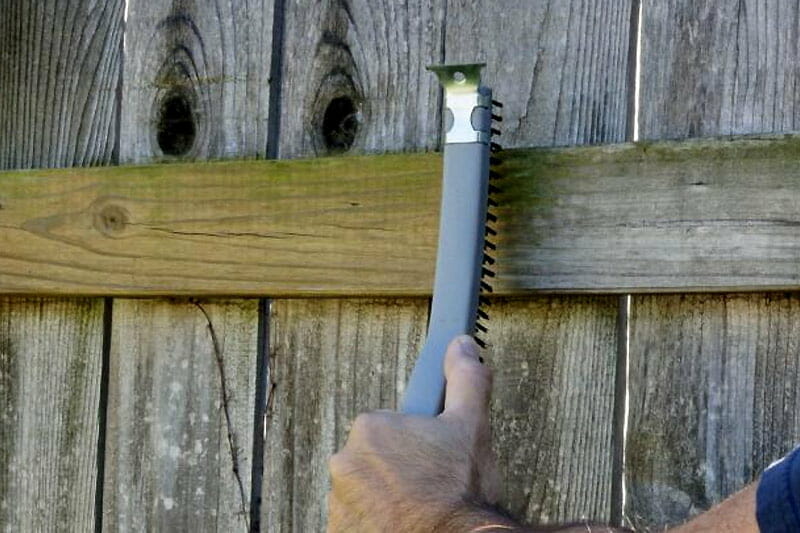
Step 2: Use a Garden Hose To Rinse Your Fence
Prepare your entire wooden fence for pressure washing using a garden hose set up on medium-high pressure to get off some surface dirt.
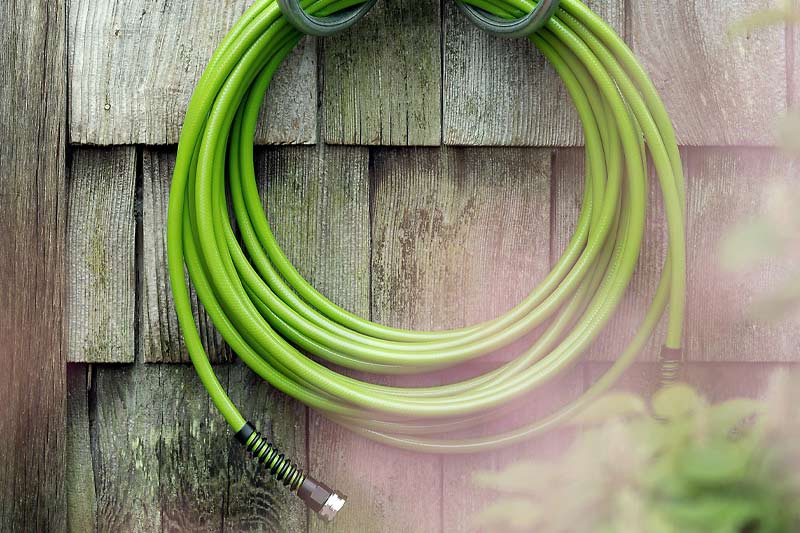
Step 3: Prepare Your Pressure Washer for Action
Be careful when pressure washing a wood fence so that you don’t damage it. Do not use higher pressure than 1500 – 2000 psi.
My recommendation is to add a tip to the pressure washer that will fan out the water, a 25-degree tip is a good choice.
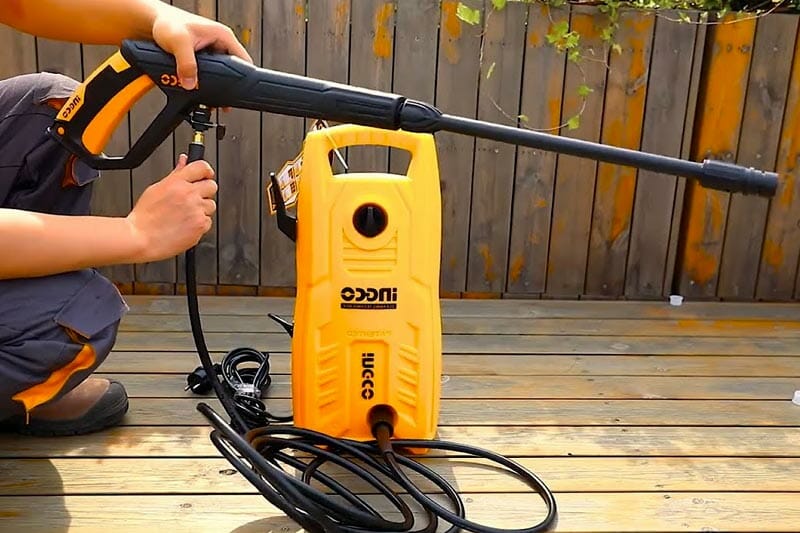
Step 4: Clean Your Wood Fence With Long and Even Strokes
Stand about 2 feet away from the fence when using a pressure washer. With long and even strokes spray from right to left and keep going until you no longer see dirty runoff coming from the fence.
Never point the power washer at one particular spot for too long because you will end up damaging your wooden fence.
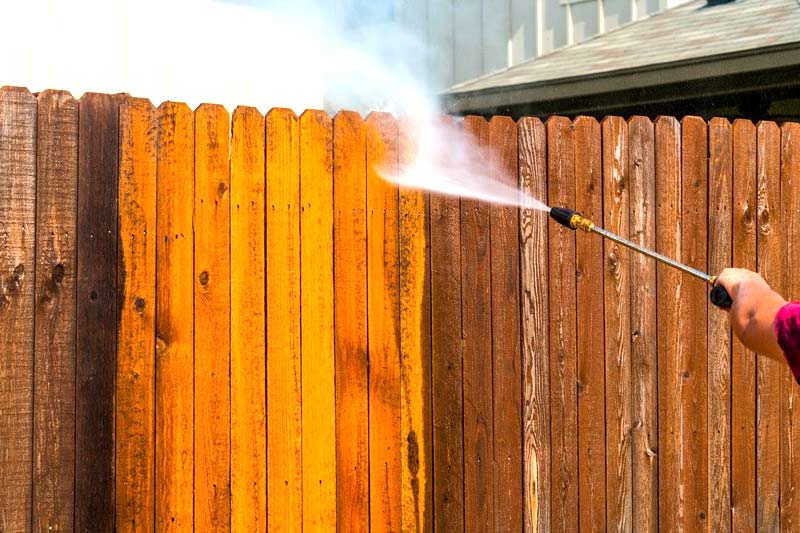
No 2: Clean Your Fence by Hand
Hand-washing your fence can take your time but it is a good option if you are concerned about potentially damaging your fence. Follow the following steps.
Step 1: Prepare Your Fence
As with the power washing method, prepare the fence first by scrubbing off caked-on bulk like mud with a metal brush and then rinse the fence with a garden hose.
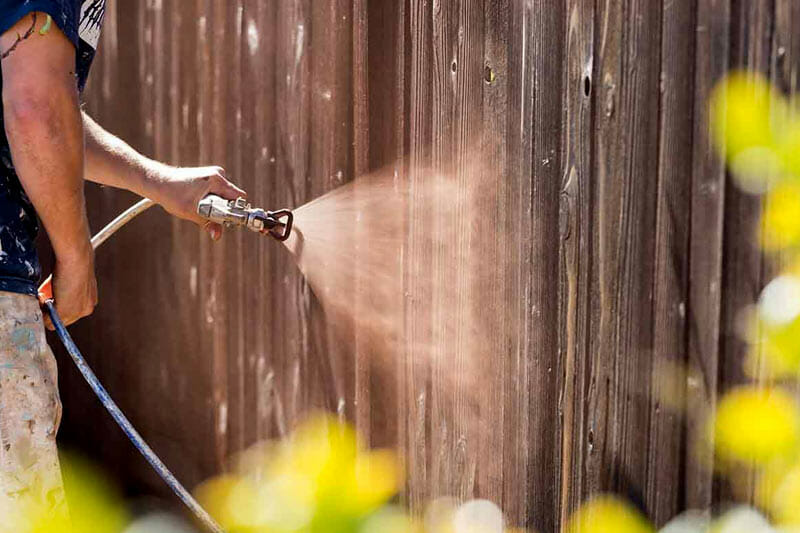
Step 2: Apply Oxygenated Bleach
Oxygenated bleach is a great tool for safely removing stains from fence and exterior surfaces.
Following the manufacturer’s instructions, mix an oxygenated bleach powder with water and then begin to brush it onto the fence using a painter’s brush. Use a large paintbrush so that you can get the job done faster. Let the bleach sit for 15 minutes.

After 15 minutes use a plastic bristle scrub brush to scrub off the dirt and rinse the bleach off your wooden fence using a garden hose.
Removing Mold, Algae, Moss, and Mildew
After washing is done you may have some mold, moss, mildew, or algae left to be clean. Here is how to remove them:
Removing Moss and Mildew
Moss and mildew are both damaging your fence. To remove moss and mildew use a mixture of ½ cup of vinegar and 1 gallon of water. Apply this mixture to the wood fence with a sponge and let it sit for 15 minutes. After that use a plastic bristle brush to scrub off the moss and mildew and rinse the whole area with a garden hose.
Removing Mold and Algae
Like moss and mildew, mold and algae can cause significant damage to your fence even if you clean them. They leave behind green stains. These ugly growths can be removed with a mixture of one part chlorine bleach and two parts water. Scrub the mold and algae from your fence using a plastic bristle brush and this mixture. This mixture will make mold and algae go up and with rinsing, you can get rid of them.
If your fence is still dirty and unsightly enough that even all the washing doesn’t help, maybe it is time for a new fence. For best offers and free estimates follow the instructions from the paragraph below:
Use This FREE Service
HomeGardenGuides.com is a free service that quickly matches you with top-voted local Fencing Specialists.
You can get 3 estimates fast by real certified experts in your area in just 2 minutes.
- Scroll to the top of the page and enter your Zip code.
- Answer questions about your fencing job
- Your fencing project details are forwarded to three local experts. They will send you a price estimate for the job and some friendly advice.
IMPORTANT: There is no obligation to hire. This is a free tool and service to be used at your pleasure.

FAQ’s
Can Mixing Cleaning Solutions Be Bad?
Yes. This is the most common when bleach and vinegar come together. If you plan to use both of them in the same procedure, be sure that the bleach is fully rinsed before you proceed with the vinegar. Mixing the two of them can cause a deadly and poisonous gas.
Cedar and redwood are commonly chosen by homeowners for fencing on residential properties. Both wood options are known for their durability and strong resistance to moisture, making it difficult to decide between the two types of fencing.
Redwood fencing performs better in terms of quality, durability, longevity, and appearance compared to a cedar fence. However, redwood fencing is more expensive to install ($28 – $55 per sq. ft) than cedar fencing ($12.50 – $33 per sq. ft), as it can be difficult to source.
Cedar and redwood installation costs vary considerably across US regions. It would be helpful to indicate your region while getting a free estimate from this website.
Cedar vs. redwood fence cost per square foot
The average cost to install a cedar or redwood fence on your property is between $15 to $35 per square foot, with labor costs averaging $20-$50 per hour depending on the property size and the scope of work.
Expect to pay significantly higher for a redwood fence. A 200-linear foot redwood fence costs around $6,270. Redwood fence cost per foot is around $31.35.
You can save costs by building with narrow boards instead of the more expensive wide boards. It would be good to remember that lumber costs fluctuate each season, often influenced by weather and availability. We recommend taking a trip to a local sawmill to check out wood board prices before getting a professional estimate for your proposed fencing project.
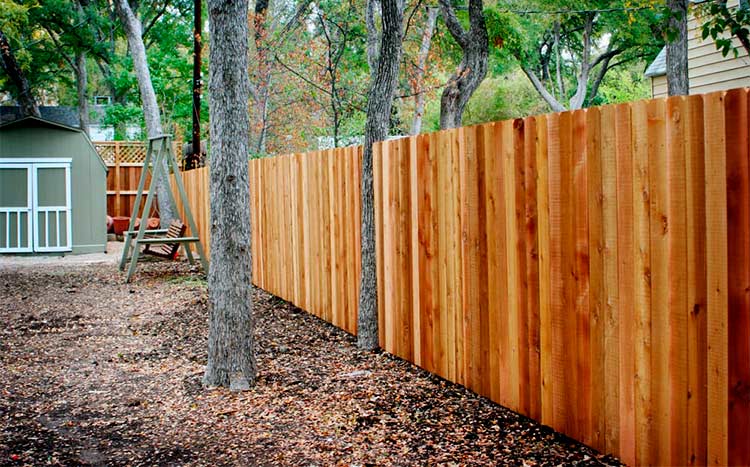
Use this FREE service
HomeGardenGuides.com is a free service that quickly matches you with top-voted local contractors.
You can get three estimates fast by real certified experts in your area in just 2 minutes.
- Scroll to the top of the page and enter your Zip code.
- Answer questions about your fencing project.
- Your project details are forwarded to three local experts. They will send you a price estimate for the job and some friendly advice.
IMPORTANT: There is no obligation to hire. This is a free tool and service to be used at your pleasure.

Cedar fence cost
Professional rates for installing cedar fences range between $12.50 to $33 per square foot, depending on the project size, material type, and scope of work involved. A DIY cedar fence installation can range from $6-$17 per square foot in material costs. The price range for a 150-foot cedar fencing project is between $2,000 to $4,500.
You can reduce material costs by selecting lower-grade wood panels for your fence. These typically have unsightly knots and other flaws, which you can cover with a coat of paint.
It is a common understanding that style and design are the most critical factors determining your overall costs. An elaborate fencing design will consume more materials and labor hours than a simple design concept.
Cedar fence cost by wood type
Several cedar tree species provide excellent lumber for fencing construction. The most popular cedar type is western red cedar, and the most expensive is white cedar. We will be examining the fencing costs of both cedar types.
Western red cedar
This cedar variety has a rich gall tone that appeals to owners of most high-end properties. It cost homeowners between $21 to $30 per linear foot to put up a western red cedar fence on their property.
Northern white cedar
Northern white cedar is a more expensive cedar wood type that is popular in high-end decorative fencing applications. A high-grade white cedar board fence can cost around $11,000, with an average lifespan of about 15 years, giving an excellent return on your initial investment.
Redwood Fence Cost
The cost of a redwood fence varies depending on lumber availability ad market prices at the time, but homeowners normally pay between $28 to $55 to install a redwood fence on their property, depending on the board quality, project size, and work scope. The average cost to have a contractor install a redwood fence is approximately $41.50, with a low of $35 and a high of $45. Redwood prices (like other wood types) are experiencing a post-COVID surge due to demand from homeowners catching up on home improvement projects delayed during the quarantine.
| Type | QTY | Cedar | Redwood |
|---|---|---|---|
| Fencing cost (installed) | per square foot | $12.50 - $33 | $28 - $55 |
| Fencing cost materials | per square foot | $8 - $18 | $11 - $35 |
| Fencing labor cost | Per hour | $20 - $50 | $20 - $50 |
| Average fencing cost (installed) | 200 linear ft | $3,135 | $6,270 |
Cedar fencing cost by fence type
You can choose to have your cedar fencing in any design, including cedar picket fence, cedar privacy fence, cedar lattice fence, e.t.c, depending on your budget, needs, tastes, and neighborhood requirements.
Cedar picket fence
A picket fence is that quintessentially American icon that adds a wholesome appeal to any home. Installing a 6-foot tall cedar picket fence costs between $8-$12 per square foot, depending on the quality of the cedar used.
Cedar privacy fence
Privacy fences provide your property with a complete screen keeping your private moments out of curious eyes. The average cost of a complete privacy cedar fence is $17 per square foot. A semi-privacy cedar fence with 2-inch space pickets costs around $24 per square foot, while a privacy cedar fence with a lattice top can cost up to $33 per square foot.
Redwood fencing cost by fence type
Redwood is renowned for its versatility, and you can install your redwood in any design of your choice, depending on your budget, needs, tastes, and neighborhood requirements. Popular designs include redwood picket fence, redwood privacy fence, redwood lattice fence, e.t.c.
Redwood picket fence
A 6-foot tall redwood picket fence with a 2-inch gap covering the front section of a standard lot can set you back $1,600 to $3,000 in labor and material costs. Redwood is not available locally in many parts of the country, and contractors often incur high haulage costs to ship them to the project site.
Redwood privacy fence
Prices for redwood privacy fences range from $83-$159, depending on the height and width, fence design, and wood quality. A 6-ft high by 8-ft wide Redwood Dog Ear privacy fence panel costs $89.98, while a 6-ft tall by 8-ft wide Redwood lattice-top privacy fence panel ranges from $123 to $159, depending on the board grade.
Visible differences between cedar and redwood fencing
The difference in the appearance of cedar or redwood fencing is striking. This is primarily due to a couple of factors, namely, wood color and grain. Both factors have a direct impact on fencing appeal and how they hold up to outdoor conditions.
| Cedar | Redwood | |
|---|---|---|
| Color | Each cedar species has its distinctive wood color by which it can be identified. Yellow cedar has a unique golden tone, red cedar shares color similarities with the redwood tee, and white cedar is easily recognizable by its pale-colored lumber. The western red cedar has a natural-looking yellowish hue when it is cut. This wood color is an excellent choice for homeowners who want to paint or stain their fencing after installation. | Redwood fencing has a gorgeous brown-red shade thatdoesn't require painting or staining after installation. You get deeper red hues with higher grade heartwoods, hence the name 'redwood. However, untreated redwood tends to fade with the color turning into an ugly gray over a period. |
| Grain/grade | Cedar has a tight and uniform grain distribution throughout. With a maximum of 10 grades ( for white cedar), cedar offers enough grains or knots required for any fencing project. | Redwood has a wider and relatively uniform grain spacing than cedar due to its faster growth rate (7 ft per annum). Homeowners have a choice of purchasing 30 grades with varying degrees of quality, ranging from a few knots to clear wood. Redwood lumber has a very smooth surface typically free of flaws and defects, making it an excellent choice for premium fencing applications. |

Key considerations when choosing between cedar or redwood fence
Your fencing performance requirements and location are part of the critical considerations deciding your final selection. In this section, we would be comparing cedar and redwood fencing in terms of maintenance, durability, lifespan e.t.c.
| Cedar | Redwood | |
|---|---|---|
| Maintenance | Cedar fencing is expensive to maintain, requiring annual painting or staining to prevent the wood from fading into a silvery patina over a period. Cedar contains tannin, an insect repellent that prevents pest damage. Applying a semi-transparent stain on your cedar fence protects the wood's natural color and keeps it from fading. Annual cleaning to remove dirt, stains, and mildew is essential to prevent wood degradation. Standard cleaning methods include water and soap solutions. Wiping the fencing boards, a bleach solution can remove mildew stains. Do not use a power washer. | It has significantly lower maintenance costs due to the high presence of natural oils, including tannin, which prevents pest and moisture damage. Cleaning a redwood fence is similar to cedar. Homeowners can use a combination of water and soap to remove dirt and stains. Applying a semi-transparent, oil-based stain every three or five years will preserve redwood fencing appearance and color. |
| Durability | Using the Janka scale, cedar has a hardness rating ranging from 320 lbs pounds per square foot (white cedar) to 350 lbs pounds per square foot, making cedar fencing less durable than a redwood fence with a Janka rating of 450 lbs pounds per square foot. But in reality, a well-installed cedar fence can have an approximate lifespan as a redwood fence of similar size. | Redwood has a 23% higher durability rating than cedar. Meaning a redwood fence is denser, stronger, and less susceptible to damage than a cedar fence. |
| Moisture resistance | The natural oils in cedar fencing act as a temporary natural water-resistant feature protecting your cedar fencing from moisture damage, including rotting, twisting, or warping. However, the natural oils drain or dry out over time, and without staining or sealing, the cedar fence may begin to swell or twist. | Redwood has high natural oil content, which provides a near-permanent water-resistant feature. This feature also includes redwood fencing with moisture absorption and release abilities protecting the wooden boards from water saturation which leads to swelling and warping. Redwood fencing is highly popular among coastal residences and in areas with high levels of snow or rainfall. |
| Availability | With an annual production of around 1 billion board feet per annum, cedar is widely available and sold in major box stores across the entire United States. The eastern white cedar variety is popular along the Eastern Seaboard, while western red cedar is sold nationwide. | Redwood lumber can be difficult to source unless you reside in the Northwestern United States, a popular fencing choice. Homeowners living in other regions would need to order through their local lumber dealer and wait to ship the redwood. |
| Environmental sustainability | Cedar is certified by the Forest Stewardship Council. It is a 100% natural and biodegradable product. Reports indicate that second-growth western red cedar is only recently being harvested, providing a product of exceptional quality. | Redwood is certified by the Forest Stewardship Council. It is a 100% natural and biodegradable product and a sustainable product. According to a Humbolt Redwood report, the company grows more trees than they harvest annually. |
| Lifespan | A cedar fencing lifespan depends on several factors, which include maintenance and climate conditions. A well-maintained cedar fence in a dry, hot climate can last for more than 15 years with minimal maintenance. However, the average lifespan of a well-maintained cedar fence in a wet environment is 10 to 15 years. The lifespan of a well-maintained non-pressure treated cedar fence is 15-30 years. In comparison, a pressure-treated cedar fence can last for 40 years. | The average lifespan of a redwood fence with minimal maintenance is about 30 years. |
Cedar vs. redwood fence pros and cons
Cedar and redwood fencing offer several practical benefits, which makes it difficult for homeowners to choose between both. Understanding the advantages and drawbacks of each food fence type is the key to making informed choices. Here are the pros and cons of cedar and redwood fencing.
Cedar fencing
Pros.
- Materials for cedar fencing are readily available, and the supply isn’t limited to certain areas.
- Cedar fencing is relatively inexpensive, making it a more affordable fencing option.
- You can paint or stain a cedar fence, depending on your preference.
- Cedar fencing offers exceptional durability and excellent moisture-resistant performance at a reasonable cost.
Cons.
- Cedar fencing requires periodic maintenance, which can be expensive.
- Cedar fencing requires annual painting or staining to prevent the wood from fading into a silver-gray color.
- Although, cedar fencing has moisture resistance properties. It needs sealing to prevent moisture damage.
- It is less durable than other wood t types, e.g., redwood. And is highly prone to damage from scratches and scuffing.
Redwood
Pros.
- Redwood fence has an unmatched natural beauty.
- Redwood fencing is highly durable and resistant to pests and moisture.
- Redwood fencing requires minimal maintenance over time, making it a cost-effective fencing option.
- Redwood fencing has an exceptionally long lifespan than most fences.
Cons.
- Redwood fencing is expensive to install.
- The wood is not readily available and can be difficult to source.
- The fasteners on a redwood fence can stain the wood.
FAQ's
No, it is not necessary to seal a redwood fence. However, you may choose to perform periodic refinishing of painted or stained redwood fences every couple of years to maintain the great looks.
Sealing a cedar fence is optional. Cedar contains tannin, a moisture repelling chemical that prevents wood rot or decay. Most homeowners often apply a thin layer of paint or protective sealant for additional protection against moisture and UV rays.
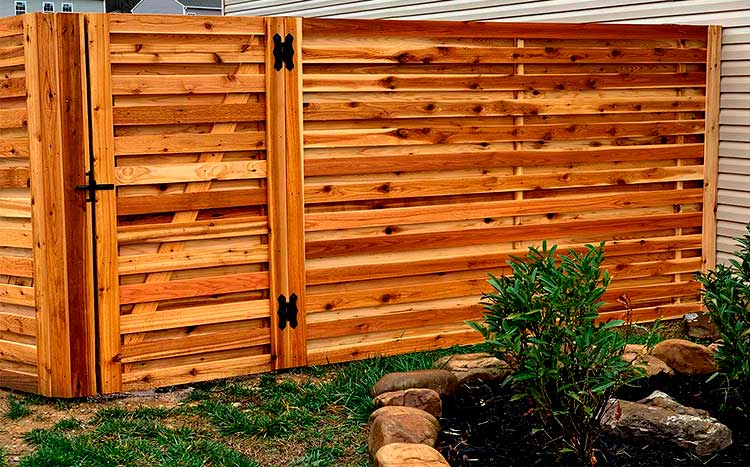
When it comes to fencing materials in the United States, aluminum and wood are both in high demand due to their dependability and cost. Which factors should be considered when choosing between these two options?
Wood fences are relatively inexpensive as compared to aluminum. However, being a metal, aluminum has a relatively longer lifespan compared to wood. Both fencing materials are widely available across the United States.
Certain factors need to be considered such as maintenance, privacy, style, cost and other factors listed below before you find an option that works for you.
| Metal | Wood | Winnner | |
|---|---|---|---|
| Cost | $45 Per linear ft. | $23 Per linear ft. | Wood |
| Durability | 25 Years | 40 Years | Wood |
| Maintenance | Zero | Needs re-sealing | Metal |
| Easy of installation | Moderate | Easy | Wood |
| Eco choice | Non-sustainable resource | Literally grows on trees | Wood |
| Security | Excellent | Moderate | Metal |
| Design options | Limited | Wide variety | Wood |
| Adds value to a home | Yes | Yes | Even |
| Sound reduction | Limited | Moderate | Wood |
The winner?
In my view, wood fences have the edge over Aluminum fences due to a lot of factors such as:
- Wood fence Cost
- Maintenance cost
- Traditional look
- Easy of repair
- Style choices
You can get wood fencing material as modern engineered wood, bamboo, cedar, redwood, and myriad other varieties or species depending on your location. On the other hand, there is not much to choose from if you go for aluminum or any other metal.
That said, aluminum fencing is readily available and is also a relatively inexpensive fencing material. If modern and clean is the look you are after, then Aluminum might be the best one for you.
Cost of Aluminum vs Wood Fence
| Material | Aluminum | Wood (average cost) |
|---|---|---|
| Low (per linear foot installed) | $20 | $10 |
| High | $27 | $15 |
Maintenance
Both aluminum and wood fences need proper maintenance to last. Both materials have a finite lifespan which largely depends on the climate and how they are maintained.
Wood fences are going to need sealing every 5 – 7 years with a wood oil or a lacquer.
Aluminum fences will most likely need a respray or powder coat every 10 – 15 years .
Although more work, it is a lot cheaper to stain or paint a timber fence every 5 – 7 years than it is to have your aluminum fence power coated.
Installation
It is important to follow the installation guidelines and best practices when installing wooden or aluminum fences. Professional fence installers can save you a lot of money in the long run by following these best practices as opposed to if you were doing it yourself. Most installation services also offer warranties for their work.
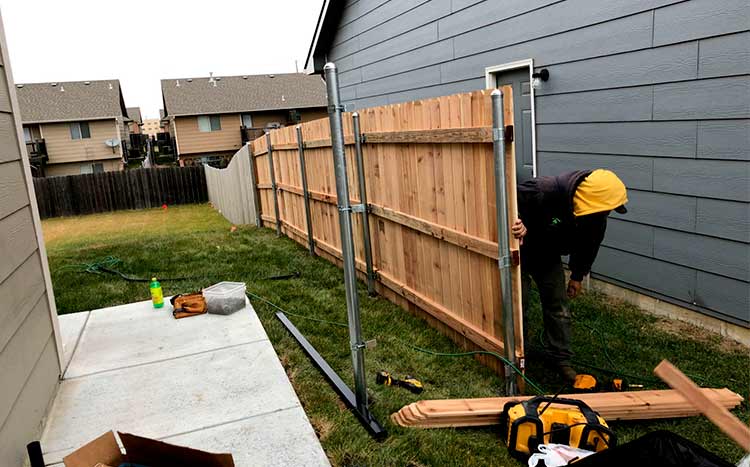
Durability
Both aluminum and wooden fences can withstand the elements well. Wood fences have a typical lifespan of 12 to 16 years. Aluminum fences can last for many decades (over 50 years) depending on the quality of the aluminum. You can extend the life of your wooden or aluminum fence through regular maintenance.
Security
Aluminum fences generally offer better security because they are harder to breach as compared to wood fences. However, this depends on the design of the fence, how it is installed, and its intended purpose.
Some aluminum fences are installed for aesthetic purposes and offer little security, while some wooden fences can deter trespassers and thieves because of their height and overall design.
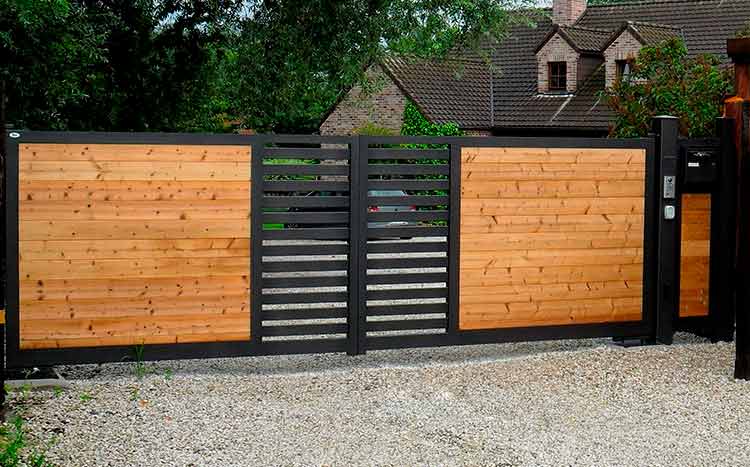
Adds Value
While this depends on factors such as the length of the fence and design, aluminum fences generally add more value to your house as compared to wood. Aluminum and other metallic fences are more durable (will last a lifetime) and more functional. Expect to spend between $3000 to $8000 or more to install an aluminum fence and a 40% to 50% expected ROI.
Privacy
Wood fences generally offer more privacy because they form an opaque barrier between your yard and the street or neighboring lot. However, it is also possible to install opaque aluminum fences albeit at a significantly higher cost. Also, keep in mind that most fence codes prohibit or restrict the height and opaqueness of residential fences in urban areas.
The Pros and Cons of Aluminum Fencing
Pros
Durability- Aluminum fences have a longer lifespan than wood.
Strength- Aluminum is a strong metal that is hard to breach without the help of power tools. However, aluminum does bend more easily as compared to other metals such as wrought iron.
Low-maintenance – aluminum fences do not need as much maintenance over their lifespan as wood fences or other alternatives. This provided there no physical damage from impact or pressure from external sources such as trees and stacked objects.
Aluminum is readily available- You can walk into any hardware store across the country and you are bound to find all types of aluminum fencing boards and posts plus other installation components. On the other hand, wood is less available and you may be limited to a particular type based on your location.
Pest and mold-resistant- Being a metal, aluminum is not adversely affected by pests, mold, or other organic agents. You may, however, need to horse your fence regularly to preserve its surface appearance and to prevent long-term discoloration or accelerated corrosion due to high moisture absorption.
Cons
Low privacy- Aluminum fences are generally installed as a barrier and for aesthetic purposes. They don’t offer much privacy because of the gaps between posts. However, you can still install a fully opaque fence if you are after privacy and security.
Different qualities- You must be very careful about the aluminum fencing materials you purchase. It’s easy to purchase low-quality alloys that do not last as long as expected.
High cost – Aluminum is more expensive than wood.
The Pros and Cons of Wood Fencing
Pros
Aesthetics – Wood fences are attractive and give your yard that classic, elegant look.
Affordability – Wood can be the most affordable type of fence in places with well-established lumber industries.
Easy to install – Wood fences are the easiest to install as they don’t require any special tools or skills. You can install a simple wooden fence with a few yard tools on your own.
Environmentally friendly – Wood, where it is produced sustainably, is an environmentally friendly fencing material because it can be recycled and reused.
Cons
Durability – Wood is less durable than other fencing options such as metal, stone, or vinyl
Maintenance – It requires more maintenance such as painting. It is also more prone to mold and pests such as termites especially as it ages.
Strength – Wood fences are easier to breach even without the use of power tools as compared to alternatives.
Wood Fence Maintenance tips
Some of the things you need to do to keep your wooden fence in good condition over its lifespan include:
Annual Inspections and repairs
It is important to do a visual inspection of your wooden fence regularly. Check if there are repairable issues such as broken sections or panels, rotting sections, loose nails, or mold-infested patches. Do these minor repairs to prevent further damage to neighboring sections or panels.
Staining or repainting
You may need to re-stain your wooden fence with oil-based wood stains to protect the surface from external elements such as rain and dust. It is recommended to apply at least two coats for semi-transparent stains or one stain for solid color stains on wooden fences.
Re-staining can be done every three to five years or when needed based on the condition of the wood surface. The best time of year to stain your wooden fence is later spring or fall when humidity and temperatures are ideal for drying.
Also, treat mold or mildew patches on the fence before you stain or paint it to prevent the mold spores from spreading even after you have stained or repainted the wood. Exterior mold or pests left untreated can significantly reduce the lifespan of your fence.
Pressure Washing
As part of your regular maintenance
schedule, ensure you pressure wash the entire wood fence to get rid of dust, dirt, pests, and mold. Mix the water with a mold-removing solution or pest killer for even better results. Fence cleaning can be done more regularly based on the condition of the fence and weather conditions.
Aluminum fence maintenance tips
Regular Washing/Hosing Down
Regularly clean your aluminum fence with water or water mixed with chemicals to get rid of grime, mold, and other unwanted substances. If left to accumulate, some of these substances can significantly discolor or even corrode the fence.
Take Care of Moving Parts Such as Gates
Ensure that moving parts on the fence such as gate hinges are working properly. Make the necessary adjustments and leveling as part of your regular preventive maintenance. Also, make sure that these moving components are properly secured at all times to prevent swinging and banging.
Which adds more value to a house?
According to most real estate agents, fences add value depending on the condition of the fence and the homeowner’s needs.
For instance, homeowners with kids or pets will look for more privacy. As such, wooden fences will add more value to the home. Metal fences add value to the home if they’re well-maintained and add curb appeal.
Which will give you more privacy?
Wooden fences. Thanks to the wood planks, a homeowner can install a closed fence that completely shuts your home from the outside world. Metal fences may be strong, but their open construction design makes them a poor choice for privacy.
Which is best for sound reduction?
Generally, the thicker the fence is, the better it servers as a noise barrier. Therefore, most wooden fences are better for sound reduction compared to open metal fences.
FAQ's
Does Aluminum Fence Bend Easily?
Aluminum is a relatively light metal and therefore does tend to bend more easily as compared to other metallic fences such as wrought iron or steel. However, it still offers more security and strength compared to wood or vinyl.
Is Steel or Aluminum Fencing Better?
Steel fences are stronger and more durable than aluminum. However, steel is much more expensive compared to aluminum or any other material.
Which Wooden Fence Is the Best?
Engineered wood fences offer better value for money in the long term because they are made to last. However, you can still get good service from natural wood if it is more available and less expensive locally.
Do Aluminum Fences Rust?
Treated aluminum fences do not rust as much if well maintained. Aluminum fence boards and posts are rated for exterior use and can withstand high moisture levels. You should, however, hose them down to remove grease, mold, and dirt that may affect their surface integrity over time.
Which Fence Lasts the Longest?
Stone and metallic fences last the longest because of their strength and weather resistance. You can expect a metallic or stone fence to last for a lifetime if well maintained and protected from physical impact.
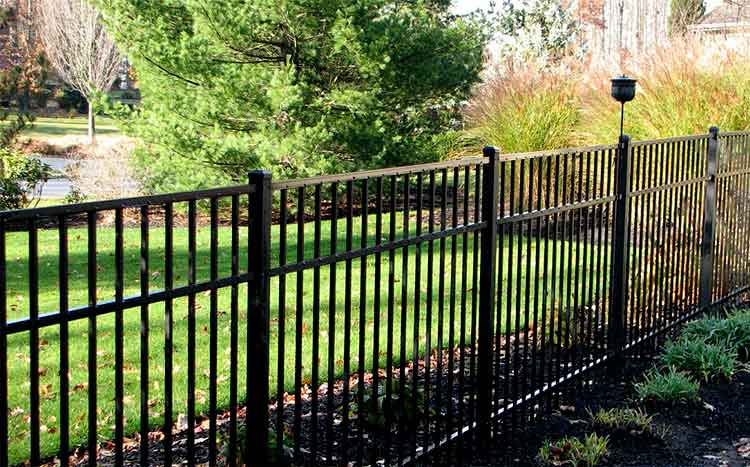
When it comes to fencing, Wood and Vinyl are usually considered as the top choices. Wood is generally preferred because it has been widely used in the fencing industry. Nonetheless, Vinyl, a more recent material, has become available thanks to technological developments.
Vinyl is thus considered to be a better fencing material than wood due to its ability to last for long periods of time with little to no maintenance. It is also completely resistant to wood-specific challenges which include termites, fungi, fire and rot.
The only drawback which may be experienced when looking to fence with vinyl is its financial expense which is relatively higher than that of wood.
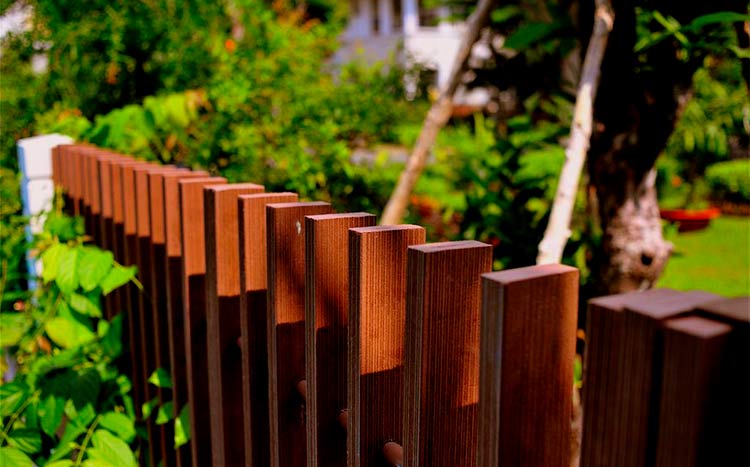
Cost of wood and vinyl
| Material | Low | High |
|---|---|---|
| Vinyl | $10 per linear foot | $60 per linear foot |
| Wood | $1-$5 per linear foot | $45 per linear foot |
Durability of vinyl and wood fences
Vinyl is generally known to outlast wood even though it costs about $5 more per linear foot when compared to its wooden counterpart.
This is because it is resistant to threats such as weather, insects, and rot which normally affect wooden fencing. It also does not become bent in appearance or pale in color as long as it is periodically cleaned as needed.
Wood fencing on the other hand is estimated to require complete replacement after 1-2 decades. Maintenance in terms of cleaning, treating, staining, and sealing is actually extremely essential for it to last that long.
It is also prone to warping and decaying as a result of weather, insects, mildew, and moisture.
Pros and cons of using Vinyl
Pros
Little to no Maintenance
Vinyl fencing is generally considered maintenance-free since it does not require activities such as painting, staining and sealing to keep it in check. It only requires periodical cleaning so as to keep it free from mold and mildew stains.
Natural Appearance
The artificial PVC make up of vinyl does not mean that it cannot look like traditional wood in appearance. This is because high-quality vinyl fences such as wood-grain are normally designed using traditional shades of color which resemble natural wood.
Long-Lasting
The durability of vinyl when it comes to fencing is unparalleled. This is because vinyl fences are usually able to stand strong in the face of rot, fungal growth and blisters which are known to cause damage to wooden fences.
Their artificial nature also makes them resistant to any cracking or splitting that may be as a result of weather or old age. Vinyl fencing is also fire, pest and insect resistant due to its inorganic and non-biodegradable features.
Easy to Install
Once the posts have been set, vinyl fencing is relatively easy to install. Although each panel is installed individually, the snapping together of subsequent pieces makes the process rather simple. If everything goes well, tools are usually not required.
Cons
Frequent Expansion and Contraction
Vinyl fencing is usually known to expand and contract as a result of temperature changes in the environment. It thus becomes more fragile when this process is repeated over time. Little or no space between vinyl panels also makes them susceptible to wind damage.
Large Upfront Investment
Vinyl fences generally cost between 2-3 times more than their wooden counterparts in terms of their initial price. They however prove to be cheaper in the long term since they do not require the maintenance investment that wooden fences do to stay in check.
Mold Staining
Vinyl fencing is susceptible to mold and mildew staining especially in cases where it is not periodically cleaned.
Pros and cons of using Wood
Pros
Low Initial Cost
The cost of wood fencing is generally known to be cheaper than vinyl in the short term. This is mostly because wood is a naturally available material as opposed to vinyl which must be industrially manufactured.
Flexibility
Wooden fencing is generally known to be more flexible when compared to vinyl due to its adjustable nature. In other words, the lengths of wooden fences can be changed to fit the owner’s preferences after they have been ordered which is not the case for vinyl.
They are also relatively easy to install and remove since manufacturers provide pre-assembled pieces of fencing.
Visual Appeal
Wooden fences still take the lead as far as visual appearance is concerned despite the mimicking effect of high-quality vinyl fences. They are thus preferred due to their rather traditional look which enables them to effortlessly blend into the environment.
Biodegradable
Wood is certainly the greenest option as far as fencing is concerned. This is because of its organic features which make it completely biodegradable, recyclable, and renewable.
Cons
Expensive in the Long Term
Wooden fencing is generally considered to be more expensive in the long term since it requires periodic maintenance. This maintenance normally comes in terms of painting, staining and sealing.
It is also not as durable as vinyl fencing which means that it may require a complete replacement after 10 years or so thus adding to its expense.
High Number of Vulnerabilities
Wood is generally affected by a wide range of factors which include fungi, rot, weather, pests and insects. It is such factors that make it loose visual appeal and structural credibility over time. This is normally manifested in terms of fading, cracking and warping.
Wooden fences are also known to be quite vulnerable to damage by fire since they are considered to be natural fuels.
Maintenance of vinyl and wood fence
Vinyl fencing is generally considered to be better than wood when it comes to maintenance. This is because it does not require procedures such as sealing, painting and staining which are normally applied on wood.
It however still requires periodic cleaning in the form of rinsing, soft-brush scrubbing and detergent washing if it is to maintain its charming appearance. Pressure washing can also be used in cases where the fence is extremely stained with dirt and mold.
Wood on the other hand generally requires a little more maintenance effort since it is highly susceptible to mildew, rot and insect damage. Staining is known to combat rot as long as it is done on a clean and dry wooden fence.
Painting is a cheaper option to staining because paint is prone to periodic cracking and peeling. It is thus advisable to apply it on a sanded and smoothened wooden fence for a greater long-lasting effect.
Both painting and staining can be complemented by sealing. Sealing is known to protect wood against rainy and moist weather conditions which facilitate mold growth and rotting.
Installation time
Wooden fences normally take an average of 3 days to put up for perimeters of between 100 and 200 feet. This time is usually inclusive of pre-installation preparation and post-installation clean up. It can however vary depending on weather and structural adjustments.
Vinyl fences on the other hand take an average of two days to install for 150-200 feet long perimeters. This is because they normally come in panels of fixed lengths that do not require adjusting. They can however also take longer to install in adverse weather conditions.
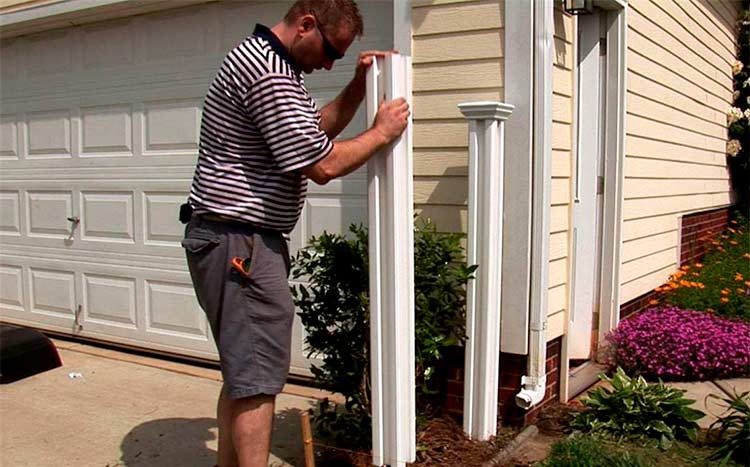
Effects on home value
Both wooden and vinyl fences can increase the value of a home. This is because they are able to provide an aesthetic appeal that can easily attract buyers. They can even give as much as 50% return on investment upon the sale of a house.
A new owner who decides to put up a new fence can also recoup up to half of the initial cost of the wood and vinyl upon resale.
There are however cases in which other real estate factors such as unique client preferences and curb appeal override the covering offered by both vinyl and wooden fences. In such situations, these fences usually have little to impact on the value of a home.
Repair
Repairing a wooden fence normally involves replacing rotten pieces and posts as well as broken rails. Wood is generally known to be heavier than vinyl and thus requires more effort when it comes repairing.
Vinyl repair may however take more time and resources since it demands the replacement of an entire panel when a single piece breaks. This is unlike wood repair which only factors in the replacement of the broken piece or post.
Engaging professionals is thus encouraged in both when looking to achieve optimum vinyl or wood fencing.
Home Garden Guides is a great tool that quickly matches you with the best fencing specialists in your locality. You can get three estimates from local fencing professionals in a matter of two minutes. Kindly follow the steps below to enjoy this great service:
- Scroll to the top of the page and enter your zip code
- Answer questions about your drywall job
- Your fencing details are forwarded to three local experts who will send you a price estimate for your job with some friendly advice.
Choosing between Vinyl and wood fences
When looking to get a beautiful and durable fence that does not require a lot of maintenance, vinyl is definitely the way to go. It may be more expensive initially but that cost will most certainly be justified in the future.
FAQ's
Does a vinyl fence increase home value?
Yes, it does, but not all of the time. A new vinyl fence has the capacity to enhance a home’s visual appeal which will inadvertently attract more buyers. This increase in traffic is most likely to increase the price of the home in question.
There are however cases in which a newly installed vinyl fence does not provide the expected return on investment. In such situations, other real estate factors such as comparability and buyer preferences usually edge out the fence in terms of weight.
Do vinyl fences break easily?
Vinyl fences generally do not break easily unless subjected to head-on collisions with hard objects such as stones and metals.
Which is harder to maintain, vinyl or wood?
Wood is definitely harder to maintain when compared to vinyl. This is because of how vulnerable it is to factors such as weather, mold, rot and insects. This vulnerability means that it must be subjected to periodic staining, painting and sealing so that it stays in shape.
Vinyl on the other hand only requires regular cleaning with water and detergent in order to maintain its visual appearance.
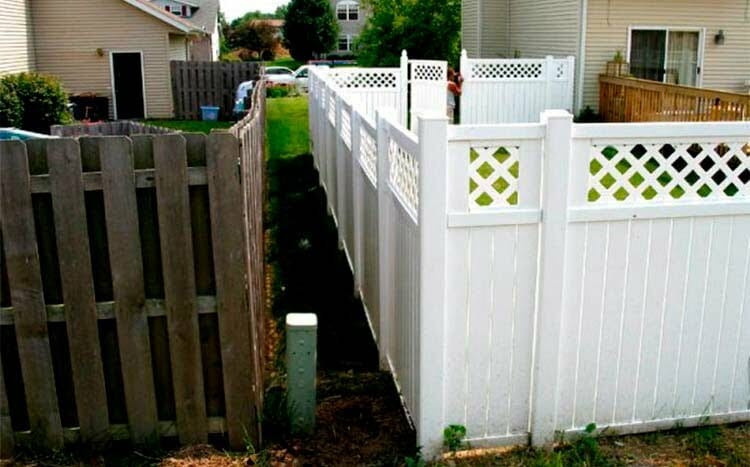
Wooden posts are a popular pick for folks wanting to boost their home’s privacy and safety. Many worry if sticking them in concrete will cause them to rot away.
While it is true that wooden fence posts can rot when set in concrete, there are steps that can be taken to prevent this. One of the causes of rot is moisture, which can seep into the wood and cause it to decay.
This is why it is important to choose the right type of wood and to use pressure-treated lumber, which is resistant to rot and decay.
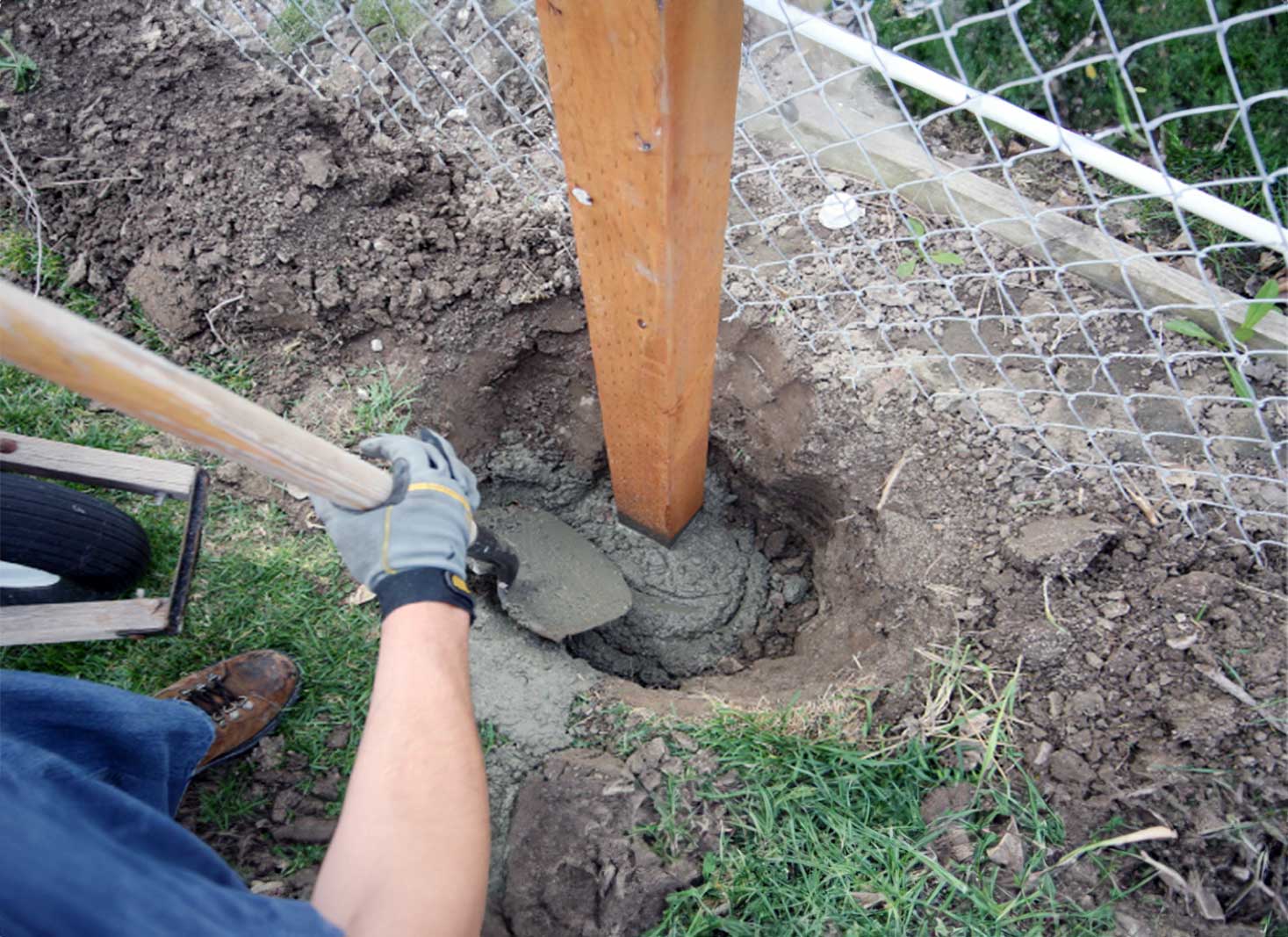
Understanding wood rot
Wood rot is a natural process that occurs when wood is exposed to moisture and air. It is a type of fungal decay that breaks down the wood fibers, causing it to weaken and eventually disintegrate.
Rot can occur in any type of wood, including treated wood, and it is a common problem for fence posts that are set in the ground.
Moisture
The primary cause of wood rot is moisture. When wood is exposed to moisture, it creates an ideal environment for fungi to grow and thrive. The fungi feed on the wood fibers, breaking them down and causing the wood to rot.
In addition to moisture, other factors that can contribute to wood rot include poor ventilation, high humidity, and warm temperatures.
Types of wood rot
There are several types of wood rot, including brown rot, white rot, and soft rot. Brown rot is the most common type of rot and is characterized by a brownish discoloration of the wood.
White rot, on the other hand, causes the wood to turn white or yellow and is less common than brown rot. Soft rot is a type of rot that only affects the outer layer of the wood and is usually caused by bacteria.
Preventing wood rot
Preventing wood rot is essential for preserving the life of your fence posts. One way to prevent rot is to use treated wood. Treated wood is wood that has been infused with chemicals that make it resistant to rot, insects, and decay.
Another way to prevent rot is to ensure that your fence posts are installed properly. This includes setting the posts in a concrete base that is above ground level to prevent water from pooling around the post.
Factors that contribute to wood rot in concrete
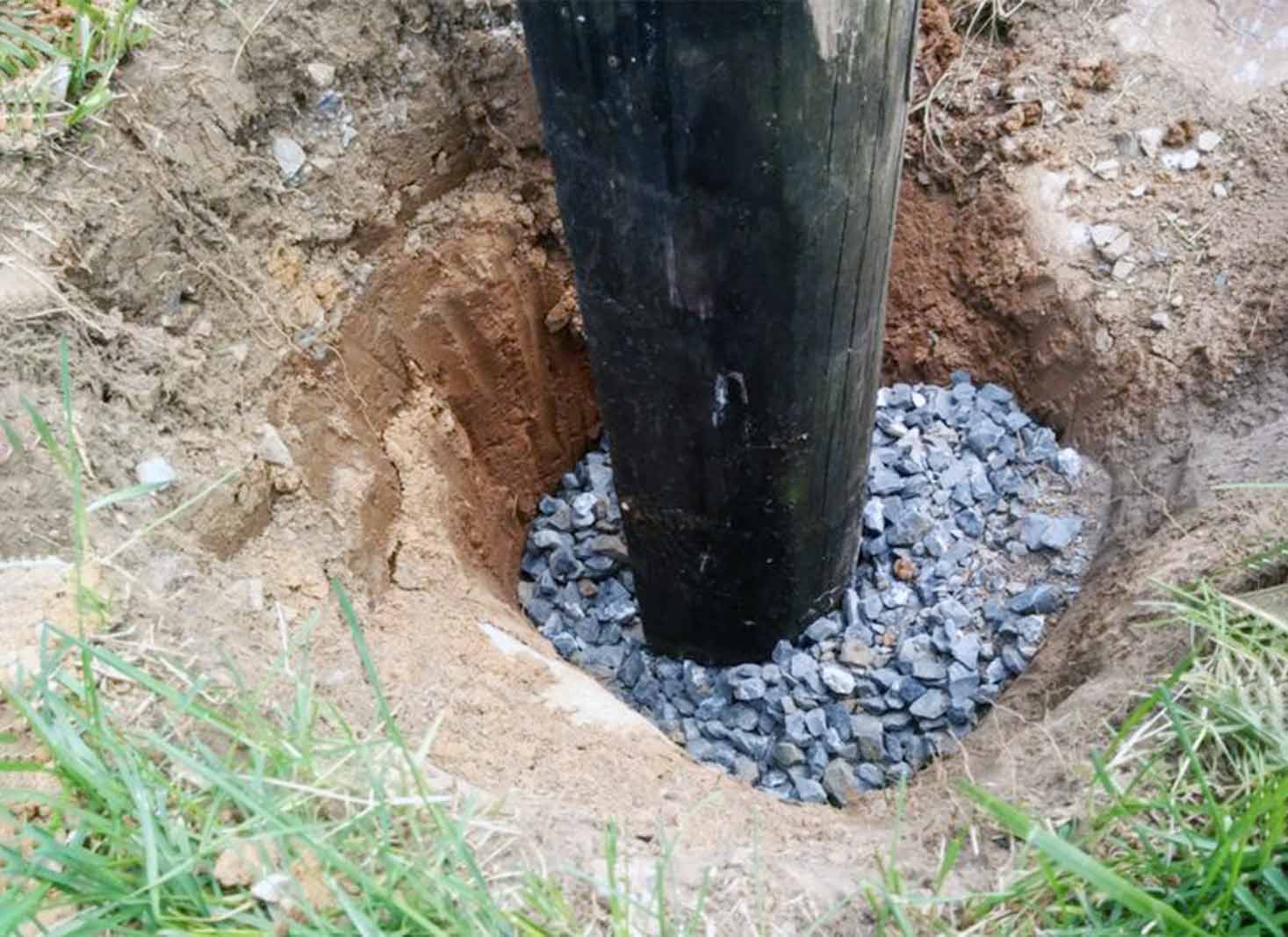
Wooden fence posts are commonly set in concrete to provide stability and support. However, over time, wood rot can occur, leading to weakened fence posts and the need for costly repairs or replacements.
Several factors can contribute to wood rot in concrete, including moisture levels, type of wood, and concrete quality.
Moisture levels
Moisture is one of the primary factors that contribute to wood rot in concrete. When wood is exposed to moisture for extended periods, it can lead to fungal growth, which causes the wood to decay.
The moisture levels in the concrete can also affect the wood’s moisture levels, which can accelerate the rotting process.
Type of wood
The type of wood used for fence posts can also affect the likelihood of wood rot in concrete. Some types of wood, such as cedar and redwood, are naturally resistant to decay and rot due to their natural oils and tannins.
Other types of wood, such as pine and spruce, are more susceptible to rot and decay and may require additional treatments or coatings to prevent rot in concrete.
Concrete quality
The quality of the concrete used to set fence posts can also affect the likelihood of wood rot. Concrete that is mixed with too much water can lead to excessive moisture levels, which can accelerate the rotting process.
Additionally, concrete that is not properly cured or is exposed to freeze-thaw cycles can crack and allow moisture to penetrate, leading to wood rot in concrete.
Homeowners and contractors should consider these factors when selecting materials and installing fence posts to ensure the longevity and stability of their fence.
Preventing wood rot in concrete fence posts
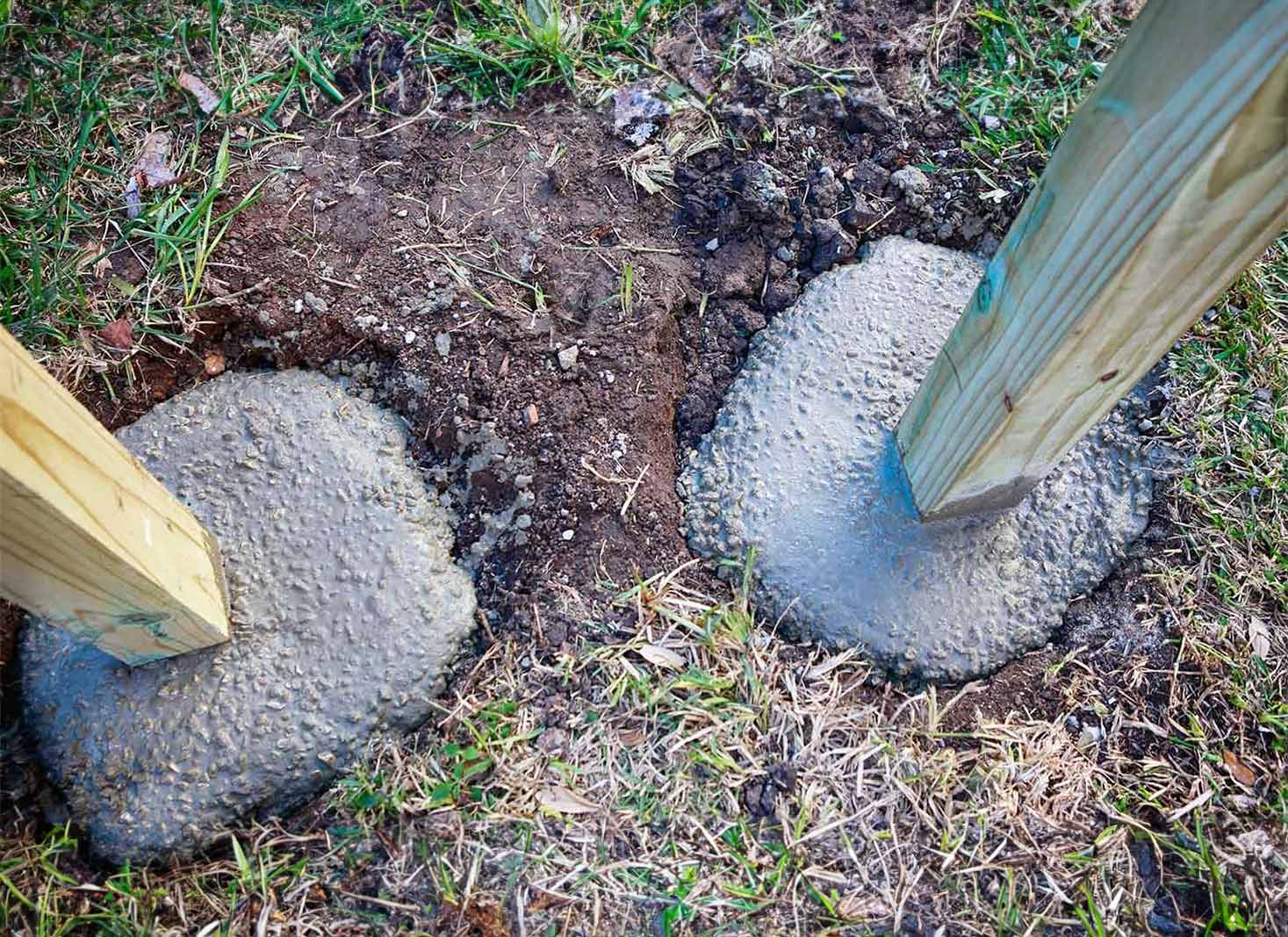
Wooden fence posts are a popular choice for many homeowners, but they can be prone to rotting when they come into contact with concrete.
This can cause serious damage to your fence and even compromise its structural integrity. Fortunately, there are ways to prevent wood rot in concrete fence posts.
Use of treated wood
One of the most effective ways to prevent wood rot in concrete fence posts is to use treated wood. Pressure-treated wood is pre-treated with preservatives that help resist the rot caused by moisture and other elements.
Alternative options to pressure-treated lumber are Western red cedar, white cedar or black locust, cypress or redwood. These types of woods are naturally resistant to rot and decay, making them a great option for fence posts.
Proper installation techniques
Proper installation techniques can also help prevent wood rot in concrete fence posts. When installing a fence post, it’s important to ensure that it is properly anchored in the ground.
This can be done by digging a hole that is deep enough to accommodate the post and filling it with gravel or crushed stone. This will allow for proper drainage and prevent water from pooling around the post.
Another important factor is to ensure that the post is not in direct contact with the concrete. This can be done by placing a piece of plastic or rubber between the post and the concrete.
This will help prevent moisture from seeping into the post and causing rot.
Regular maintenance
Regular maintenance is also important in preventing wood rot in concrete fence posts. This includes inspecting the posts on a regular basis and looking for signs of rot or decay.
If any damage is found, it should be repaired immediately to prevent further damage.
Additionally, the fence should be cleaned and sealed on a regular basis. This will help prevent moisture from seeping into the wood and causing rot. Sealing the wood will also help protect it from the elements and prolong its lifespan.
By using treated wood, proper installation techniques, and regular maintenance, you can help prevent rot and decay and enjoy your fence for years to come.
Signs of rot in wooden fence posts

Wooden fence posts that are installed in concrete can be prone to rotting. Rotting is caused by exposure to moisture, fungi, and insects. The following are some signs that wooden fence posts are rotting:
- Discoloration: The wood may appear darker or lighter than normal, or it may have black or green spots.
- Softness: The wood may feel soft or spongy to the touch, and it may be easy to push a screwdriver or other tool into it.
- Cracks or splits: The wood may have cracks or splits that are visible on the surface, or it may be splitting apart.
- Mushrooms or fungi: Mushrooms or fungi may be growing on or around the base of the fence post.
- Insect infestation: Termites, carpenter ants, or other insects may be present in the wood, or there may be visible holes or tunnels in the wood.
If any of these signs are present, it is likely that the wooden fence post is rotting and needs to be replaced.
Rotting fence posts can compromise the structural integrity of the fence and make it more vulnerable to damage from wind, rain, and other elements.
Preventive measures such as using pressure-treated wood, applying a protective coating, and ensuring proper drainage can help prevent rotting.
However, if rotting has already occurred, it is important to take action as soon as possible to avoid further damage.
How to replace rotted fence posts

Wooden fence posts can rot over time, especially when they are anchored in concrete.
If you notice that one or more of your fence posts are rotten, it’s important to replace them as soon as possible to prevent further damage to your fence.
Here are the steps to replace rotted fence posts:
Remove the old post: Start by removing the old fence post. If the post is anchored in concrete, you may need to dig around it to loosen it. Once the post is loose, remove it from the ground.
If the post is not anchored in concrete, you may be able to simply pull it out of the ground.
Prepare the hole: Once the old post is removed, you’ll need to prepare the hole for the new post. If the hole is filled with concrete, you may need to dig it out to create a new hole.
Make sure the hole is deep enough to support the new post.
Install the new post: Place the new post in the hole and make sure it is level. You may need to use a level to ensure that the post is straight. Once the post is level, fill the hole with concrete and allow it to dry.
Attach the fence: Once the concrete has dried, you can attach the fence to the new post. Make sure the fence is level and secure.
It’s important to note that if your fence posts are rotting due to being anchored in concrete, you may want to consider using a different anchoring method in the future.
For example, you could use metal fence posts or use a different type of concrete mix that is less likely to cause rot.
Replacing rotted fence posts is a simple process that can help extend the life of your fence. By following these steps, you can ensure that your fence remains secure and functional for years to come.
FAQ's
There are several effective ways to protect wooden fence posts from rotting when set in concrete. One way is to use pressure-treated wood, which is specially treated to resist rot and decay.
Another way is to use a wood preservative, which can be applied to the wood before it is set in concrete. Additionally, creating a drainage system around the base of the post can help prevent water from collecting and causing rot.
While setting fence posts in concrete is a common method, it is not the only way to prevent rot.
Other methods include using gravel or crushed stone to create a drainage layer at the base of the post, using post anchors that elevate the post above the ground, or using composite materials instead of wood.
The best type of wood preservative to use for fence posts will depend on several factors, including the type of wood being used and the climate in which the fence is located.
Copper naphthenate and creosote are both effective preservatives that can be applied to the wood before it is set in concrete.
The lifespan of wooden fence posts when set in concrete can vary depending on several factors, including the type of wood used, the quality of the concrete, and the climate in which the fence is located.
Generally, pressure-treated wood can last up to 40 years when properly maintained, while untreated wood may only last 10-15 years.
Some alternative materials or methods to use instead of concrete to prevent fence post rot include using post anchors, which elevate the post above the ground, or using composite materials instead of wood.
Additionally, creating a drainage layer at the base of the post using gravel or crushed stone can help prevent water from collecting and causing rot.
There are several types of paint or coatings that can be used to protect fence posts from decay when set in concrete. Oil-based paints or stains can provide a protective layer that helps prevent water from penetrating the wood.
Additionally, epoxy coatings or sealants can be applied to the wood before it is set in concrete to provide an extra layer of protection.
What is the price of a hog wire fence that features a metal wire grid encased in a wooden frame?
Installation of hog wire fence with wooden frame will cost between $3 and $10 per linear foot. The height of the fence, size of the land and quality of the wire will determine how much you will pay in total.
Each fence installation project is unique. Let us see more about the cost of installing a hog wire fence with a wooden frame.
How Much Does Hog Wire Fence Cost
| Parameter | Cost (per ft.)* |
|---|---|
| Cost per foot | $3 - $10 |
| Cost per acre | $2,500 - $8,400 (per acre) |
| Frameless | $2 - $3 |
| Framed | $3 - $10 |
| Metal frames | $5 - $60 |
Cost factors for hog wire fences with a wooden frame
Size Of The Land
The larger the land you want to fence, the more you will pay.
It costs $2,000 to $8,000 to fence an acre with a hog wire fence with a wooden frame. You will pay $600 to $2,400 to fence a ¼ acre.
A large plot means that you will require more wood and metal. It also means that it will take more time to install the fence. Therefore, it will cost you more.
Height Of The Fence
The higher the fence, the more it costs to install. You can install a 4 to 8-foot fence. The purpose of the fence determines its height. The higher the fence, the safer it is.
An 8-foot hog wire fence is more expensive to install than a 6-foot fence. It uses longer wooden frames which increase the cost of the fence significantly.
Additionally, you require more wire to frame.
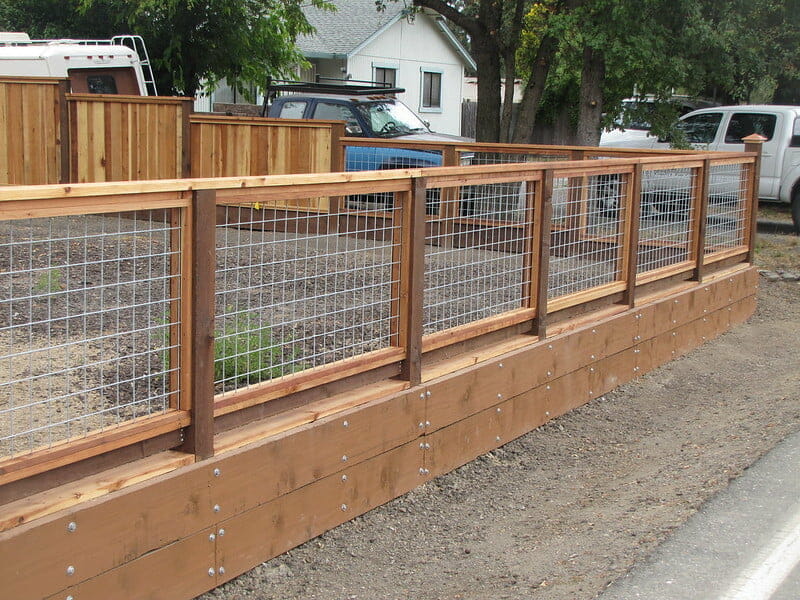
Framed Hog Wire Fence | Guy Aranda | Wikimedia Commons | CC BY-SA 2.0
Material Of The Fence
Hog wire fence consists of two types of material with varying costs. Metal wire and wood.
There are many types of metal or hog wires you can purchase for your hog wire. Different types of metals have different prices.
Similarly, you can purchase many types of wood frames for your frames. Different types of wood also have varying prices.
Types Of Hog Wire Fences
Frameless Hog Wire Fence
Frameless hog wire fences are composed only of the metal wire grid.
Framed Hog Wire Fence
A framed hog wire fence can either have wooden or metal frames. The metal grid has a frame all around it.
Pros Of Installing A Hog Wire Fence With Wooden Frames
- Keeps pets and other animals safe and within the compound.
- Grow plants and flowers on the fence.
- Easy to install
- Affordable to install.
- Easy to decorate
- Attractive even without decoration.
- You can move them easily if you want.
- Easy to maintain.
- Easily adapts to the environment
- Durable. Hog wire fences with wood or metal frames can last 25 to 50 years.
Cons
- Does not offer total privacy.
- Temporary fences
- Need to trim the top to avoid injuries.
- Allows small animals and pests through.
- Cannot be electrified
What Size Does Hog Wire Come In
Hog wire fence is available in 100-foot panels. You can also purchase it in 3 to 8 feet in height.
The price varies with height. The taller the fence, the more you will pay to install.
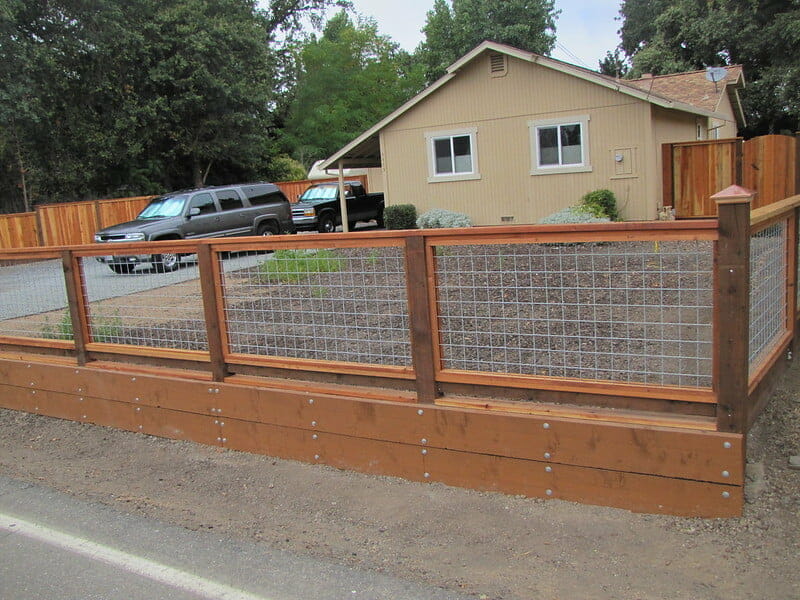
Hog Wire Fence | Guy Aranda | Wikimedia Commons | CC BY-SA 2.0
How To Maintain Your Hog Wire Fence With Wooden Frame
The most important aspect of maintenance on the hog wire fence is to keep the wooden frame intact.
- Ensure that the wood is chemically treated. It ensures that it keeps away pests that may cause it to rot.
- Keep water away from the fence. Wood absorbs water to increase its moisture content. High water levels in the wood weaken it and cause it to break and damage easily. Ensure that there is proper drainage around the fence.
- Stain the wood to prevent rot and decay. Apply a coat of primer for the wood to absorb the stain easily. Anual staining or painting keeps the fence in good condition.
- Regular inspection to ensure that the wire grid is firmly in the frame.
- Go for high-end wood types that are pest resistant.
DIY v Hiring A Professional Fence Contractor To Install A Hog Wire Fence With Wooden Frames
Materials for a hog wire fence with wooden frames are cheap to buy. If you have the skills and tools, you can DIY the installation as it will save you money.
However, if you do not have the right tools and skills for fence installation, hire a pro. They will finish the installation perfectly and on time.
Benefits Of Hiring A Pro To Install Your Fence
- Allows you time to do other things.
- They have the right tools for the job and they do not charge you to use them as you would have happened in a DIY situation.
- Professional. They carry a license and insurance to pay for accidents and damage.
- There are no mistakes during installation. If they happen, the professional will correct them without a charge to you
How to save money on your fencing project
- Buy cheap fencing materials.
- Make accurate estimates.
- DIY.
- Carry out prior preparation yourself.
- Price survey. Collect quotes from at least three fence installation pros.
A fence is essential for any household as it acts as a safeguard against outside factors. There are different materials utilized in building fences, with wood being a popular choice. It is the preferred option for many communities due to its attractive appearance, durability, and longevity.
Proper installation, care, and maintenance of your wooden fence ensure that it serves you a long time. Regular inspection, repair of damage, repainting, and maintenance extend the life of a wooden fence.
A wooden fence can serve its purpose for up to 20 years. Your fence needs you to take proper care of it to last as long as recommended. Here’s how to extend the life of your wooden fence.
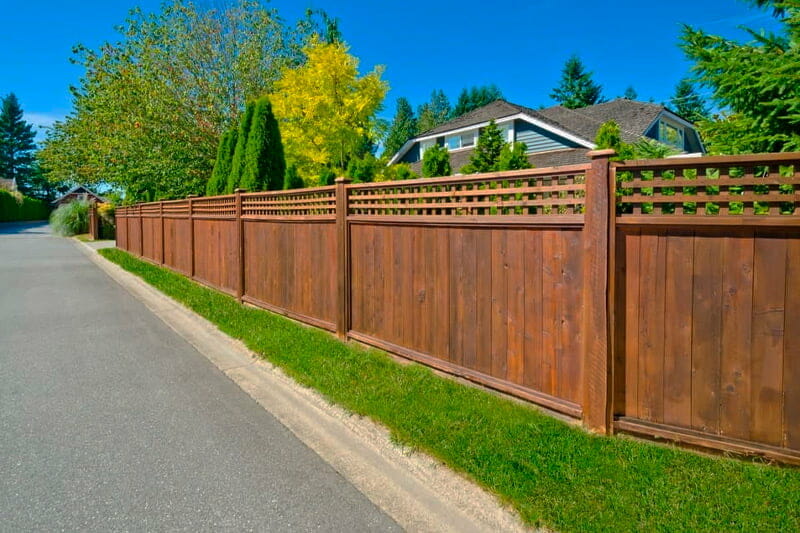
How To Extend The Life Of Your Wooden Fence
Repair Damage Quickly
One way of extending the life of your fence is regular inspection. You will identify parts of the fence that are damaged or have lots of wear and tear.
When you identify damaged areas, don’t wait. Act fast to repair the fence. If you can’t do it by yourself, get a professional to do it for you.
Clean/ Pressure Wash Your Wooden Fence regularly
Another way to extend the life of a wooden fence is a regular wash. Wash your fence every 3 to 5 years or fewer.
Mold and mildew are likely to grow on your wooden fence due to weather factors. Only a strong pressure wash can remove the mold growing on your fence. Mix your cleaning water with a mold killer before you use a pressurized washing machine to spray it onto the fence.
Once your fence is clean, apply a water-repellent coating. The coating will prevent the wood from absorbing moisture which causes the growth of mold and mildew.
A clean fence enhances the curb appeal of your property. Regular cleaning ensures that the fence remains strong enough to remain standing for a long time.
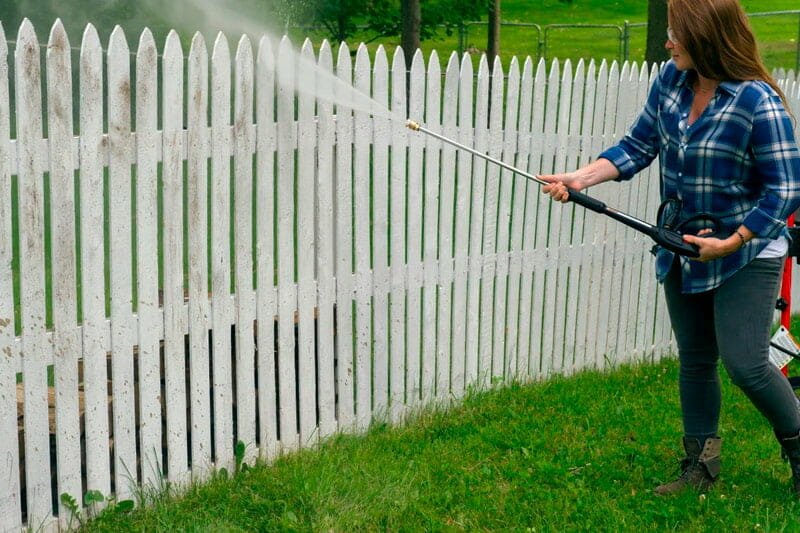
Seal your fence
Stain your fence as regularly as you clean. Apply a coat of stain on your wooden fence after every pressure wash.
Only use oil-based stains for wood for your fence. First, make sure that your fence is clean and has no mold or mildew growing on it. Also, ensure that it is dry before you apply a coat of waterproof stain.
Staining a well-looked-after wooden fence ensures that it lasts long and looks good. Staining protects the wood when the paint peels off. The wood stain goes deeper into the wood and doesn’t peel off as easily as paint.
Use a single layer of stain when you use colored stain and two layers when you use colorless stain.
Be careful when you stain your wooden fence. Staining and washing wooden fences is best done in spring. There’s not much humidity in the air and the wooden fence dries faster and to the required levels for the application of paint. Leave it to dry for about a week before you can apply the stain.
Staining your wooden fence is better than painting it. Once the stain is absorbed into the wood, it cannot peel off. Thus, providing more protection n the long term than paint.
Regular Oiling of Hinges And Other Movable Parts
To make sure that your wooden fence lasts long, oil all parts of the fence that move regularly. If you have a gate on your fence, make sure the hinges are properly oiled. It ensures that the gate swings open and shut easily
If you stay too long without oiling the hinges, they may crack and cause the gate to fall. It also causes your gate to make lots of noise when it is opened or closed.
Properly oiled hinges and locks last longer. Every time you replace your hinges and locks, you damage the part of the wood on which they are nailed. To prevent this from happening, oil all the moving parts on your wooden fence.
Prevent Direct Contact With Soil And Moisture
There are several methods you can use to prevent your fencing posts from coming into direct contact with soil and moisture.
You can use a rot board. A rot board is a board fixed at the bottom of the fencing posts. Rot boards eliminate contact with moisture and soil.
Soil has organisms that can eat into the wood and weaken it. While moisture gets into the wood and also weakens and causes it to rot. If you have sprinklers in your yard, ensure they don’t sprinkle water on your fence.
Make sure your rot board is pressure treated too. If the rot board rots the fence posts will also rot.
You can also use a galvanized metal sheet at the bottom as a rot board. It will not rust and will protect your fence from moisture and soil.
Additionally, you can spread gravel around the bottom of your fence posts. This also protects your post from soil and moisture and also allows water to drain quickly away from the posts.
You can also paint the bottom of the fence posts with an asphalt emulsion. Mix asphalt, water, and an emulsifier to make an emulsion that seals the pores on the bottom of the posts. This keeps moisture and pests away from the posts and ensures they can remain standing longer.
Use Stainless Steel Nails
When putting up your fence, use only stainless steel nails. They are more expensive than other types of nails. However, they will last as long as your fence and will not rust.
Other types of nails will rust. Their rust can infect your wooden posts and your fence will start rusting.
As you choose high-quality, rot-resistant wood for your fencing posts, also use stainless steel nails. Every other metal part that will be part of the fence should also be made of stainless steel to protect the wooden posts from rust.
Do Not Let Water Pool Around Your Fence
Water or moisture in the wood will cause your wooden posts to rot and decay. Do not let water rest at the bottom of your fence.
Ensure that you have good drainage near your fence. It will protect your fence from water that pools at its bottom. Adding some gravel at the bottom of the fence also helps water to drain away from the fence faster.
FAQ's
Vinyl fencing doesn’t face the same problems of rot and decay as a wooden fence does. As a result, a vinyl fence is more durable. It is also a low-maintenance fence that doesn’t require regular painting and sealing.
Modern vinyl fencing is appealing. It is available in different styles and can even look like a wooden fence. It is strong and can withstand extreme weather conditions. It has UV protection that protects its color and ensures it doesn’t fade. This means that you don’t need to repaint it as regularly as a wooden fence.
Vinyl fencing is more expensive than wooden fencing.
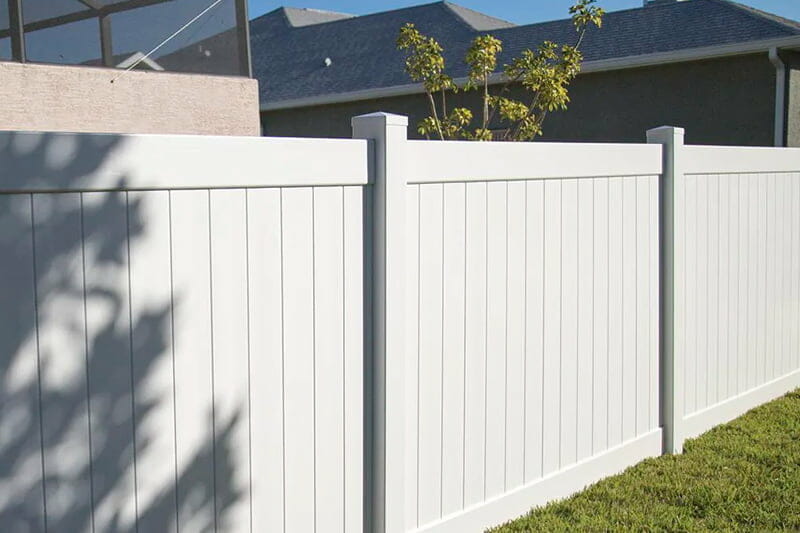
Regular inspection and repair of your wooden fence is a recommended practice for it to serve you for long.
First, check for signs of rot on your wooden fence. If there are any, pick a brush and scrub the rotting part. Once the rot is cleared, wash the post or rotten part of the fence. Wash with water mixed with bleach. Then wait for the wood to dry. When the wood is dry, you can use an environmentally friendly sealant to apply to the fence.
Also, check for points on your fence that are broken. You can use nails to fix the broken with small pieces of similar wood. Make sure that the pieces of wood you use to repair or the posts you replace with are pressure treated before fixing them onto your fence.
If you can’t carry out repairs by yourself, you can contact a pro to do it for you. It will be more expensive than a DIY but it will be well done.
Pressure-treating wood for your fence ensures that the fence doesn’t rot and decay.
Wood that comes into contact with moisture and soil will decay. It is a natural response from wood.
When you apply pressure treatment to your wooden fence posts, you prevent this natural process from taking place. Pressure treatment of fencing posts infuses in them a chemical that prevents them from decaying when in contact with soil and moisture.
However, prolonged exposure to these factors, or before the treatment dries may cause the wooden fence to rot and decay.
A wooden fence can last for up to 20 years if well maintained. There are other types of fences that can last longer,
Stone and metal fences can last a lifetime. Protect metal fences from rust. It will ensure that they serve you for a long time.
Stone fences are the most long-lasting type of fence. They do not rot or rust. They are strong enough to withstand the effect of strong winds, sun, or rain. Unless you bring it down, a well-built stone fence will last a lifetime.
Wooden fences have a great level of durability and can persist for many years if properly cared for. However, they are vulnerable to environmental factors that can cause warping, deterioration, and the formation of mold. Furthermore, the fence posts may become inclined or fall due to shifts in the ground.
The average cost to repair a wooden fence ranges from $300 to $800. At the minimum, you can spend around $130, while the maximum cost can go up to $1,200.
The actual cost for wooden fence repair depends on the extent of the damage, accessibility, and type of wood.
Average cost to repair a wooden fence
| Description | Average cost |
|---|---|
| National average cost | $550 |
| Wooden fence repair per foot | $13 - $27 |
| Cost to replace wooden fence per foot | $17 - $45 |
| Wooden Fence repair cost (100 ft.) | $1,300 - $2,700 |
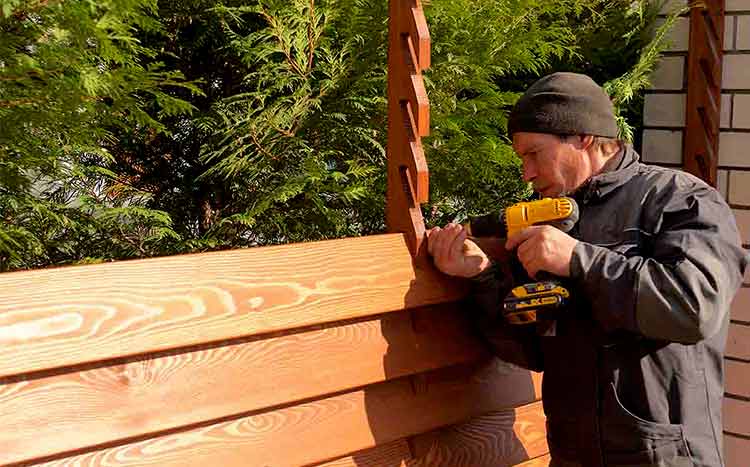
Wooden fence repair per foot
The average cost to repair a wooden fence per foot ranges between $13 and $27. Contractors charge around $65 to $90 per hour for smaller projects, but the rates vary depending on the fence height, project size, location, and extent of the damage.
Replacement cost
If your wooden fence needs replacement, expect to spend around $17 to $45 per linear foot for the project. The overall cost for wooden fence replacement ranges from $1,675 to $4,042, but the cost may vary widely depending on the wood type, fence height, fence type, project size, and job complexity.
Labor costs for repairs
The average labor cost for wooden fence repair ranges from $4.50 to $12.50 per linear foot. The cost depends on whether the panels need repair or replacement.
Simple repairs such as filling holes and cracks or replacing one or two boards will be cheaper than complex repairs and replacements.
Cost for materials only
Materials for wooden fence repair cost between $8.50 and $14.50 per linear foot, depending on the type of wood and height of the fence. If the damage is extensive, you will need more materials and supplies, which will increase the overall material cost.
Repair Cost by wood type
The following table provides you with the average costs for wooden fence repair by wood type.
| Wood Type | Average cost |
|---|---|
| Pine fence | $200 |
| Redwood fence | $300 |
| Cedar fence | $325 |
| Cypress fence | $350 |
| Oak fence | $500 |
Pine fence repair
Pine fences are the cheapest to repair because pine wood is readily available. Also, the fence parts such as panels, posts, and gates are inexpensive. The average cost to repair a wooden pine fence is $150 – $200.
Your contractor should inspect the fence and advise you on whether it needs repair or replacement. Newer fences are worth repairing because the wood is still strong. However, older fences of over 10 years may need replacement, especially if the repairs are recurrent.
Redwood fence repair
Redwood fences are prone to damage and can break easily because the wood is softer. These fences are ideal for small areas such as pools and patios, and their natural color makes them very appealing. Redwood fences are also common, and the average cost to repair a privacy fence averages at $225 – $300, labor and materials included.
Cedar fence repair
Cedar fences are quite costly to repair because the wood is stronger, more resistant, and rarer. Besides, cedarwood is highly attractive, and it is naturally resistant to insect infestation and moisture, and decay. The average cost to repair cedar fences is approximately $275 – $325. The cost can be higher or lower depending on the extent of the damage.
Cypress fence repair
The average cost to repair cypress fences is almost equal to cedar fences. Both cypress and cedar are top-quality wood fences because they are stronger and more durable. Although the initial installation cost for these fences is high, they are worth the investment as they offer durability and aesthetics. Repairing a cypress fence will set you back by around $310 – $350.
Oak fence repair
Oak fences are the most expensive to install and repair. Oakwood is rare, which means transportation or shipping costs substantially affect the overall cost of the wood and installation. Common oak fence repairs cost around $375 – $410. Replacing an oak fence can be very costly, so it is essential to regularly clean and maintain it to prolong its longevity.
Wooden fence repair by problem
Below are the average prices for repairing wooden fences by the problem.
| Problem | Average cost |
|---|---|
| Post replacements | $230 - $700 |
| Wood rot and termites | $150 - $750 |
| Cracks and holes | $125 - $370 |
| Leaning, sagging or shifting fence | $140 - $420 |
| Warping wood | $150 - $230 |
| Stains and mildew | $190 - $285 |
| Rusted nails or screws | $50 - $70 |
| Storm damage | $230 - $600 |
| Ground erosion | $250 - $310 |
Post replacement
The average cost to replace boards ranges from $230 to $700, depending on the extent of the damage. Shifting ground, rot, and accidents are the most common causes of post-replacements. Minor repairs such as resetting posts will be much cheaper than replacing the posts.
If you do not wish to replace the post just yet, you can reinforce it using a mender, steel spike, or bracket. This is, however, a temporary solution as the post will need replacement sooner or later.
Wood rot and termites
The average cost to repair an insect-infested or rotten fence ranges from $150 to $750. The cost will depend on the level of damage, and in most cases, chemical treatment, patching and filling holes, and staining or painting the new boards will be required. If the damage is severe, you may be forced to replace the entire fence.
Wooden fences are highly durable, but they are susceptible to weather elements and insects. Immediate repair and regular maintenance will keep your fence in good condition and save you lots of money in the long run.
Cracks and holes
On average, repairing holes and cracks on a wooden fence costs around $125 to $370. The price will increase if the fence needs to be repainted or refinished. Minor accidents from baseballs, termites, and weather elements can cause holes and cracks in wooden fences.
These are usually minor repairs, which means the structure may not need replacement unless it is completely worn out. If the holes or cracks are small, you can fill or patch them using an extra piece of lumber.
Leaning, sagging, or shifting fence
On average, repairing a leaking, sagging, or shifting fence costs around $140 to $420. The most common cause of a leaning or sagging fence is shifting ground. If the posts and foundation of the fence are intact, you may only need to repair the panels and rails. However, repairing the fence will require more work and money if the support structure and foundation fail.
Rotting beneath the ground can also cause fences to sag. When this happens, you do not have to replace the entire post. Rather, you can dig around it, place it in the right position and add concrete at the base. This will prevent further rot and offer more support to the fence.
Warping wood
Extreme fluctuations in temperature and moisture content can cause your wooden fence to warp over time. If the lumber you use is not fully dry, some parts may dry faster than others due to different exposures to the sun. The part that dries faster will also shrink faster, thus changing the shape of the board.
Warping wood makes the fence look unsightly, and in most cases, replacement is the best option. Replacing warping boards costs between $150 and $230 depending on the extent of the damage.
Stains, mold, and mildew
Wooden fences are prone to stains, mold spores, and mildew. Pressure washing the fence can get rid of the stains, mold, and accumulated dust at the cost of around $190 to $285. However, if the mold has affected a larger part of the fence, you may need to replace boards at about $700 or replace the entire fence at a much higher cost.
To prevent your fence from developing mold and mildew, ensure the area around it is constantly dry. Also, remove any vegetation growing near the fence, such as flowers and shrubs, because the water from your sprinkler may make the area damp, thus accelerating mold growth and rot.
Rusted nails or screws
Nails and screws are usually exposed to the weather, and they tend to rust over time. Replacing rusted nails and screws costs between $50 and $70. In most cases, you will need to replace boards that have been stained by rust. This is, however, not necessary if the boards are in perfect condition. You can caulk the nail and screw heads or use a rust-inhibitive/stain-blocking primer to prevent them from rusting.
Storm damage
Severe storms can cause extensive damage to your fence and lead to costly repairs and replacements. If you live in an area prone to storms, it is wise to cover your wooden fence against storms. This way, you will not spend lots of money to replace your fence as your insurance company will cover the costs. Replacing boards and posts due to storm damage costs around $230 to $600, including storm clean-up services.
Ground erosion
Ground erosion leads to the formation of small rills that develop into gullies over time. This is because the surface runoff is usually concentrated with soil and debris that erode the ground. In time, ground erosion will wash away the top layer of the soil and expose the fence posts, making them weak. This may affect the structural integrity of the fence, and it may start leaning or even fall. The average cost to repair the fence and fill the ground with soil averages at $250 to $310.
Is it better to repair or replace a wooden fence?
Wooden fence repair is usually cheaper than fence replacement. However, repairing your wooden fence only offers a temporary solution, but it is a viable option for small holes and cracks. You may also need to replace a few boards here and there for larger holes, cracks, or stains. Wooden fence repair costs about $300 to $800, including materials and labor.
If the damage is significant or the fence is old, replacing the fence will be the best option. Although you will spend much more on the replacement, your fence will have a longer turnaround. More so, your fence will boost your home’s curb appeal, and you will get warranty coverage for the job. Replacing a fence will set you back by around $1,675 to $4,042, which is much more expensive than repair.
How long do wooden fences last?
Generally, wooden fences last for about 15 to 40 years, depending on the type of wood, climate conditions, and quality of the installation. With proper care and maintenance, your fence can surpass this mark.
Pine and redwood fences last for around 15 to 25 years because the wood is softer. Cedar and oak fences last for a longer time, approximately 25 to 40 years, because the wood is more durable. Besides, cedarwood is naturally resistant to insects and rot, which increases its durability.
Wooden fence repair cost by fence parts
| Fence part | Average cost |
|---|---|
| Pickets | $100 |
| Panels | $135 |
| Lumber rails | $95 |
| Post caps | $90 |
| Fence posts | $150 |
| Screening materials | $120 |
| Wooden gate repair | $400 |
Wooden fence pickets
Replacing wooden fence pickets costs about $100 or $1 to $10 each. Pickets need replacement when they break or warp. Once you install the new pickets, you should paint or stain them to match the fence’s color and increase durability. You can purchase manufactured replacement pickets for DIY projects. Your contractor can also provide matching replacements for your damaged pickets.
Wooden fence panels
Replacing a single wooden fence panel costs around $135. Panels may rot due to moisture and mold or go missing during strong winds and storms. Replacing multiple panels will increase the overall project cost. Also, the kind of wood and stain used for the installation will affect the project’s overall cost.
Wooden fence lumber rails
Once fence rails become loose, they should be repaired or replaced immediately to maintain the fence’s integrity. A t-brace will be needed to reinforce the replaced lumber rails at an extra cost. You will also need to paint or stain the replaced rails to match the rest of the fence. Repairing lumber rails costs around $95.
Wooden fence post caps
Post caps are an essential addition to your fence installation as they protect your fence posts and offer a decorative value for the fence. They are available in different styles, colors, and finishes, so you can choose the options that complement your fence and garden. Once these post caps fail, the structural integrity of the fence may be affected. The cost to replace damaged post caps averages at $95.
Wooden fence posts
Wooden fence posts are necessary to keep the fence together. Damaged posts either due to rot or storms should be repaired or replaced immediately. You will need new posts, equipment, hardware, and hole diggers to replace the post. Failure to replace the posts immediately may cause further damage to your fence, leading to extra costs. Typically, replacing one fence post costs around $150.
Screening material
Before you repair the screening material of your fence, you should get rid of all the broken pieces and nails. You will require new galvanized nails and replacement wood for the repair job. The replacement pieces should be painted or stained to match the remaining part of the fence. Common screening material repair costs around $120.
Wooden gate repair
Repairing your wooden gate costs between $125 and $400. This cost includes replacing damaged parts and repairing the structure. New wooden gates are very attractive and strong. Over time, they start developing stains, and the hinges become creaky due to constant traffic from people. Nails also start to pop out while latches no longer function properly. At this point, you should decide which option is worth it: replacing the parts or the entire gate.
Wooden fence repair cost factors
Wooden fence repair costs depend on damage extent, fence height, permits, and job complexity. Let’s have a closer look at these cost factors.
- Extent of damage: this is the major factor affecting the project’s overall cost. Minor repairs are usually cheaper to repair compared to extensive damage. For instance, if you need to replace one post, you will spend about $150, while replacing more than two posts will cost $300 upwards.
- Permits and codes: your homeowner must ensure the project meets the community, local, and state guidelines. Most states do not require permits for fence repairs, but you should get approval from your local homeowner’s association before commencing the project. Larger projects like fence replacement may require a permit, so check with your municipality for clarity.
- Fence height: the height of your fence depends on your preference and local fence codes. Most front yard fences tend to be 3 to 4 feet high, while back yard fences can be up to 6 feet. A higher fence will need more materials at additional costs.
- Age of wood: the age of the wood also dictates the overall cost of repairing your fence. Repairing older fences is more expensive because the wood will have sustained damage for many years. Also, finding the right parts for older fences can be challenging.
- Wood type: The wood used on your fence will significantly affect the repair cost. Low-end wood is usually cheaper than high-end wood of the same size. Also, repairing an oak fence will be costlier than a pine or redwood fence.
Tips on hiring a wooden fence repair contractor
Hiring the right fence repair contractor can be daunting, especially if you do not have any referrals. Before you hire any wooden fence repair contractor, you must ensure they are experienced in the job and possess genuine certifications. The following tips will help you choose the best wooden fence repair contractor.
1. Define your needs
It is essential to know what you need to find the right fence repair contractor. Wooden fence repairs range from minor repairs like holes and cracks to major repairs involving post replacement or replacing the entire fence. A handyman can be an excellent choice for filling and patching holes at a cheaper cost. However, you will need a professional wooden fence contractor for extensive damage.
2. Reputation
The reputation of the contractor matters a lot. Do not rush to hire contractors offering lower quotes because they may disappoint you. Check the reviews of the professionals on their websites and review sites like YELP to determine their reputation.
3. Get multiple quotes
When looking to hire a fence repair contractor, ensure you get several quotes from different pros. You can then compare the quotes and choose the professional that meets your needs and budget. You should also request a written estimate for the project.
4. License and insurance
License and insurance are extremely important when hiring any fence contractor. The professional should provide you with updated copies of their license and insurance. A contractor who is licensed shows that they are committed to their work. Also, insurance covers your property and the professional in case of damages and accidents at the worksite.
Wooden fence cleaning and maintenance cost
Cleaning and maintaining your fence regularly prolongs its life. More so, there will be fewer repairs, and your fence will look great at all times.
You can purchase an electric pressure washer for about $90 to $800, depending on the quality and size. You can also rent the pressure washer at around $40 to $100 per day if you do not wish to buy one at the moment. Ensure you follow the instructions when cleaning your fence to avoid damaging it. Too little pressure will not be effective, but too much pressure can damage the fence.
Staining, sealing, and painting the fence regularly is also essential to keep it in good shape. Staining and painting cost around $1 to $5 per square foot. If you buy your own materials, you will spend about $15 to $30 per gallon on paint and $20 to $40 per gallon on wood stain.
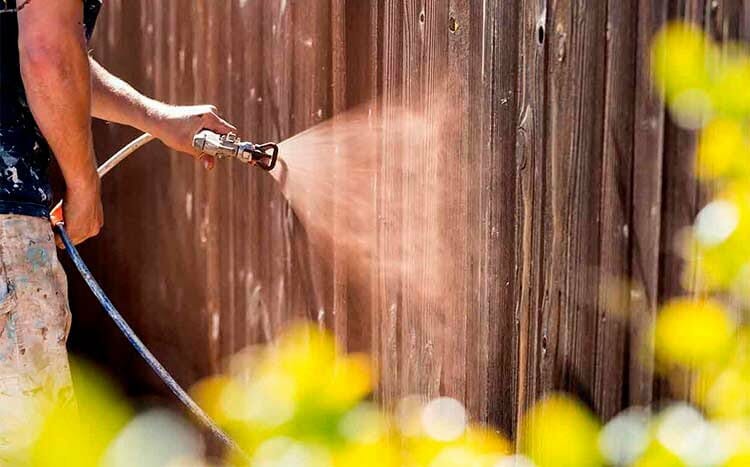
DIY vs. Hiring a Professional
While you can handle small repair jobs like filling and patching holes or cracks, larger repairs should be left to the professionals. Repairing wooden fences is quite complicated and requires more than two people, skills, materials, and equipment.
DIY jobs may seem cost-effective, but they can be unreasonable sometimes because you will need to buy materials and supplies. Also, if you do not have enough skills, you may cause more damage or harm yourself during the job.
For this reason, it is best to hire a professional wooden fence repair contractor to do the repairs for you. A pro will offer you quality repairs that will boost the curb appeal of your home and increase its resale value.
FAQ's
How do I keep my wooden fence from rotting?
To prevent your fence from rotting, you should apply a wood preservative seal every 2 to 3 years. The sealant protects the wood from all forms of moisture. Also, keep the area near the fence free of plants and shrubs as they may hold moisture and accelerate wood rot and mold.
How often should a wooden fence be replaced?
Typically, a wooden fence may need replacement after every 10 years. Wooden fences last for about 15 to 30 years, depending on the type of wood, quality of the installation, and maintenance. Some fences may need replacement sooner than others due to climatic conditions. If your fence needs frequent repairs and parts replacement or looks generally worn out, replacing it would be more financially sensible.
Does homeowners insurance cover fence damage?
Yes! Homeowners insurance covers fence damage if the fence is damaged by insured peril like a fallen tree, fire, vandalism, or storm. However, the insurance will not cover any damage caused by normal wear and tear or poor maintenance. Therefore, it is your responsibility to maintain your fence properly to increase its longevity.
Does a new fence increase a home’s value?
Generally, a fence itself may not add much value to your property. Rather, it enhances a home’s value if there is a true need for it. Also, the materials used to design the fence significantly affect a home’s resale value. For instance, wooden, PVC, and cast-iron fences can bring a return on investment of 50% or more when you sell the property.
Want to install a wooden privacy fence? Before starting, there are a few important factors to consider about the cost.
The national average cost to install a wood privacy fence stands at $4,350. However, most homeowners spend anywhere from $1,700 to $7,000 depending on the length of the fence, its height, and the type of wood used.
This translates into $17 – $44 per linear foot for the total installation.
Average cost to install privacy fence
| Quantity | Cost | |
|---|---|---|
| Materials | Per Linear foot | $3 - $20 |
| Labor | Per Linear foot | $10 - $20 |
| Equipment and supplies | Per Linear foot | $5 - $10 |
| Average costs | Per Linear foot | $18 - $50 |
| Total costs | For 200 Linear ft | $3,600 - $10,000 |
Average cost to install wood privacy fence on 200 linear ft yard = $6,800
While installing a wooden privacy fence isn’t the most expensive job, your choice of materials and labor may make it so.
Generally, different types of wood will cost you differently, i.e., an Oak privacy fence will be more costly than one from pine or cedar. Expect to spend anywhere from $3 – $20 per linear foot on the privacy fence materials.
If you choose to hire professional fencing contractors, your costs will also be higher, ranging from $20 – $60 per hour or between $10 – $20 per linear foot.
To get better accuracy when estimating how much installing the privacy fence will cost you, first measure the length of your property line.

Note: Over the past year, there has been a sporadic rise in the costs of most home improvement equipment and materials. This is due to the increasing demand for these goods by the people now working from home, the rise in shipping costs, and the shortage in supply of the materials.
Therefore, expect to spend around 5 – 10% more on the fencing materials and supplies from the prices stated below.
Wood privacy fence cost per foot
The average cost to install a wooden privacy fence is around $17 – $44, including the labor and material cost. You might, however, spend more depending on the condition of your land and where you live.
If you choose to complete the installation as a DIY, your costs will be much lower, between $8 – $30 per linear foot. The actual amount will depend on your level of experience.
Wood privacy fence cost by yard size
The overall size of the yard being fenced also influences how much you’ll pay in the final estimate. A small yard, around 600 sq. ft may cost around $2,000 to install a privacy fence.
A homeowner with a medium-sized yard, around 2,000 sq. ft, can expect to spend up to $6,900 for the job while those will large yards can spend around $20,000.
Here’s how much you can expect to spend depending on the length of your fence.
| Size in Linear Feet | Low | High |
|---|---|---|
| 100 | $1,700 | $4,400 |
| 200 | $3,400 | $10,000 |
| 500 | $8,500 | $22,000 |
| 600 | $10,200 | $26,400 |
| 900 | $15,300 | $39,600 |
Note: In most cities and towns, privacy fences are only allowed in the backyard and not the front yard. Therefore, your costs could be relatively lower if this is the case in your area. Check your local fencing regulations and Homeowners Association rules to be sure.
Wood privacy fence labor costs
If you choose to hire a professional for the project, the average labor cost will be significantly high. Due to the complex nature of the installation, you can expect to spend anywhere from $10 – $20 per linear foot for the job.
By the hour, this will range between $25 – $60. Any prep work or extra services required will also increase the labor costs.
Furthermore, you might spend more or slightly less depending on your geographic location.
Cost of wood privacy fence by style
To achieve privacy, whether full or partial, homeowners use different styles for their wood privacy fences. The most popular styles in the country today include:
| Style of privacy fence | Low | High |
|---|---|---|
| Solid board fence | $16 | $30 |
| Shadowbox / Board-on-board | $11.50 | $40 |
| Stockade fence | $8 | $15 |
| Basketweave fence | $12 | $30 |
| Lock board fence | $14 | $31 |
| Picket fence | $10 | $38.50 |
| Dog Eared fence | $12 | $20 |
| Convex fence | $8 | $20 |
Solid board privacy fence
The solid board privacy fence is a sturdy and beautiful fence option that’s perfect for homeowners looking for complete privacy. It doesn’t have any gaps between the wooden boards and is quite tall, ranging between 6 – 8 feet.
The fence is usually made from Pressure treated Western Red Cedar which is rot-resistant and has a long lifespan.
Installing a solid board privacy fence will cost you $16 – $30 per linear foot including labor and materials.
Pros of solid board fences
- Offer excellent privacy
- Long-lasting and durable
- Beautiful appearance, improves
- curb appeal
- Easy to install
Cons of solid board fences
- Can be expensive
- Requires regular maintenance
Shadowbox (board on board) privacy fence
Shadowbox fences are among the most popular privacy fence designs available today. It’s characterized by a tall alternating row of picket boards with a 2-inch gap separating the pickets on both sides.
It offers good semi-privacy fencing that allows more light and air to brighten your yard but still keeps any unwanted peepers at bay through the overlapping pickets.
The cost of installing this fence will be greatly determined by the type of wood you choose. However, most homeowners spend anywhere from $11.50 – $40 per linear foot.
Pros of shadowbox fence
- Its unique construction makes it visually appealing
- Alternating pickets allows it to be very durable
- Offer good versatility in color, wood type, and stains
- Has the same look on both sides
- Improves your property’s resale value
Cons of shadowbox fence
- Doesn’t offer complete privacy
Stockade privacy fence
Stockade fencing is slightly similar to the solid board fence but features a one-sided style with pointed picket tops. Wood boards for this fence style are butted together (one next to the other) ensuring no gaps are left.
The materials used for this fencing include Spruce, Pine, Cedar, Redwood, and Pressure-treated wood.
Its height could range anywhere from 4 to 6 feet making it perfect for your swimming pool or backyard.
The best thing about this fence is that it’s also relatively cheaper. You can expect to spend between $8 – $15 per linear ft for the installation depending on the type of wood you use.
Pros of stockade fencing
- Ensures full privacy since no one can peer through
- Easy to install and repair
- Relatively cheap to install
- Flexibility of painting options
Cons of stockade fencing
- May result in an unwelcoming appearance
- May develop small gaps with time due to wood expansion and contraction
Basketweave privacy fence
If you’re looking for a fence that offers more than privacy and beauty, then this is the fence for you. The Basketweave fence uses several strips of wood that overlap each other to come up with a fully opaque wall.
Its appearance mimics that of a woven basket, making it very unique from the fences in most neighborhoods.
Installing this fence will cost you anywhere from $12 – $30 per linear foot depending on the wood used.
Pros of Basketweave Fence
- It’s very stylish and visually appealing
- Relatively affordable
- Offers good privacy
- Available in several colors
- Unique privacy style
- Improves the curb appeal of your home
Cons of Basketweave Fence
- Requires a lot of maintenance
- Wood used isn’t strong so has a shorter lifespan
Other popular privacy fence-style options you can try include:
- Lock board fence – $14 – $31
- Picket fence – $10 – 38.50
- Convex and Concave fence – $8 – 20
- Dog Eared fence – $12 – $20
Wood privacy fence cost by height
Most privacy fences in the country today are either 6 feet or 8 feet. The heights can also get to 10 feet depending on the terrain of your yard. However, this will be subject to the local fencing regulations in your area.
The average cost to install a 4 – 6 feet tall fence costs anywhere between $20 – $45 per linear foot. An 8-foot tall fence increases the costs by almost 35% due to the cost of the added structures required to support them.
Homeowners spend anywhere between $25 – $55 per linear foot for these fences.
In terms of a 100 linear foot privacy fence, installing a 6’ fence may cost around $3,250 while an 8’ fence costs around $4,000.
Privacy fence cost by type of wood
As earlier mentioned, the type of wood you use generally affects how much you’ll spend on wood privacy fence installation.
Generally, using Hardwoods and pressure-treated woods for the installation will cost more than the softwoods. For instance, using Hardwood costs around $11.50 per linear foot compared to the $3 when using pine or untreated Cedar.
Keep in mind; These prices will vary depending on your location.
| Quantity | Low | High | |
|---|---|---|---|
| Cedar | Per Linear ft | $2 | $5 |
| White Cedar | Per Linear ft | $4 | $7 |
| Red Cedar | Per Linear ft | $6 | $8 |
| Oak | Per Linear ft | $5 | $10 |
| Pine | Per Linear ft | $1 | $5 |
| Composite | Per Linear ft | $6 | $10 |
| Black Locust | Per Linear ft | $5 | $10 |
| Western Red Cedar | Per Linear ft | $6 | $8 |
| Douglas Fir | Per Linear ft | $6 | $7 |
| Bamboo | Per Linear ft | $10 | $16 |
| Hardwood | Per Linear ft | $8 | $15 |
Cost of wood privacy fence by location
The cost of lumber for privacy fences will also vary depending on where you live. If you live in a high-end neighborhood, contractors are likely to charge you higher prices compared to owners in the middle-income and rural areas.
Here are a few examples of what you should expect to pay for a 100 linear-foot wood privacy fence in some cities:
- Washington – $2,600
- Michigan – $1,400
- New Mexico – $1,750
- Georgia – $1,500
- Rhode Island – $2,200
- Iowa – $1,500
- Utah – $2,000
- Delaware – $2,100
The exact amount you’ll pay will depend on the professionals you hire within your area.
Wood privacy fence replacement cost
The average cost to replace your wood privacy fence will depend on whether you’ll need the removal of the existing fence among other services. Removal and disposal of the fence may add around $3 – $5 per linear foot.
On average, the total cost to replace your wood privacy fence ranges between $20 – $50 per linear foot. This translates into between $2,000 – $5,000 for the complete project.
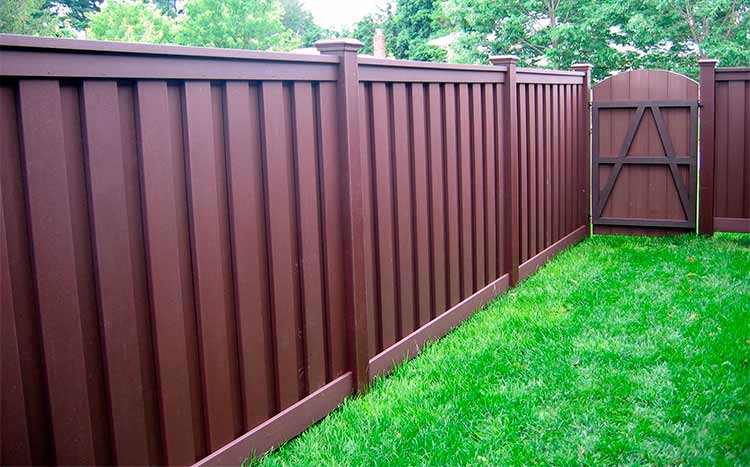
Additional cost factors
Besides the labor and fencing material pricing, other factors that could add up to your total costs include;
Permits and local regulations
According to the local fence ordinances in most areas, you’ll need to get a permit for your privacy fence. For fences taller than 6 feet, you might also need to get a variance from the local municipality’s planning department – this is subject to the fence laws in your area.
The permits may cost between $20 – $100 but you can expect to spend anywhere from $200 – $1,200 if an inspection has to be done. You’re more likely to pay more if you live within the city limits.
Land survey
To avoid encroaching on your neighbor’s property, homeowners are always advised to hire a land surveyor before installing their fence. A surveyor will mark out your property lines beforehand and inform you of any land covenants that could be in place.
Doing this increases your costs by between $300 – $800 depending on the size of your property. Besides the size, the terrain and location of your house will also affect how much you spend.
Painting or staining
Most wood fences require some form of coating to protect them from rotting, insects, weather, and warping. You’ll, therefore, need to paint or stain your fence once in a while to keep it in shape and improve its lifespan.
Most homeowners pay around $1 – $2.50 per sq. ft to stain their fence and around $1.50 – $3 per sq. ft to have it painted.
However, the actual cost of either option will depend on whether you choose to hire a painter or do it as a DIY. Hiring an expert painter will cost you anywhere from $1,100 – $3,500 depending on the size of the fence.
DIY painting the fence will cost you slightly over $500.
Tree and stump removal
Large obstacles along the expected path of your fence will need to be removed, and this means extra costs. Professional tree removal, for instance, costs anywhere from $325 for small trees to around $7,900 for very large trees.
Removing bushes may cost you around $100 per bush, while stump removal costs anywhere from $75 – $600 depending on the size.
Make sure you get several quotes from different tree service companies to get the best deals.
Slope of land
The terrain of your land will also be a factor in the overall quote from your contractor. If they need to grade the land before installing the fence, you’ll have to pay an extra $100 – $3,500 for the job,
Gates
If you’ll be adding gates to your privacy fence, you also need to know that gates will cost more to install than your basic fence panels. The real cost of the gates will depend on their height, decorations, and material.
Nevertheless, expect to spend anywhere from $200 – $1,200 including labor and materials. Here’s an overview of the total costs by height:
| Gate Height | Cost |
|---|---|
| 4 Feet | $200 - $250 |
| 5 Feet | $225 - $275 |
| 6 Feet | $275 - $325 |
| 8 Feet | $375 - $425 |
| 10 Feet | $475 - $600 |
Fence post shape
Another key aspect of the overall cost of your privacy fence is the shape of the fence posts. The most popular shapes in use today include the pointed, square, and rounded.
Besides influencing the overall design and aesthetics of your fence, these post shapes also cost differently.
- Pointed posts – These have sharper ends which make it easier to drive the fence posts into the ground. They’re common in areas with dry and tough soils. Each pointed post will increase your costs by between $5 – $20.
- Rounded posts – If you’re going for a classic look, this is the fence post for you. It’s very easy to install and maintain and it’s never affected by animals and pests like squirrels. Installing the wood posts will increase your costs by around $5 – $15 each.
- Square posts – These are the most sophisticated and polished posts, but still the most expensive. They feature a square base which makes them very stable. Square posts are easier to cut but are affected by pests and other elements. Installing it will add an extra $20 – $50 per post to your overall fence installation costs.
Wood privacy fence vs other alternatives
Besides wood, homeowners across the country have also opted for other materials for their privacy fences. Vinyl privacy fences and metal fences like aluminum and wrought iron are among other popular options in use today.
Owners looking out for the safety and security of their kids, animals, and pets have also been known to embrace chain-link privacy fences, while bamboo and composite fences are still quite popular.
Here’s how each of these options compares to the cost of installing a wood privacy fence.
| Fence Material | Average cost per Linear foot |
|---|---|
| Vinyl fence | $15 - $40 |
| Aluminum fence | $24 - $32 |
| Wrought iron fence | $35 - $50 |
| Chain-link fence | $10 - $20 |
| Bamboo fence | $12 - $23 |
| Composite fence | $15 - $45 |
Cost to DIY install wood privacy fence
When looking to save on costs for the installation of your privacy fence, DIY installation can be a great option. However, you’ll need to be prepared to spend numerous hours on the job, depending on the size of the fence.
You’ll also have to spend on the equipment and materials for the job and this can be expensive. Most homeowners spend between $250 – $350 or $5 – $10 per linear foot for equipment and around $3 – $20 per linear foot on the materials.
Keep in mind; The cost of equipment and supplies will be lower per linear foot for larger projects compared to smaller fences.
| Item | Quantity | Cost |
|---|---|---|
| Materials | Per Linear foot | $3 - $20 |
| Equipment and supplies | Per Linear foot | $5 - $10 |
| Total | Per Linear foot | $8 - $20 |
| Average DIY total | For 200 Linear ft | $1,600 - $4,000 |
DIY cost vs hiring a pro cost
Installing a fence as a DIY is very simple and can be easily done if you have the time. For a 100 linear foot fence, you can expect to spend around $1,900 for the installation.
If you opt to hire a professional installer to do the job, the overall cost will be around $3,400. This means you’ll be saving nearly $1,500 of the privacy fence installation costs by doing it yourself.
However, you’ll need to consider your DIY experience and whether you have the time to complete the installation well.
Hiring a professional fence installer is always recommended for such DIY jobs because they have the team to complete it quickly and also can guarantee you good results.
Important questions to ask your fence installer
While hiring a fence contractor is a smart decision, you need to be sure that the contractor you choose can handle the job. After all, you’re spending thousands on their labor costs, so you deserve nothing short of quality work.
By asking your contractor these questions, you’ll get a better idea of the experience and expertise of the contractor.
- How long have you been in operation?
- Are you licensed to operate within this state?
- Do you have an in-house team or will you subcontract the work?
- How quickly can you start the job?
- Can you show me past samples of your work?
- What kind of warranty do you offer?
- Is your company fully insured? (Be sure to contact their insurer to confirm their cover is still active)
All reputable fencing contractors should easily answer these questions and any others you may have. Finally, ask for a contract for the entire job and ensure everything is well-detailed in the contract.
Need a fence contractor you can trust?
Use this FREE service! HomeGardenGuides.com is a free service that quickly matches you with the top-voted wood fencing professionals.
You can get 3 estimates by real certified experts in your area in just 2 minutes by simply scrolling to the top of this page, entering your Zip code, then answering some questions about the privacy fence you want.
We forward your fencing job details to three local experts, who’ll then send you a price estimate for the job with some friendly advice.
IMPORTANT: There is no obligation to hire. This is a free tool and service to be used at your pleasure.
FAQ's
Most wood fences last anywhere between 10 – 20 years. However, with regular maintenance and care, your fence can last well past the 20-year mark.
Vinyl fencing. The fence can easily last longer than 30 years and outlives most other popular privacy fence alternatives. Its durability is due to its resistance to insects, pests, and other weather elements.
It depends on what you’re looking for. A Wood fence offers better aesthetics and gives you better flexibility in colors and design options. Vinyl, on the other hand, is a better option if you want durability and lower maintenance.
Summer or spring. During this time, the ground is usually dry making it easier to dig fence holes and install them.
Yes! Adding a privacy fence creates a safe space for your children and pets to play in while also keeping out any unwanted strangers and stray animals. Installing a privacy fence can also help improve the overall resale value of your home.
Not necessarily. A privacy fence will only be considered rude if it’s constructed for the sole purpose of annoying your neighbor or if it encroaches on their land. Otherwise, you are within your rights to erect a privacy fence so long as it doesn’t violate your local area’s fence laws.
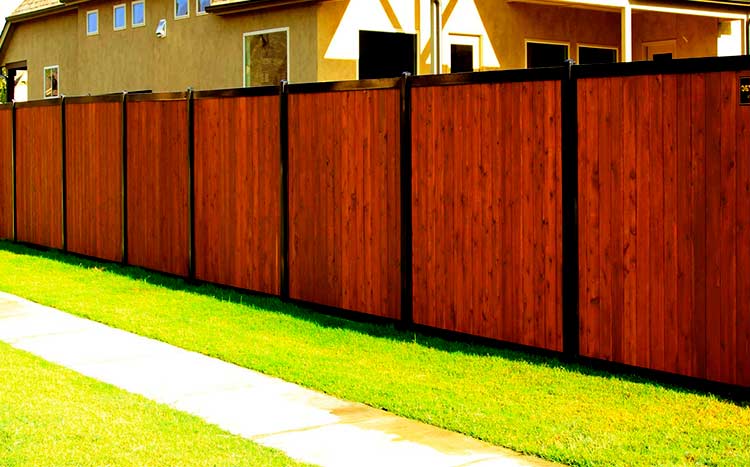
Installing a wood or chain link fence is a great method for ensuring safety and seclusion for your property. These varieties of fences are commonly used and easy to install and maintain. Read on to discover the advantages and disadvantages of each choice and important factors to keep in mind before making a choice.
Wooden fences offer more privacy and can be more aesthetically appealing than chain-link fences. However, chain-link fences are less expensive to install and maintain compared to wooden fences. Choosing either mainly comes to cost, the purpose of the fence, personal preferences, and availability of materials.
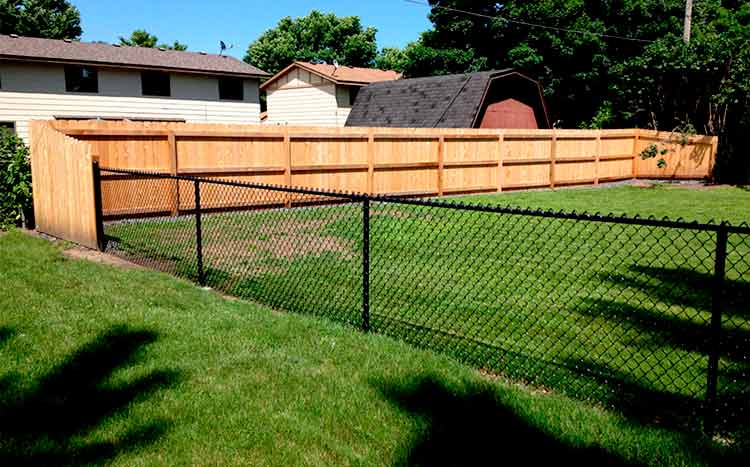
Which Is Better Material for A Fence?
Wood and chain link fences are equally matched in many aspects. Each has its advantages and disadvantages that you may need to go over before you decide on one. For instance, wooden fences need more frequent maintenance over their lifespan.
In general, both fences are good and can be used in both commercial and residential areas although chain-link fences are more suitable for agricultural and commercial lots. Also, it is usually advisable to go with fence materials that are predominantly used in your location to match the surroundings.
The Cost of Wood and Chain Link Fence
| Fence | Low (per linear foot installed) | High |
|---|---|---|
| Chain link | $5 | $20 |
| Wood (average cost) | $10 | $15 |
| Cedar | $6 | $16 |
| Pine | $5 | $8 |
| Spruce | $5 | $10 |
| Redwood | $10 | $15 |
| Cypress | $5 | $10 |
| White Oak | $5 | $7 |
| Hardwood | $8 | $12 |
Maintenance differences
Maintenance is one of the key things you must consider when choosing between chain links and wooden fences. Expect to maintain any natural wood fence more regularly than chain link fences in the absence of damage from physical impact or destruction from third parties.
Wood fences may need to be repainted, stained, and cleaned to get rid of pests, mold, and accumulated dirt over their lifespan. On the other hand, chain link fences can be left alone for many years and still maintain their strength and structural integrity.
Some of the things you need to do to keep a wooden fence in good condition over its lifespan include:
Regular inspections and on-time repairs- always check if there is a section on your wooden fence that needs urgent repairs or cleaning. Pest-infested or broken poles on a section can cause the entire fence to come down necessitating more expensive repairs.
Repainting and staining/re-staining- Wooden fences need to be repainted or re-stained every few years to protect the surface and make them more resilient to the elements. This can also prevent pests and mold from destroying the wood.
Regular hosing/pressure washing- You may need to hose your wooden fence down every few months to get rid of foreign objects, dust, and murk that may destroy the wood over time.
Chain link fences on the other hand do not require much in terms of maintenance over the lifespan. However, you can keep them in good condition or improve their appearance by:
Painting or applying rust-resistant gloss to prevent rust and surface corrosion- This may depend on the type of metal used for the chain-link fence. Some metals are more rust-resistant than others.
Cleaning- You can clean your chain link fence once in a while to get rid of accumulated dust, dead bugs, and other things that might corrode the surface.
If you were to decide on both fences on maintenance alone, chain link fences would make more sense. Some modern engineered wood fences may also offer the same durability but are more expensive.
Installation Of Wood and Chain Link Fence
Installation of chain link fences takes slightly more time and requires a bit more skill than the installation of wooden fences. You may need the services of a professional installer with the right tools and expertise to install even a simple chain link fence while it is possible to DIY-install a simple wooden fence.
Some of the steps involved in the installation of a chain link or wooden fence include:
- Permits – Applying for a fence or zoning and building permit if it is required before you start building your fence. A licensed fence contractor can obtain the permits on your behalf.
- Preparation – Designing and marking the layout and positioning of the fence. This also includes identifying property lines or boundaries to avoid encroachment. Also, ensure that you read local fence ordinances to ensure your fence is legal.
- Digging post holes – post holes should be deep enough to support the weight of the wooden boards or chain link fence. Ensure you do not interfere with underground utilities such as communication cables. You can notify your local utility protection service or relevant government department before you start digging.
- Setting the post – Done by and adding the concrete to the post holes dug with a post at the correct distance apart and straight/ level.
- Waiting – Wait for the concrete to set (12 hours) before installing the wooden posts or other components of the chain link fence
- Tensioning – Securing the fabric of the fence with bolts, nails, or tension wire.
For most landowners, having a professional fence installer do the job is easier and more convenient. Most fence contractors also offer important advice on materials and permits, and service warranties.
Tip: Scroll to the top of the page and enter your zip code to locate top-rated fence installation services in your location. The tool is free to use, and there is no obligation to hire any of the installers recommended.
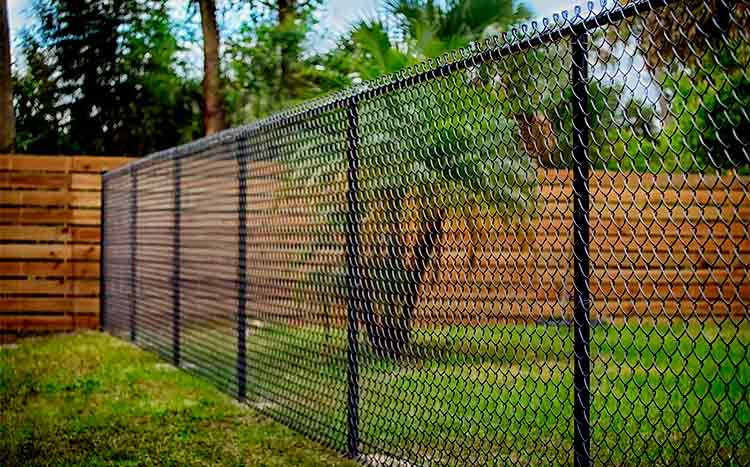
Durability Of Wood and Chain Link Fence
Chain link fences have a longer lifespan of up to 20 to 25 years on average as compared to wooden fences that last between 12 to 16 years. However, you may get more durability from modern engineered wood fences. Proper fence maintenance and prompt repairs can extend the life of your wooden or chain link fence.
Security Of Wood and Chain Link Fences
Owing to its design and materials used, a chain link fence will offer slightly more security than a wooden fence. However, the same cannot be said of privacy since chain link fences are see-through while most wooden fences can be a hundred percent opaque up to the allowable height.
The Pros and Cons of Wooden Fences
Pros
- Easier to install
- More options in terms of materials (engineered wood, natural wood, etc.)
- Provides privacy
- Legal in most places
- Environmentally friendly (depending on where and how the lumber is sourced).
- Can be customized with paint
Cons
- Wood fences require more frequent maintenance
- Not as durable as metallic fences
- Lumber can be expensive
- May block views and sunlight
- Susceptible to rotting, pests, and mold
The Pros and Cons of Chain Link Fence
Pros
- Chain link fences are durable
- Require less maintenance over their lifespan
- Offers better security
- Slightly less expensive than alternatives
- Can be extended or altered easily
- Suitable for both commercial and residential areas
Cons
- They do not offer privacy
- May be illegal in residential areas
- Can rust depending on the type of metal used
- They are not customizable and may be less appealing to look at ( they do not improve curb appeal)
What to Consider
Consider the following when deciding between wooden and chain-link fences;
Privacy
Wooden fences will offer more privacy especially if the spacing between boards is minimal while chain-link fences do not offer much in terms of privacy. Understanding what you want to get from your fence can help you choose one over the other.
Cost
Your budget will be an important factor when deciding between wooden and chain-link fences. Wood fencing costs are generally higher than the materials needed for chain link fences. However, this might depend on your location and the type of building materials used locally.
Local Fence Laws
Be sure to check local fence laws or zoning codes before you decide to erect a chain-link or wooden fence. Most local county or municipal governments have specific codes or guidelines on the type of fence, height, and materials that can be used in certain areas. For instance, it’s not uncommon to find zoning laws prohibiting the installation of chain link fences in certain areas.
Appearance/Curb Appeal
Are you concerned about the appearance of your fence? Wooden fences generally offer more options in terms of customization for aesthetics. Chain link fences aren’t installed for their appearance.
Property Value
Installing a new fence on your property can add some value to it. Wooden fences will generally add more value to the property as compared to chain-link fences. However, some homebuyers may prefer chain link fences due to the security they add to your property.
FAQ's
Chain link fences may have that utilitarian or industrial look that is not appealing to those who prefer looks over function. However, this does not make them trashy or bad and they provide much-needed security for most homeowners or farmers. You can also paint the entire fence to make it more visually appealing.
Durability is the most important thing when it comes to choosing chain link fences so stainless-steel fences are the best option. They are more weather resistant and stronger therefore more durable and secure.
Some people may find privacy fences to be rude especially if they are too tall, blocking a view, unsightly, or installed in a neighborhood where homeowners do not install fences. It is important to mind your neighbors and follow local fence laws when erecting your fence.
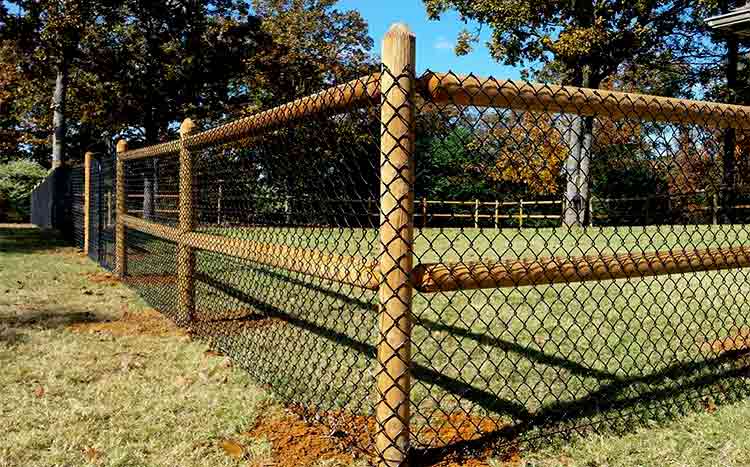
There are many reasons why you may desire to have a fence installed around your residence. A quality fence not only provides privacy, but also enhances the appearance of your home, adds to its curb appeal, and increases its property value.
Wooden fences are among the best and most popular choices of fence for American homeowners. The average cost of installing a wooden fence in the country is about $2,850, with the actual price ranging between $1,700 – $4,000.

Average cost of a wood fence
There are many factors that will determine how much you’ll spend on your wooden fence installation. Factors such as the type of wood, design, area to be covered, and the labor costs will all add up to the total costs.
On average, you can expect to spend anywhere from $12 to $30 per linear foot for the installation.
The cost of materials (wood) ranges between $17 – $45, while the lumbering costs start as low as $7 to around $15.
| Service | Quantity | Low | High |
|---|---|---|---|
| wood Fencing cost (Material) | Per foot | $17 | $45 |
| wood Fencing cost (installed) | Per foot | $12 | $30 |
| wood Fencing labor cost | Per hour | $30 | $60 |
| wood Fencing cost 200 ft. (installed) | 200 ft | $2400 | $3600 |
Average Estimate: $3,000
Cost of a wood fencing by type
| Service | Quantity | Low | High |
|---|---|---|---|
| Picket | Per foot | $5 | $13 |
| Post and rail | Per foot | $3 | $5 |
| Lattice vinyl | Per foot | $12 | $24 |
| Louver | Per foot | $21 | $30 |
| Vertical board | Per foot | $10 | $60 |
Labor cost to install a wooden fence
Labor costs will vary depending on how your contractor chooses to charge you (per hour or per linear foot).
Typically, most contractors who charge per hour may cost you around $30 – $60 per hour. If they charge per linear foot, expect costs between $10 and $20 per foot.
Other cost consideration
Other cost considerations homeowners should account for include extra features like the gates, extra fence heights, and the cost of paints and stains.
Depending on the material you choose, your gate may cost you anywhere from $200 – $750. If you want taller fences (more than 6 feet), you’re likely to spend 20 – 30% more on the cost of that material.
For the paint, expect to spend around $30 per gallon of paint.
Wood fence cost by material
| Service | Quantity | Low | High |
|---|---|---|---|
| cedar | Per foot | $2 | $3 |
| Red Cedar | Per foot | $6 | $8 |
| White Cedar | Per foot | $4 | $7 |
| Oak | Per foot | $5 | $10 |
| Pine | Per foot | $1 | $5 |
| Composite | Per foot | $6 | $10 |
| Black locust | Per foot | $5 | $10 |
| Western Red Cedar | Per foot | $6 | $8 |
| Douglas Fir | Per foot | $6 | $7 |
| Bamboo | Per foot | $10 | $16 |
| Hardwood | Per foot | $8 | $15 |
Other cost considerations
Besides the cost of materials, equipment, and labor, there are several other common factors that most homeowners ignore then later have to worry about. This includes:
Fencing permit – Before making any major renovations to your home, including installing a wooden fence, you’ll need a permit. Most states impose a zoning permit requirement to ensure that all home renovations are designed up to code.
On average, expect to spend around $300 on local permits, but the figure can be much higher ($1,000+) or lower ($100). It all depends on how your state calculates the permit.
The entire process may take anywhere from two weeks to a month before you get the permit.
Grand of land – The slope of your yard can also rake up extra labor and material costs for your fencing project. This is because standard wooden fence installation techniques won’t work on a sloppy area.
The contractors will have to come up with special techniques like hand-making pickets or leveling the yard to balance the posts and ensure a sturdy fence.
Overall, doing this increases the labor costs and demands more material, which is costly.
Rocky land – Your yard’s terrain is also a key cost factor. Given that fence posts need to be 2 – 3 feet in the ground for stability, rocky yards make it harder to dig posts. This forces the contractor to do more digging and hence adds up the labor costs. They may also need to hire better equipment if the yard is too rocky. All these extra costs will feature in your final project quote.
Access – How accessible is your home for the contractors? Most contractors carry their equipment by hand or on a truck. If the worksite is far from their premises, you can be sure that they’ll drive up their labor charges.
Security and lighting – Any extra design component you add to your fence will jack up your overall expenses. So, if you’re planning to add some lighting on the fence, or security features like CCTVs or motion sensors, be ready to bear the cost.
Tips on hiring a fencing contractor
As earlier mentioned, fencing is a great way to improve your home’s curb appeal without spending too much on the exterior makeover. However, this will only be possible with a good fencing contractor.
Whether you’re doing a simple fence repair or replacing the whole thing, you need a good contractor to be assured of quality results.
Here are some critical things you should look for in a fencing contractor.
Figure out what you want first
Most homeowners usually have their hearts set on a specific fence material and design right from the start. Find out what yours is. How do you want your fence to look like? What designs do you prefer?
Doing this is important because different contractors deal with different fencing materials. The information will help you shortlist the contractors who only deal with the materials you’re interested in.
Get Multiple quotes
The general rule of thumb when looking for any professional service for your home is to get at least three quotes.
Having multiple estimates gives you the true range of the fencing service in your area. It allows you to compare prices, ensuring that you’re not overpaying for specific installation services.
Well-detailed quotes will also make it easier for you to choose the contractor with the best combination of cost and quality.
Tip: Scrutinize the quotes keenly to identify what’s missing from the quote. Some contractors usually leave out the cost of removing the installation waste – which becomes a headache later.
Look for online reviews and recommendations
Online reviews may not give you the best reflection of a contractor’s services, but it’s a good place to start. Contractors with good online reviews are more likely to offer you better services than those with negative ones.
Nevertheless, don’t be too trusting with the reviews you read online. Look for past clients of that contractor and ask about their experience with them.
You should also ask for word-of-mouth recommendations from your family, neighbors, or friends.
Licensing and Insurance
The contractor you choose should also have their papers right with the authorities. He/she should be licensed and have insurance to protect you in case anything happens during the installation.
Licensed contractors are usually more professional, trustworthy, and likely to do a better job than those without qualifications.
Set a timeline
For any project, you need to have an agreed timeline with your contractor to avoid future arguments and disputes. For your fencing project, ask your contractor how long it would take them to complete the job.
This will help you keep them accountable during installation. (Some contractors purposely waste time to increase their billable hours for the project).
Payment terms and guarantees
You need to ensure you’re comfortable with the contractor’s terms regarding payment. Ask them how much they require as the down payment and when they require the balance.
Walk away from any contractor who demands the full payment upfront. You should also take note of their payment options.
Lastly, ask if the contractor offers a warranty for their service and for how long. Having a warranty shows that the contractor has faith in the quality of their services.

Composite wooden fence cost
Composite wooden fences are the newest and probably coolest fences in town today. Composed of 50% recycled plastic and 50% recycled wood, this fence is the most durable form of wood fence.
It costs anywhere from $20 – $45 per linear foot, depending on the type of fencing you need. Despite being fairly expensive, a composite fence saves you hundreds in stain and painting costs.
It’ll also last more than four decades, which is great news for any homeowner.
Wood fence replacement cost
When it comes to wood fence replacement, most homeowners report spending anywhere from $1650 – $4000. This is because there’s a lot of work involved.
Contractors will charge you between $2 – $5 per linear foot to remove the existing fence and then charge you around $12 – $30 per linear foot to install a new one. For a 200-foot yard, this is around $2,800 – $6500 for the job.
Wood fence vs. vinyl fence
One of the best alternatives to wooden fencing is vinyl fencing. This fence has been popular among homeowners for decades mainly because of its durability and easy maintenance.
Choosing between either of these fences can be quite hard. Here are some pros and cons of each fence to make your decision easier.
Pros of vinyl fencing
- Vinyl fencing is more durable than wooden fencing. It can easily last longer than 30 years with minimal maintenance.
- It’s much easier to clean and maintain – it doesn’t require painting or staining, making it a cheaper option long-term.
- Better privacy since vinyl doesn’t expand or contract and leaves gaps for people to peep through.
- Vinyl is lightweight and easy to work with, making its installation quick.
Cons of vinyl fencing
- Vinyl fencing is relatively expensive upfront – even though they save you more later.
- Limited style and color choices – Compared to wood, vinyl fencing offers fewer choices for colors and style, which may not suit most homeowners. You also can’t repaint vinyl.
- Vinyl fences are not resistant to extreme weather conditions. It can bend or expand under extreme temperatures.
- Repairing vinyl fences are expensive and harder since you’ll have to replace a whole section instead of just one affected spot.
Pros of Wood fencing
- It gives your home a beautiful natural look that most homeowners are after. It also blends well with the environment.
- Upfront costs are cheaper compared to most other materials.
- Wood fencing gives you more flexibility for style and colors. The fence can be re-stained painted to suit any color you want.
- With good maintenance, the fence can last for decades.
- Repairing wooden fences are easy.
Cons of wood fencing
- Maintenance is hard and very expensive, i.e., cleaning, staining, painting.
- Wood deteriorates faster due to harsh weather, insect attacks, etc.
- Most wooden fences last for around 10 – 15 years, which is almost half the lifespan of vinyl fencing.
- Poor installation could lower your house’s market value.
How long do wooden fences last?
Between 15 – 20 years with good maintenance care. Wooden fences are known to be very durable and strong.
Depending on the type of wood you use and your maintenance habits, your fence can last way past the 30-year mark.
Common wood types such as Cedar have a lifespan of around 15 – 30 years. Pinewood fences last up to 15 years, and Spruce can last to around 10 years.
To extend the lifespan of your fences, you can also try using treated wood.
Wooden fence maintenance
Although wooden fences are more durable than most fencing materials, the only way they will last past the 10-year mark is with proper maintenance. You should inspect your wooden fence at least once or twice each year to monitor its condition.
The inspection should tell you what kind of maintenance your fence requires. Among the most common maintenance tips include:
Fence cleaning
Every year many homeowners clean their wooden fences to get rid of mildew and improve their appearance. To do this, apply the cleaner on the fence and let it sit there for around 20 minutes. Next, rinse it out with pressurized water or a long-hand brush, then leave it to dry. Finally, apply a polyurethane sealant on the fence to protect it from sun damage.
Repair damaged parts
If there are some missing pickets, rotten wood, or broken timber, make a habit of repairing or replacing them early. If the damage is still small, use glue to seal off any cracks and crevices. For loose wood, remove the old nails and use new stainless-steel nails to tighten the boards.
Re-Staining or repaint
Re-staining or painting your wooden fence with water-proof paints gives it a fresh look. There being numerous paint colors, test out several paints on a small part of your fence to see if you like it. Always let the paint dry and pay more attention to the bottom of the fence.
Other key maintenance tips to ensure that your sprinkler doesn’t spray water on your fence. Water easily discolors the paint leaving the fence looking old and grey.
Additionally, remove any bushes growing close to your fence. Bushes are a good habitat for insects, which can easily start tearing down your wooden fence.
Treated vs. Untreated wooden fences
If you’ve been in the market for a wooden fence for a while, you’ve probably come across these two terms on several occasions.
Treated wooden fences are simply wood that has been permeated with chemicals to make it resistant to decay and insects like termites. It is sometimes known as pressure-treasured wood (PT).
Untreated wood is the regular lumber wood.
Both these fences are suitable for fencing and construction, but the treated wood is largely preferred for fencing today. This is because its resistance to harsh weather and insect attacks makes it very durable.
It’s, however, worth noting that treated wood fences are more expensive than untreated fences. Expect to pay approximately $6 more per linear foot for treated wood.
Wooden farm fencing
The classic farm fencing found on ranches is generally made of wood. These are normally split rail or post and rail fences.
Although more costly than hog wire fencing or an electric fence, they are classic and well worth the extra money.
Farm fencing costs between $4 – $12 per linear foot. The cost varies depending on the type of timber used.
Wooden fence types
There are numerous types of wood fences, each different in lifespan, style flexibility, and cost. Among the most common wood fences include:
Cedar
Cedar, despite being a softwood, is a very durable fence. It possesses a natural chemical that resists insects and rotting, allowing it to last long.
Drawback: It’s quite expensive compared to other wood types.
Red Cedar
One of the most beautiful fences. It’s strong, naturally durable, and has natural oils that make it resistant to mildew and insects. It’s perfect for outdoor living.
Drawback: Red Cedar comes with a specific natural scent, which can be a problem for asthmatic homeowners.
White Cedar
White Cedar is a strong, durable material dominant in the Northern parts of the country. It’s lighter than red Cedar, hence easier to install, and glues easily. It’s also resistant to decay and insect attacks.
Drawback: It’s soft – doesn’t hold nails well, and has a cedar-smell, which affects people with respiratory problems.
Oak
Oak is hardwood, making it one of the strongest fences. It has a distinctive light color and is popular for its wavy grain fences. The white oak is the most popular fence in the US. It’s middle-priced, but the finishing makes it expensive.
Drawback: It’s resistant to weather but wears down easily over time.
Pine
One of the cheapest fencing options. The softwood is tough and but still very easy to work with. Treated pine is also very strong in the soil and takes on paint and stain very well.
Drawback: Gets damaged easily.
Composite
Arguably the most durable fencing material. It lasts at least 30 years and requires very little maintenance. Composite also offers a variety of styles and colors to choose from.
Drawback: More expensive than most fencing materials. It also tends to fade after a while.
Black locust
Black locust is known for its strength and decay resistance. It’s the most durable hardwood fence and can withstand adverse weather conditions easily.
Drawback: Very expensive fencing option.
Western Red Cedar
Most popular fencing choice for homeowners. It’s very durable, rot and insect resistant, and very flexible with colors. It’s best for fencing as well as garden features, decks, and outdoor furniture.
Drawback: Very expensive compared to other softwood fencing options.
Douglas Fir
Builds a very strong softwood fence. It’s resistant to decay and insect attacks and has a great fragrance. It also doesn’t need painting or staining.
Drawback: High cost.
Bamboo
Bamboo fences are beautiful, long-lasting, and very durable. They’re resistant to adverse weather like snow and heat and are good for the environment as they absorb excess carbon dioxide in the atmosphere.
Drawback: It’s expensive and not available for every climate.
Hardwood
Known to be the most durable outdoor wood. They have a high density, are extremely hard, and very beautiful. Hardwood is among the best performers for fencing and decking.
Drawback: More expensive and not the best for the environment.
Benefits of a wooden fence
There are numerous benefits of choosing a wooden fence for your home. For instance;
- Wide style variety – Wooden fences come in many different styles. You can choose from a variety of wood types and styling options. Among the many styles you can choose include: pickets, paddock, board on board, split rail fencing, etc.
- Cost-effective – Wood fencing is among the cheapest options available for homeowners. The material is less costly compared to aluminum and wrought iron, and its maintenance is also quite cheap.
- Easy to install – Installing wood fences is easier than most materials. It, therefore, takes less time to install and gives a lower margin for error.
- Very flexible – Wood fences allow you to change your home’s entire appearance by simply painting or staining the wood.
- Durable – With minimal maintenance, wood fences can last for decades and outlive most materials.
- Environmentally friendly – It’s very easy to dispose of wood without harming the environment.

FAQ's
How long does it take to install a wooden fence?
It mainly depends on the size to be covered and the number of people on the job. If you hire a fencing contractor, the installation usually takes anywhere from 1-3 days. If you’re doing it yourself as a DIY, the process may take even longer, probably a week.
There are also other factors that may extend the installation time. This includes the weather, condition of the ground, complexity of the installation style, number of gates, material delivery delays, etc.
Can I DIY install a wood fence?
Yes! One of the best things about wooden fences is that they are very easy to install. With the right tools and materials, you can easily install the fence yourself. However, the entire process is time-consuming for a DIY, which is why most people opt for pros.
DIY might also be much harder when you’re going for complex wooden fence styles. You’re likely to run into many problems that may cost you more than what you’d have paid a team of contractors.
Do wooden fences add value to my home?
Yes! Most buyers looking for a home want more than just a place to stay. They want privacy, security for their kids and pets, and a beautiful exterior for their home. As such, they’re always prepared to pay premium rates for a house offering all these. Adding a wooden fence will therefore increase the resale value of your house dramatically.
Should a wooden fence touch the ground?
No! The wood fence should remain at least 2 inches from the ground surface. Only the posts and rot boards can be dug into the ground. Make use of stones to leave gaps beneath your fencing to ensure that it doesn’t heave with frost.
Enclosing your property with a wooden or chain link fence can give you the security or privacy you need. Both fences are quite popular, and easy to install and maintain. Read on to understand the advantages and disadvantages of either of them and what you should consider before choosing one over the other.
Wooden fences offer more privacy and can be more aesthetically appealing than chain-link fences. However, chain-link fences are less expensive to install and maintain compared to wooden fences. Choosing either mainly comes to cost, the purpose of the fence, personal preferences, and availability of materials.

Which Is Better Material for A Fence?
Wood and chain link fences are equally matched in many aspects. Each has its advantages and disadvantages that you may need to go over before you decide on one. For instance, wooden fences need more frequent maintenance over their lifespan.
In general, both fences are good and can be used in both commercial and residential areas although chain-link fences are more suitable for agricultural and commercial lots. Also, it is usually advisable to go with fence materials that are predominantly used in your location to match the surroundings.
The Cost of Wood and Chain Link Fence
| Fence | Low (per linear foot installed) | High |
|---|---|---|
| Chain link | $5 | $20 |
| Wood (average cost) | $10 | $15 |
| Cedar | $6 | $16 |
| Pine | $5 | $8 |
| Spruce | $5 | $10 |
| Redwood | $10 | $15 |
| Cypress | $5 | $10 |
| White Oak | $5 | $7 |
| Hardwood | $8 | $12 |
Maintenance differences
Maintenance is one of the key things you must consider when choosing between chain links and wooden fences. Expect to maintain any natural wood fence more regularly than chain link fences in the absence of damage from physical impact or destruction from third parties.
Wood fences may need to be repainted, stained, and cleaned to get rid of pests, mold, and accumulated dirt over their lifespan. On the other hand, chain link fences can be left alone for many years and still maintain their strength and structural integrity.
Some of the things you need to do to keep a wooden fence in good condition over its lifespan include:
Regular inspections and on-time repairs- always check if there is a section on your wooden fence that needs urgent repairs or cleaning. Pest-infested or broken poles on a section can cause the entire fence to come down necessitating more expensive repairs.
Repainting and staining/re-staining- Wooden fences need to be repainted or re-stained every few years to protect the surface and make them more resilient to the elements. This can also prevent pests and mold from destroying the wood.
Regular hosing/pressure washing- You may need to hose your wooden fence down every few months to get rid of foreign objects, dust, and murk that may destroy the wood over time.
Chain link fences on the other hand do not require much in terms of maintenance over the lifespan. However, you can keep them in good condition or improve their appearance by:
Painting or applying rust-resistant gloss to prevent rust and surface corrosion- This may depend on the type of metal used for the chain-link fence. Some metals are more rust-resistant than others.
Cleaning- You can clean your chain link fence once in a while to get rid of accumulated dust, dead bugs, and other things that might corrode the surface.
If you were to decide on both fences on maintenance alone, chain link fences would make more sense. Some modern engineered wood fences may also offer the same durability but are more expensive.
Installation Of Wood and Chain Link Fence
Installation of chain link fences takes slightly more time and requires a bit more skill than the installation of wooden fences. You may need the services of a professional installer with the right tools and expertise to install even a simple chain link fence while it is possible to DIY-install a simple wooden fence.
Some of the steps involved in the installation of a chain link or wooden fence include:
- Permits – Applying for a fence or zoning and building permit if it is required before you start building your fence. A licensed fence contractor can obtain the permits on your behalf.
- Preparation – Designing and marking the layout and positioning of the fence. This also includes identifying property lines or boundaries to avoid encroachment. Also, ensure that you read local fence ordinances to ensure your fence is legal.
- Digging post holes – post holes should be deep enough to support the weight of the wooden boards or chain link fence. Ensure you do not interfere with underground utilities such as communication cables. You can notify your local utility protection service or relevant government department before you start digging.
- Setting the post – Done by and adding the concrete to the post holes dug with a post at the correct distance apart and straight/ level.
- Waiting – Wait for the concrete to set (12 hours) before installing the wooden posts or other components of the chain link fence
- Tensioning – Securing the fabric of the fence with bolts, nails, or tension wire.
For most landowners, having a professional fence installer do the job is easier and more convenient. Most fence contractors also offer important advice on materials and permits, and service warranties.
Tip: Scroll to the top of the page and enter your zip code to locate top-rated fence installation services in your location. The tool is free to use, and there is no obligation to hire any of the installers recommended.

Durability Of Wood and Chain Link Fence
Chain link fences have a longer lifespan of up to 20 to 25 years on average as compared to wooden fences that last between 12 to 16 years. However, you may get more durability from modern engineered wood fences. Proper fence maintenance and prompt repairs can extend the life of your wooden or chain link fence.
Security Of Wood and Chain Link Fences
Owing to its design and materials used, a chain link fence will offer slightly more security than a wooden fence. However, the same cannot be said of privacy since chain link fences are see-through while most wooden fences can be a hundred percent opaque up to the allowable height.
The Pros and Cons of Wooden Fences
Pros
- Easier to install
- More options in terms of materials (engineered wood, natural wood, etc.)
- Provides privacy
- Legal in most places
- Environmentally friendly (depending on where and how the lumber is sourced).
- Can be customized with paint
Cons
- Wood fences require more frequent maintenance
- Not as durable as metallic fences
- Lumber can be expensive
- May block views and sunlight
- Susceptible to rotting, pests, and mold
The Pros and Cons of Chain Link Fence
Pros
- Chain link fences are durable
- Require less maintenance over their lifespan
- Offers better security
- Slightly less expensive than alternatives
- Can be extended or altered easily
- Suitable for both commercial and residential areas
Cons
- They do not offer privacy
- May be illegal in residential areas
- Can rust depending on the type of metal used
- They are not customizable and may be less appealing to look at ( they do not improve curb appeal)
What to Consider
Consider the following when deciding between wooden and chain-link fences;
Privacy
Wooden fences will offer more privacy especially if the spacing between boards is minimal while chain-link fences do not offer much in terms of privacy. Understanding what you want to get from your fence can help you choose one over the other.
Cost
Your budget will be an important factor when deciding between wooden and chain-link fences. Wood fencing costs are generally higher than the materials needed for chain link fences. However, this might depend on your location and the type of building materials used locally.
Local Fence Laws
Be sure to check local fence laws or zoning codes before you decide to erect a chain-link or wooden fence. Most local county or municipal governments have specific codes or guidelines on the type of fence, height, and materials that can be used in certain areas. For instance, it’s not uncommon to find zoning laws prohibiting the installation of chain link fences in certain areas.
Appearance/Curb Appeal
Are you concerned about the appearance of your fence? Wooden fences generally offer more options in terms of customization for aesthetics. Chain link fences aren’t installed for their appearance.
Property Value
Installing a new fence on your property can add some value to it. Wooden fences will generally add more value to the property as compared to chain-link fences. However, some homebuyers may prefer chain link fences due to the security they add to your property.
FAQ’s
Chain link fences may have that utilitarian or industrial look that is not appealing to those who prefer looks over function. However, this does not make them trashy or bad and they provide much-needed security for most homeowners or farmers. You can also paint the entire fence to make it more visually appealing.
What Type of Chain Link Fence Is the Best?
Durability is the most important thing when it comes to choosing chain link fences so stainless-steel fences are the best option. They are more weather resistant and stronger therefore more durable and secure.
Some people may find privacy fences to be rude especially if they are too tall, blocking a view, unsightly, or installed in a neighborhood where homeowners do not install fences. It is important to mind your neighbors and follow local fence laws when erecting your fence.


